WALTER, PAUL (1830-1882). Second lieutenant, 55th Regiment, New York State National Guard, Company E. Of German birth, he enlisted and was commissioned into the 55th National Guard on June 24, 1863, at New York City. He mustered out the next month on July 27, 1863, at New York City. His last residence was 8 Second Avenue in Manhattan. His death was attributed to paralysis. Section 1/2, lot 5499, grave 1590.
Civil War Bio Search
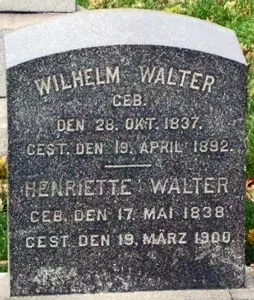
WALTER (or WALTERS), WILHELM (1837-1892). Private, 72nd New York Infantry, Company A. A native of Germany, he enlisted at New York City as a private on May 27, 1861. On June 21, he mustered into Company A of the 72nd New York from which he was discharged for disability on January 5, 1863, at Point Lookout, Maryland. He last lived on Willett Street in Brooklyn. Section 115, lot 21201.
WALTERS, CHARLES H. (1839-1862). Private, 9th New York Infantry, Company A. A native of New York, he enlisted as a private at New York City on April 23, 1861, and mustered into the 9th New York on May 4. After being wounded in battle at River Bridge, North Carolina, on April 19, 1862, he died at Fortress Monroe, Virginia, the next month on May 12, and was interred at Green-Wood on May 25. Section 116, lot 9895, grave 40.
WALTERS, ERNEST (1838-1876). Musician, 178th New York Infantry, Companies K and A. Originally from Germany, he enlisted as a private at New York City, mustered into Company K of the 178th New York, and transferred within the regiment to Company A before he mustered out as a musician. His last address was 277 Seventh Avenue in Manhattan. Section 114, lot 8999, grave 870.
WALTERS, FRANCIS B. B. (1834-1874). Private, 158th New York Infantry, Company F. A Brooklyn native, he enlisted there on September 6, 1862, mustered immediately into the 158th New York, and was discharged on June 3, 1865, at Washington, D.C. He last lived in Plainfield, New Jersey, where he succumbed to consumption. Section 71, lot 23.
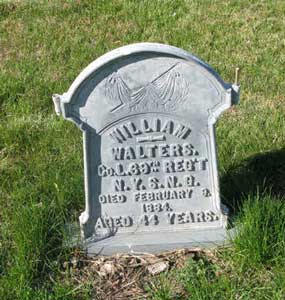
WALTERS, WILLIAM (1840-1884). Private, 69th Regiment, New York State National Guard, Company L. Walters served for three months with the 69th Regiment in 1864. Section 2, lot 5499.
WALTHER, AUGUST (1832-1911). Private, 15th New York Heavy Artillery, Company E. Originally from Frankfort, Germany, he immigrated to the United States in 1850. During the Civil War, Walther enlisted at New York City as a private on January 22, 1864, mustered immediately into the 15th Heavy Artillery, and mustered out on August 22, 1865, at Washington, D.C. As per his obituary in the Brooklyn Daily Eagle, he was a produce broker who retired from the New York Produce Exchange in 1891. He last resided at 539 Washington Avenue in Brooklyn where he lived for more than forty years. Section 113, lot 10720, grave 5.
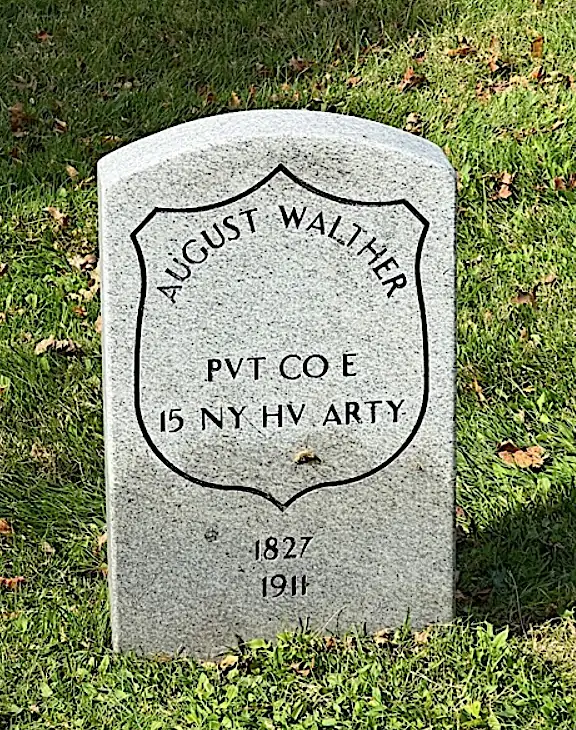
WALTHER, JACOB (1825-1914). Private, 15th New York Heavy Artillery, Company I. After Walther enlisted as a private on February 27, 1864, at Fort Lyon, Virginia, he served with the 15th Heavy Artillery. He was awarded an invalid pension in 1891, certificate 899,467. Shortly after his death in 1914, his wife applied for and was granted a widow’s pension, certificate 785,134. Section 16, lot 14888.
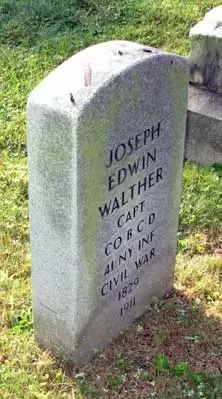
WALTHER (or WALTER), JOSEPH EDWIN (1829-1911). Captain, 41st New York Infantry, Companies C, B, and D. At age 32, Massachusetts-born Walther enlisted at New York City as a sergeant, and mustered into Company C of the 41st New York on June 6, 1861. He rose to the rank of second lieutenant on August 30, 1862, and was transferred two days later to Company B. On February 13, 1863, he became a first lieutenant and on March 1 of that year was transferred back to Company C. After he was wounded at the Battle of Gettysburg, Pennsylvania, he was subsequently transferred to Company D on November 1, 1863, promoted to captain on November 20, 1863, and discharged for disability on March 21, 1864. In 1864, his application for an invalid pension was granted, certificate 82,265. His last residence was in Elizabeth, New Jersey. His death was caused by pericarditis. Section 66, lot 3281.
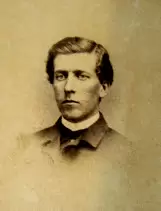
WALTON, CHARLES W. (1843-1897). Captain, 51st New York Infantry, Companies B, D, and E. Born in Norwalk, Connecticut, he enlisted at New York City on September 23, 1861, as a private, and mustered into Company B of the 51st New York on October 18. The 51st Regiment was part of the Second Division, 9th Army Corps, fighting in over 20 major combat actions including New Berne, North Carolina; Antietam and South Mountain, Maryland; Bull Run, Fredericksburg, the Wilderness, Spotsylvania, and Petersburg, all in Virginia; Vicksburg, Mississippi; and the East Tennessee Campaign.
Walton rose through the ranks becoming a corporal, and was twice within enemy lines where he escaped capture. He was wounded in the head crossing the “Burnside Bridge” at Antietam, Maryland, on September 17, 1862. Governor Morgan, in a written recommendation to promote Walton to second lieutenant said, “…His untiring devotion to his duties won the esteem and respect of his officers. He has always been found at his post ready and willing for all work required of him…” After his promotion to second lieutenant of his company on September 29, 1862, he commanded his company at Fredericksburg, Virginia, in December of that year, whereupon he narrowly escaped injury with five bullet holes in his clothing and one bullet grazing his arm.
Effective upon his transfer to Company E on March 14, 1863, Walton was promoted to first lieutenant. New York’s Governor Morgan praised him upon his promotion citing, “His untiring devotion to his duty won him the respect of all the officers and men of the 51st Regiment New York Volunteers.” In a letter dated January 3, 1864, to support Walton’s request for transfer, the commanding colonel “acknowledged with gratification the valuable services rendered by Lieut. Walton while serving as Aide, and takes particular pleasure in mentioning his handsome behavior at the battle of Campbell’s Station, and during the siege of Knoxville.” On April 20, 1864, he was promoted to captain (the youngest in the 9th Corps) and transferred to Company D, transferring back to Company E two days later. Walton commanded the 51st Infantry at the Battle of Poplar Springs Church, Virginia, from September 29-October 2, 1864, in which 344 men from the regiment were killed, wounded, or missing. He was discharged four days later at Poplar Grove Church.
Walton was a member of the G.A.R.’s Ulysses S. Grant Post #327. In 1883, his application for an invalid pension was granted for disability resulting from a “gunshot wound of the scalp” at Antietam, certificate 258,140. He was in command of the honor guard for President Ulysses S. Grant’s funeral ceremonies when he lay in state at the New York State Capitol Building in Albany on August 7, 1884. While his last residence was at 132 Fort Greene Place, Brooklyn, Walton died at the Middletown State Hospital in Middletown, New York. Section 171, lot 12752, grave 10.

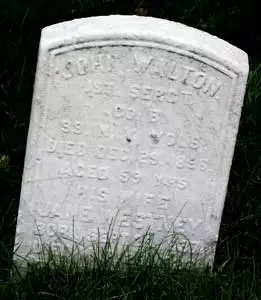
WALTON, JOHN (1838-1896). Sergeant, 99th New York Infantry, Companies K, C, and B. Walton enlisted and mustered into Company K on January 30, 1862, at Boston, Massachusetts, as a private. He was promoted to corporal, then sergeant on August 1, 1863, served as a sergeant in Company C, and was transferred to Company B on September 20, 1864. He was discharged on January 28, 1865, at New Berne, North Carolina. Walton’s death was caused by mitral regurgitation. Section 135, lot 14964, grave 711.
WALTON, JOHN W. (1840-1907). Private, 84th New York (14th Brooklyn) Infantry, Company H; 5th New York Veteran Infantry, Company K. Born in London, England, he enlisted at Brooklyn on September 4, 1862, and two days later, mustered into the 14th. He was listed as a prisoner of war on July 1, 1863, at Gettysburg, Pennsylvania. Walton transferred out on June 2, 1864, mustered into the 5th New York Veteran Infantry that day, and was discharged in 1865. At the time of his death, he was a resident of Freeport, Long Island. In 1907, Emma P. Walton, who is interred with him, applied for and received a widow’s pension, certificate 630,258. Section 7, lot 9819.
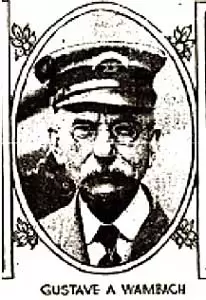
WAMBACH, GUSTAV (or GUSTAVE) ALBRECHT (1844-1931). Rank unknown, 71st Regiment, New York State National Guard. According to a descendant, Wambach immigrated to the United States from Germany when his parents fled the Franco-Prussian Wars. At about the age of 12, he was orphaned and raised by an older sister. According to records from his Masonic Lodge, he served in the 71st National Guard during the Civil War, was wounded at Appomattox, Virginia, and remained with the 71st until 1878, when he was discharged with the rank of first sergeant. No other details of his wartime service are known; however, there may be some confusion because the 71st was not in service in 1865 when the fighting at Appomattox occurred. His service cannot be confirmed by pension records, although there is a blank paper with his name and address written on it in government pension files.
On October 18, 1865, Wambach became a naturalized citizen. In 1866, he became a postmaster on Governor’s Island. An article in the New York Evening Telegram on July 12, 1920, “Octogenarian New York Employees Prove Uncle Sam Poor Judge of Ousting Workers at 70,” celebrated nine civil servants who had served the same employer for half a century. That piece included Wambach and confirmed that he was a letter carrier in the Wall Street-Battery Park area for almost 54 years and stated that he exemplified “regular habits and careful living” and enjoyed excellent health. His family notes that he met President Grant at an event at the Union League Club of New York where he worked as a steward as a youth. It was there that Wambach was presented with a 13-star flag of the United States that was displayed in the room and that remains a cherished family heirloom today. He was active in the Joppa Lodge, a Masonic organization in Brooklyn where he organized a drill team in 1906 after bringing twenty-one non-commissioned officers into the organization. He was also the chaplain of that lodge for 25 years beginning in 1903.
As per his obituary in the Brooklyn Daily Eagle, Wambach was most likely the oldest retired postman. He had been the treasurer of the National Association of Civil Service Employees, and a member of the National Association of Letter Carriers. Prior to his wife’s death in 1921, they had been married for 54 years. Wambach’s death was noted in the records of the Joppa Lodge. That citation reiterated his injury during the Civil War and the anecdote about the American flag. He last lived at 52 86th Street in Brooklyn. Section 204, lot 29672.
WANGNER, THEOPHILE (1839-1867). Captain, 41st New York Infantry, Companies K and G. Of German origin, Wangner enlisted at New York City as a private on June 6, 1861, the same day that he mustered into Company K of the 41st New York. On August 10, 1861, he was promoted to sergeant of his company and became sergeant major on March 7, 1862, when he was transferred to 41st’s Field and Staff. When he was promoted to second lieutenant on September 29, 1862, he returned to Company K. On January 1, 1863, he was promoted to adjutant and remained with his company. On January 29, 1864, he was promoted to captain, and transferred to Company G. He was discharged on May 9, 1864, at New York City. On October 19, 1864, he became a naturalized citizen and was employed as a clerk. His last residence was 357 8th Avenue in Manhattan. Section 121, lot 11189, grave 131.
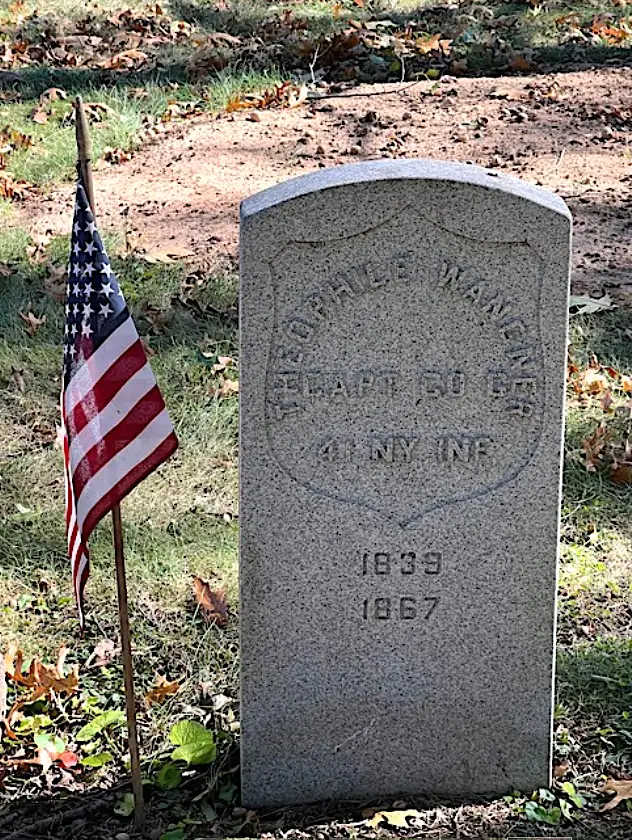
WARD, CORNELIUS S. (1825-1863). Major, 81st Illinois Infantry, Company D. A native of New York State and a resident of Murphysboro, Illinois, he enlisted as a captain on August 12, 1862, and was commissioned into Company D of the 81st Illinois on August 26. He re-enlisted in the 81st as major on May 22, 1863, and was commissioned that day. After he was wounded in battle at an unspecified place and time (it may have been the first general assault on Vicksburg, Mississippi), Ward died of wounds on June 17, 1863, and was interred at Green-Wood seven days later. Section 83, lot 1134.
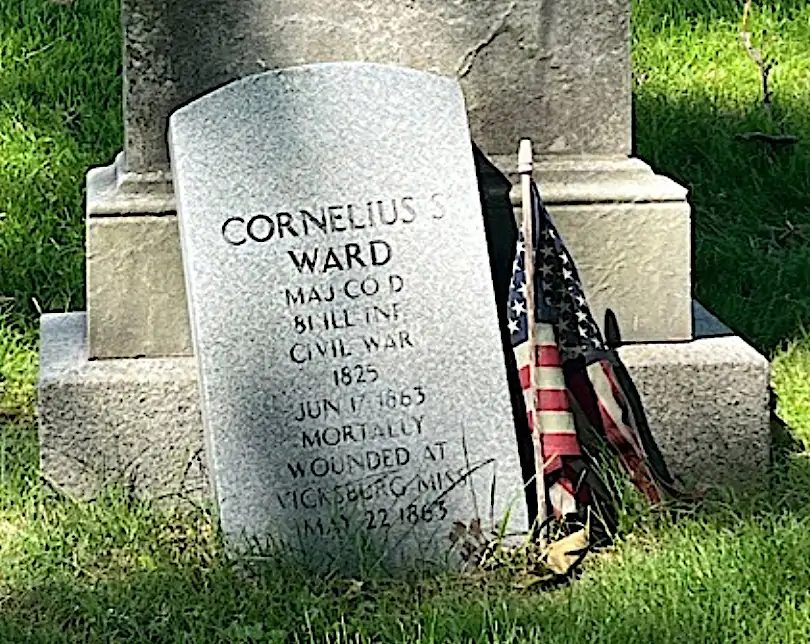
WARD, GEORGE BLANCHARD (1847-1921). Rank unknown, 23rd Regiment, New York State National Guard, Company B. Ward was born in New York. As per his obituary in the Seventh Regiment Gazette, he enlisted on March 1, 1865, and mustered into Company B of the 23rd Regiment. He was transferred into Company B of the 7th Regiment on May 4, 1868. He was then commissioned lieutenant of Company G of the 23rd Regiment, New York State National Guard, on December 2, 1870. He resigned his commission on July 12, 1872.
According to the census of 1900, he lived at 261 Union Street in Hackensack, New Jersey, with his wife Cornelia, whom he married in 1877, and daughter; he was employed as a telephone clerk. The New Jersey State census for 1915 notes that he lived with his wife in a rental in Hackensack. The 1920 census reports that he lived with his wife on Linden Street in Hackensack and was retired. He last lived in Hackensack, New Jersey. His death was announced in the Seventh Regiment Gazette. His funeral took place at the Christ Presbyterian Church in Hackensack.
WARD, GEORGE HENRY (1836-1899). Private, 10th New York Infantry, Company A; 5th New York Heavy Artillery, Company C. Born in New York City, he enlisted on April 26, 1861, and mustered into the 10th New York the next day. As per his muster roll, he was a carpenter who was 5′ 5” tall with grey eyes, black hair and a fair complexion. After being taken as a prisoner of war on an unknown date and place, he was paroled. He was wounded on June 27, 1862, at Gaines’ Mill, Virginia, and mustered out on May 6, 1863, at New York City. On December 19, 1863, he mustered into the 5th New York Heavy Artillery. Although his muster roll notes that he deserted in June 1864, at Martinsburg, Virginia, he was recorded as “present” on the muster roll in October 1864. He mustered out on June 13, 1865, at Harpers Ferry, West Virginia. His last residence was on 9th Avenue in Manhattan; his death was caused by pneumonia. In 1901, Caroline Ward’s application for a widow’s pension was granted, certificate 514,589. Section 181, lot10969, grave 3.
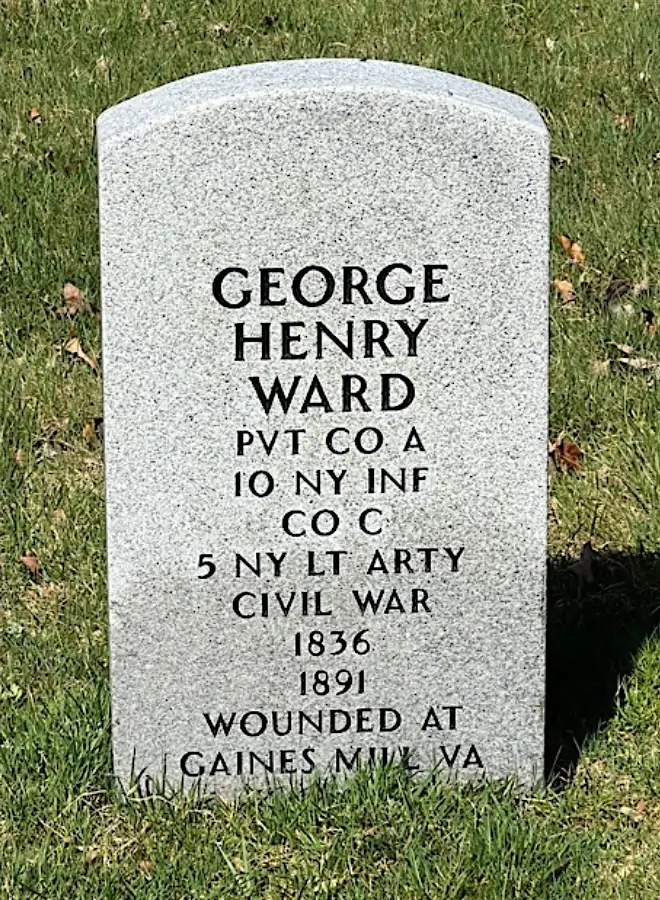
WARD, JOHN (1839-1899). Landsman, United States Navy. Irish-born, Ward enlisted in the United States Navy on May 31, 1856, and served until March 12, 1860, then re-enlisted the next day. He was 5′ 7″ tall, with grey eyes, brown hair and a fair complexion. He served on board the USS North Carolina until March 20, 1861, and then was aboard the Seminole. On July 16, 1861, while on the Seminole, he contracted pneumonia and was transferred to the Princeton, a receiving ship, on July 25. After he was examined by the medical staff on July 27, records indicate that he had rheumatism and liniments were applied to his limbs. He was discharged by order of the Secretary of the Navy at Philadelphia, Pennsylvania, on July 29, 1861, for disability citing an ulcerated right leg, asthma, and heart palpitations.
In civilian life, Ward was a grocer. In 1890, he applied for and received an invalid pension of $8 per month citing disability in left pleura, right leg and poor eyesight, certificate 11,519. A member of the G.A.R., his last residence was 424 East 15th Street in Brooklyn. In 1904, his second wife, Mary Millerick-Ward, received a widow’s pension, declaring that she owned no property or real estate and supported herself by keeping a small candy store, certificate 13,666. Section 13, lot 19694, grave 328.
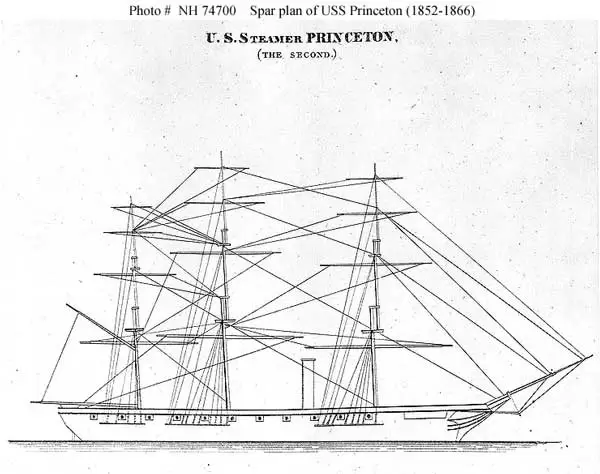
WARD, JOSEPH H. (1846-1909). Private, 6th New York Cavalry, Company A. After enlisting as a private at New York City, his birthplace, on August 21, 1862, Ward mustered into the 6th New York Cavalry. He mustered out on June 5, 1865, at Cloud’s Mills, Virginia. In 1866, his application for an invalid pension was approved, certificate 78,186. He last lived at 953 DeKalb Avenue in Brooklyn. Section 58, lot 1986.
WARD, WILLIAM GREENE (1832-1901). Colonel, 12th Regiment, New York State National Guard. Grandson of Revolutionary War Lieutenant Colonel Samuel Ward, William Greene Ward, who was born in New York City, was a banker and graduate of Columbia College, class of 1851, and New York University Law School. He joined the 12th New York State Militia as its lieutenant colonel on April 19 and served through August 4, 1861. On May 31, 1862, he returned to service with the 12th New York National Guard as its colonel. Ward was captured during the fighting at Harpers Ferry, (now West Virginia), on September 14 and paroled the next day. He mustered out on October 8, 1862. He later served with Dana’s Division and Couch’s Corps in Pennsylvania in 1863.
Ward was one of the inventors of the Ward-Burton breech-loading rifle, which was more efficient than muzzle-loaders. Magazine breech loaders could have provided the North with a tremendous advantage but they weren’t widely issued. According to his obituary in the Daily Standard Union, he was a banker whose firm bore his name, Ward and Co. A brigadier general of the New York National Guard from 1866 to 1886, he was also president of the New York State Society of the Cincinnati. In addition, he remained active in his college fraternity, Delta Psi.
As per an article in the Brooklyn Daily Eagle on October 9, 1942, Ward owned a large mansion in Grymes Hill in Staten Island that was built in 1867, where it was the site of many social gatherings. The house was placed on the auction block by the heirs of his maiden daughter who died there in 1942; many of the original furnishings were still intact then. That same article noted that Ward served under Grant in the Civil War and was subsequently his banking partner. He last resided at 351 Lexington Avenue in Manhattan. His death was attributed to nephritis. Section 77, lot 72.

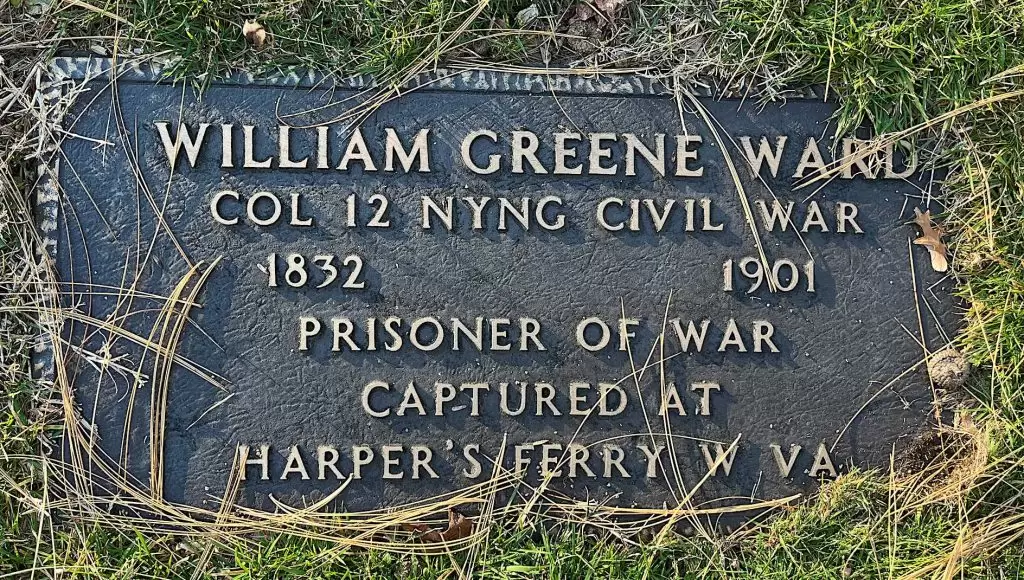
WARE, ADOLPHUS H. (1847-1876). Private, Captain Richards’ Company, Mississippi Light Artillery (Madison Light Artillery), Company A, Confederate States of America. A student, age 16, and resident of Sharon, Mississippi, Ware enlisted as a private on May 23, 1863, for a period of three years at Canton, Mississippi. A Mississippi native, he mustered into Company A, Captain Richards’ Company, Mississippi Light Artillery (Madison Light Artillery), serving the duration of the War, and taking part in the Battle of Bristoe Station, Virginia, on October 14, 1863.
The Madison Mississippi Light Artillery was first organized in 1861 at Canton, was composed of men from the area, and was ordered to Virginia. In May 1863, the battery was part of Poague’s Artillery, the Army of Northern Virginia, and engaged at Gettysburg, Pennsylvania, then in Virginia at Cold Harbor and Petersburg. Ware’s company fought at the Wilderness in 1864, and was exposed to heavy fire at Cold Harbor on June 3, 1864, where many lives were lost. “Richard’s pieces were with much difficulty gotten back to the works occupied by the infantry. They were there, however, used with some effect, as the enemy attempted to advance, the cannoneers being to some extent protected.” Ware’s paperwork indicates that he was detailed and not present at the Battle of Gettysburg and at the Battles of Wilderness, Spotsylvania, and Cold Harbor, Virginia, when he was detailed as an ordnance sergeant. After taking an oath of allegiance, he was paroled at Appomattox Court House, Virginia, on April 9, 1865. He died at Bellevue Hospital in Manhattan. Section 15, lot 17263, grave 1976.
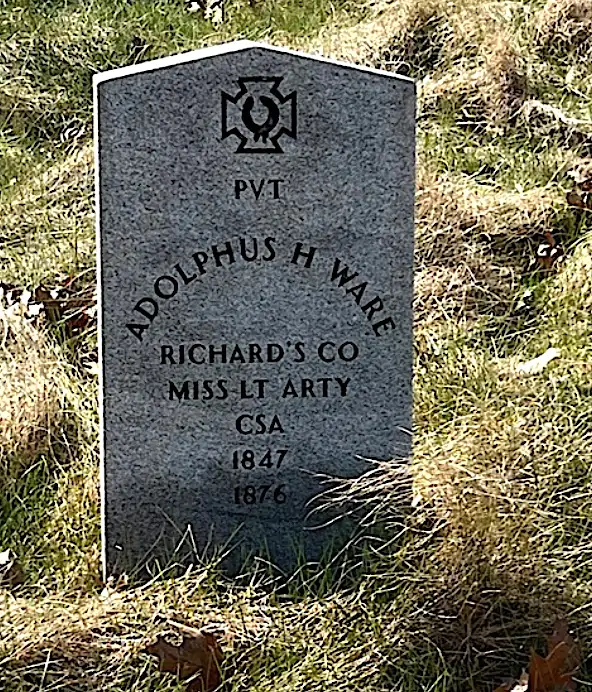
WARES, WILLIAM (1841-1904). Private, 79th New York Infantry, Company C. A native of Edinborough, Scotland, Wares enlisted as a private at New York City on May 13, 1861, mustered into Company C of the 79th New York on May 28, and mustered out on July 14, 1865, at Alexandria, Virginia.
Wares was a plumber by trade. In 1902, his application for an invalid pension was approved, certificate 1,045,681. Wares died of nephritis. His wife applied for and was granted a widow’s pension, certificate 583,272. A great granddaughter of Wares married the grandson of Edwin Forrest Van Wart (see). He last lived at 879 Home Street in New York City. Section 13, lot 19694, grave 365.
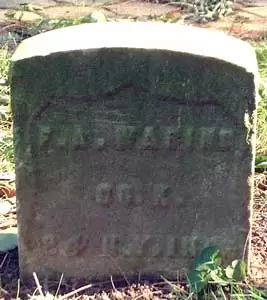
WARING (or WARRING), FRED (or FREDERICK) A. (1843-1906). Private, 84th New York (14th Brooklyn) Infantry, Company K; 5th New York Veteran Infantry, Company K. During his military service, he enlisted at Brooklyn, his birthplace, on June 30, 1861, and mustered into the 14th Brooklyn on August 1, 1861. As per an article in the New York Daily Tribune on September 17, 1863, Waring was being held as a deserter. His uncle, Nathaniel Waring, testified in the United States District Court that his nephew was underage at the time of his enlistment, did not have the permission of his parents to serve, and was entitled to be discharged. However, because President Lincoln had suspended the right of habeas corpus during wartime, the court ruled against Waring and he was kept in service. Waring was subsequently transferred into the 5th New York Veteran Infantry on June 2, 1864. He last lived at 212 Warburton Avenue in Yonkers, New York. His widow, Sarah Waring, applied for a pension, application 947,620. Section 67, lot 1396, grave 4.
WARNER, BENJAMIN JOHN (1820-1909). Private, 47th New York Infantry. Born in London, England, he belonged to the Polytechnic Institute there before coming to the United States in 1845. His New York Times obituary states that he served in the 47th New York during the Civil War. Further details about his service are unknown.
A watch manufacturer, Warner is said to have originated the art of colored photo-engraving on the inside of watch cases. His obituary also notes that he conceived the idea of a tunnel under the East River as early as 1883 that would serve as a pedestrian walkway between Brooklyn and Manhattan. That vision did not consider cars traversing the tunnel. Warner’s last residence was 81 Morton Avenue, Brooklyn. Section 202, lot 29040, graves 1 and 2.
WARNER, CHARLES L. (1840-1872). Second lieutenant, 145th New York Infantry, Company F. A New Yorker by birth, he enlisted there as a second lieutenant on August 19, 1862, was commissioned into the 145th New York on September 11, and mustered out on January 6, 1864. His last residence was 107 7th Avenue in Manhattan. Warner’s death was caused by obstruction of the bowels. Section 69, lot 2034.
WARNER, CHRISTIAN H. (1827-1869). Private, 49th New York Infantry, Company D. A New York native, Warner enlisted as a private at Buffalo, New York, on August 22, 1861, and mustered into the 49th New York six days later. Subsequently, he was transferred to the gunboat Mound City in the Mississippi River in 1862 or 1863. He last lived in Jersey City, New Jersey. Section 122, lot 17806, grave 30.
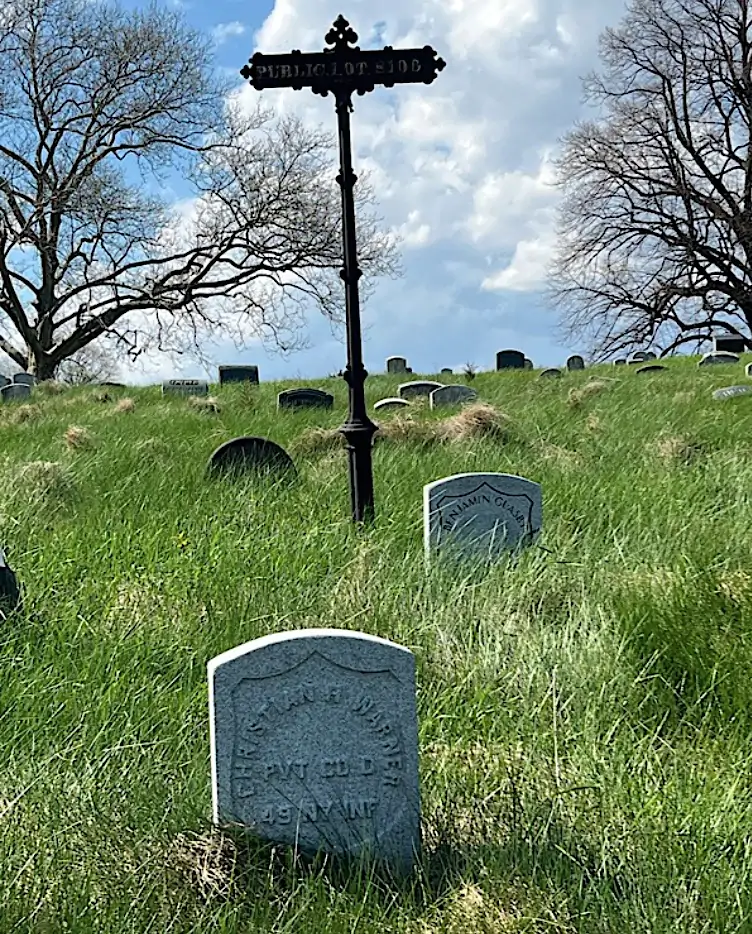
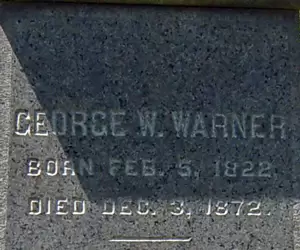
WARNER, GEORGE W. (1822-1872). Major, 170th New York Infantry; captain and adjutant, 15th New York Engineers, Company I; quartermaster, 11th New York Infantry; 17th New York Infantry. Warner, who was born in New Jersey, enlisted as a captain at Willets Point, New York, on June 17, 1861, was commissioned into the 15th Engineers that day, was an adjutant at some point, and resigned on December 19. He re-enlisted as a first lieutenant at New York City on October 7, 1862, was immediately commissioned into the 170th Infantry, was promoted to major on September 24, 1862, and was discharged on April 8, 1863. He re-enlisted on May 18, 1863, at New York City, and was commissioned into the 11th New York the next day as a quartermaster. When the 11th and 17th New York Infantries were consolidated on October 1, 1863, he was commissioned into the 17th. He last lived in South Amboy, New Jersey. He succumbed to myocarditis. Section 162, lot 15544.
WARNER, GEORGE W. (1848-1910). Musician, 1st New York Engineers, Company L. Warner enlisted at Brooklyn as a private on February 25, 1864, the same date that he mustered into the 1st New York Engineers. He was promoted to musician before he mustered out on June 30, 1865, at Richmond, Virginia. In 1891, his application for an invalid pension was approved under certificate 813,726. His last residence was 255 Lincoln Avenue in Ridgewood, New Jersey. Shortly after his death from apoplexy in 1910, his wife applied for and received a widow’s pension, certificate 703,829. Section 163, lot 15650.
WARNOCK, ROBERT A. (1842-1870). Commissary sergeant, 16th New York Infantry, Company D. Warnock, who was born in New York State, enlisted as a private at Washington, D.C., on July 1, 1861, and mustered into the 16th New York the same day. On July 5, 1861, he was promoted to commissary sergeant, and mustered out of service on May 22, 1863, at Albany, New York. His last residence was in Nevada. Section 33, lot 4986.
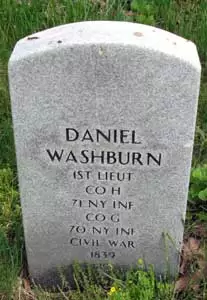
WASHBURN, DANIEL (1839-1891). First lieutenant, 70th New York Infantry, Company G; private, 71st Regiment, New York State Militia, Company H; paymaster’s steward, United States Navy. A Brooklyn native, Washburn enlisted there as a first lieutenant on June 27, 1861, mustered into Company G of the 70th New York, known as the 1st Excelsior, and resigned at Washington, D.C., on August 8. He re-enlisted at New York City as a private on May 28, 1862, mustered into the 71st New York State Militia, and mustered out after three months at New York City on September 2.
When Washburn re-enlisted on February 14, 1863, he entered service as a landsman in the Navy. He was appointed paymaster’s clerk aboard the USS North Carolina, was transferred on October 14, 1863, to the USS Fort Jackson, where he was appointed paymaster’s steward, and served until his discharge on April 30, 1864, at New York City. Washburn belonged to the Henry M. Lee Post #21 of the G.A.R. Most likely, he was the brother of George Washburn (see). Section 43, lot 338.
WASHBURN, GEORGE W. (1835-1901). Private, 83rd New York Infantry, Company G. Born in New York, he enlisted and mustered into the 83rd at New York City on May 27, 1861. He was wounded at Fredericksburg, Virginia, on December 13, 1862, and mustered out after serving three years on June 23, 1864, at New York City. He was likely the brother of Daniel Washburn (see). He last lived at 22 West 16th Street in Manhattan. Washburn died of heart disease. Section 43, lot 338.
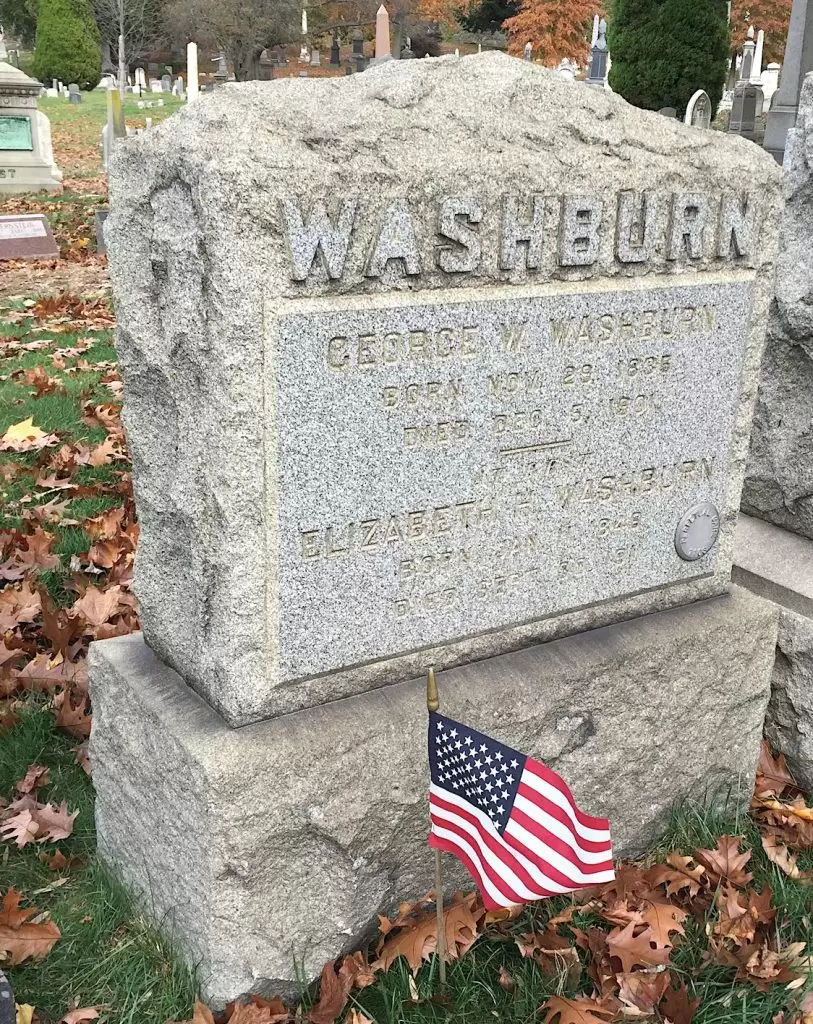
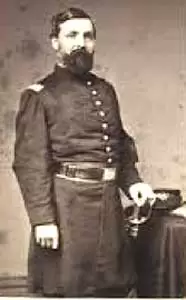
WASHBURN, HENRY ALBEMARLE (1822-1890). Captain, 23rd Regiment, New York State Militia. Born in Norwich, Connecticut, Washburn served in the 23rd New York State Militia. The details of his service are not known.
As per his obituary in the Brooklyn Daily Eagle, he was a dry goods merchant in Brooklyn. That obituary confirms his Civil War service and indicates that he was a member of the Veterans’ Association and the Officers’ Association of the 23rd Regiment. He last lived at 542 Pacific Street in Brooklyn. Section 60, lot 17513.
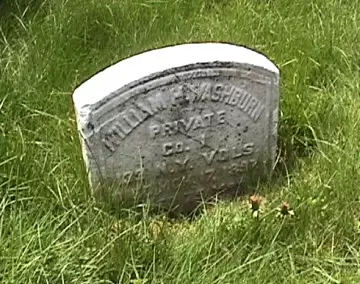
WASHBURN, WILLIAM H. (1822-1897). Private, 139th New York Infantry, Company K. Originally from West Farms, New York, Washburn enlisted at Brooklyn on August 26, 1862, mustered into the 139th New York on September 9, and mustered out on June 30, 1865, at Hart’s Island, New York Harbor.
On May 1, 1873, he became a member of the G.A.R. His application for an invalid pension was approved in 1879, certificate 436,226. His pension record indicates that he also served in Company E of the 95th New York but there are no details related to that service. As per his obituary in the Brooklyn Daily Eagle, which confirmed his Civil War service, Washburn belonged to the Thatford Post #3 of the G.A.R. and the Union Veterans Legion.
A carpenter by trade, he did much of his work in the neighborhood where he lived and was in the hardware business at the time of his death. He last resided at 426 18th Street in Brooklyn, his home for twenty-six years. Elizabeth Washburn, who is interred with him, applied for and was awarded a widow’s pension in 1897, certificate 502,672. Section 205, lot 27562, grave 2.
WASHINGTON, GEORGE (1844-1897). Cook, 23rd New York Cavalry, Company B. A resident of New York, Washington enlisted as a cook at Newport Barracks, New York, on November 23, 1863, and immediately mustered into the 23rd New York Cavalry from which he mustered out on July 22, 1865, at Raleigh, North Carolina. He last lived on West 85th Street in Manhattan. His death was caused by influenza. Section 184, lot 25554.
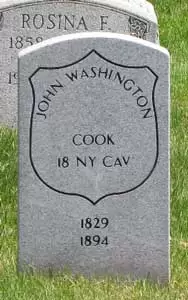
WASHINGTON, JOHN (or GEORGE) (1829-1894). Cook, 18th New York Cavalry, Company H. He enlisted on January 4, 1864, at Troy, New York, as a colored cook, and mustered into the 18th New York Cavalry on October 4, 1864. Other details of his service are not known. Section 135, lot 27263, grave 1016.
WASMUTH, JOHN C. (or JOHANNES CASTBERG HOLMBOE) (enlisted as CASEY, JAMES) (1842-1912). Seaman, United States Navy. Originally from Tromso, Norway, Wasmuth immigrated to the United States in 1859. He enlisted in the United States Navy as a seaman under the name James Casey on July 9, 1864, for a three year term. During his service, he was a marine soldier on board the USS North Carolina, Brandywine, and the Saugus. He was also assigned to a special Naval Guard Unit at the Navy Yard in Washington, D.C. In January 1865, while on the USS North Carolina, a big gun exploded blowing him through the main deck into the ship’s engine room. He was knocked unconscious for eleven days. On July 31, 1865, he was discharged for disability at the Washington Navy Yard.
Wasmuth returned to Tromso, Norway, after the War and returned to the United States in 1911. He was awarded a pension from the Navy in 1907, certificate 20,424. At the time of his pension application, he was 5′ 10″ tall with fair skin, hazel eyes, grey hair, and employed as a sailor. His last residence was 448 63rd Street in Brooklyn. Section 85, lot 32200, grave 42.
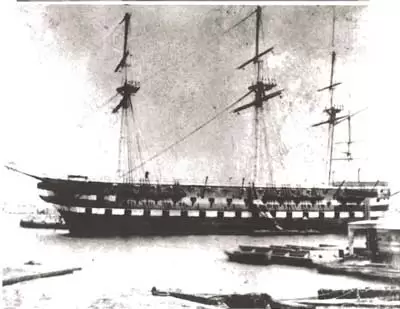
WASSWEILER, OTTO FERDINAND CHRISTIAN (1843-1910). Private, 16th New York Cavalry, Company I; 3rd New York Provisional Cavalry, Company E. Wassweiler was born in St. Johann in Saarbrucken, Germany. He immigrated to the United States in 1852, as per the 1900 census. During the Civil War, he enlisted as a private at New York City on November 22, 1864, and mustered immediately into Company I of the 16th New York Cavalry. After the assassination of President Abraham Lincoln, a detachment of the 16th New York was involved in searching for the assassins; others were detached to Lincoln Barracks at Lafayette Park, across from the White House. The 16th Cavalry escorted the slain President’s funeral procession in Washington, D.C., on April 17, the largest mounted unit in the convoy. On May 23, 1865, the 16th Cavalry and the 2nd Massachusetts participated in the Grand Review of Armies in the nation’s capital; the 16th had a place of honor for capturing John Wilkes Booth, Lincoln’s assassin. On August 17, 1865, Wassweiler transferred into Company E of the 3rd New York Provisional Cavalry before he mustered out the next month on September 21, 1865, at Camp Barry in Washington, D.C.
In 1867, Wassweiler married Ermelia Ernst. As per the 1877 Brooklyn Directory, he was employed as a decorative house painter. The Brooklyn Directory for 1888-1890 lists Wassweiler as a painter; he then lived at 969 Fourth Avenue in Brooklyn. The Veterans Census of 1890 confirms his Civil War service. On June 10, 1891, he married Emma (Emily) Landwhemer in Brooklyn. The 1905 New York State census indicates that he was married, lived in Brooklyn with his wife and daughter and was still employed as a painter. He last lived in Brooklyn. Emily Wassweiler applied for and received a widow’s pension in 1910, certificate 698,485. This veteran’s service and interment were discovered when students in a high school history class in San Jose, California, studied their family trees in 2018. Section 13, lot 19694, grave 372.
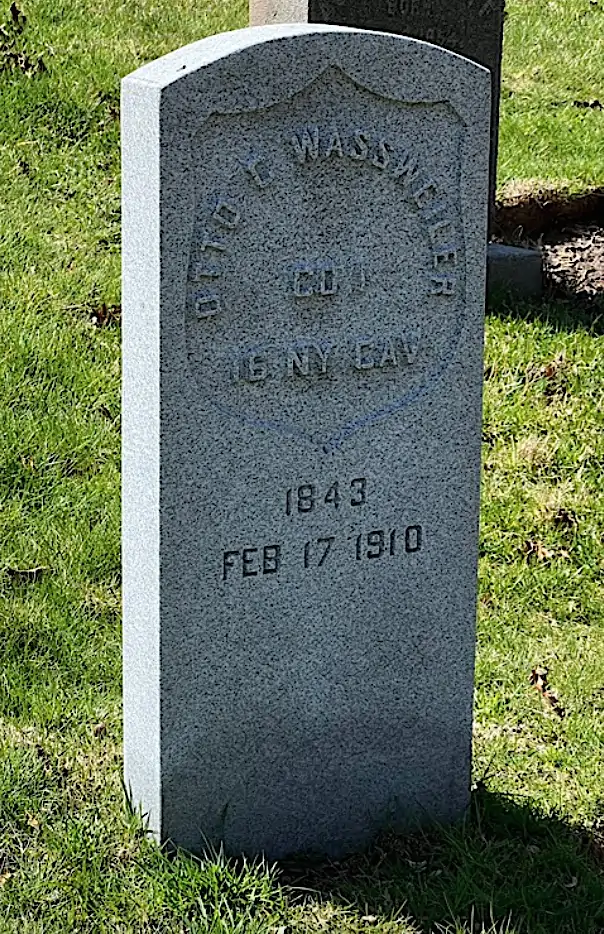
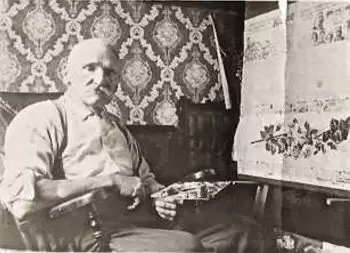
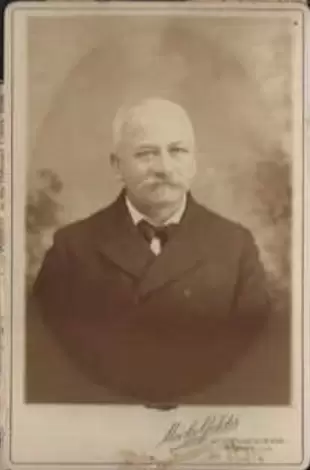
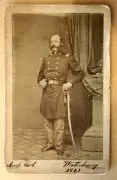
WATERBURY, CHARLES G. (1816-1885). Lieutenant colonel, 8th Regiment, New York State Militia. Originally from Greenpoint, Long Island, Waterbury made a fortune in the lumber business in New York City. As per his obituary in The New York Times, he retired from that business circa 1855 when he obtained a contract from New York City to pave the Bowery. The obituary noted that except for his service in the Union Army, he was a prominent city contractor. He laid the first Belgian block pavement in New York City, opened and graded First Avenue and graded Eighth Avenue.
During the Civil War, Waterbury raised a company for the 8th Regiment and was made its captain. He enlisted at New York City on April 23, 1861, and was commissioned into the 8th Regiment’s Field and Staff as its lieutenant colonel two days later. He mustered out on August 2, 1861, at New York City. According to the aforementioned obituary, he was at the Battle of Bull Run, Virginia, and served in the Army of the Potomac.
Returning to civilian life, he was the president of the Nicolson Pavement Company whose principal achievement was moving the Central Presbyterian Church from 19th Street and Fifth Avenue to 57th Street between Broadway and Seventh Avenue in the late 1870s. This feat was accomplished by reconstructing the edifice stone by stone. At the end of his life, Waterbury experimented with gold leaf tobacco on a plantation he had purchased in Littleton, South Carolina. He last lived at 250 West 55th Street in Manhattan. His death was attributed to cholera morbus. Section 35, lot 4461.
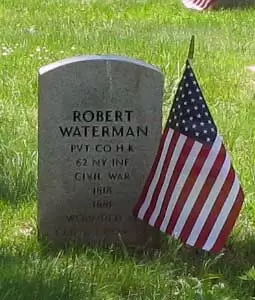
WATERMAN, ROBERT (1818-1881). Private, 62nd New York Infantry, Companies H and K. Born in New York City, he enlisted there on July 5, 1861, and mustered into Company H of the 62nd New York on August 15. On February 5, 1864, he re-enlisted and mustered into Company K of the same regiment. Waterman was severely wounded in action on October 19, 1864, at Cedar Creek, Virginia, necessitating the amputation of his right arm. He was discharged for wounds on July 27, 1865. His last residence was 130 Rail Road Avenue, Jersey City, New Jersey. He died of cancer. Section 170, lot 12732.
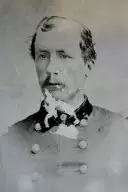
WATSON, BERIAH A. (1836-1892). Surgeon, 4th New Jersey Infantry. Born in Lake George, New York, Watson obtained his medical degree in 1861 from the University of New York. During the Civil War, he was a contract surgeon in 1862. Subsequently, he enlisted as an assistant surgeon on March 26, 1863, and was immediately commissioned into the Field and Staff of the 4th New Jersey. He was promoted to surgeon on November 25, 1864, and mustered out on July 9, 1865, at Hall’s Hill, Virginia, at which time he was surgeon in charge of the 1st Division, 6th Army Corps Hospital and medical purveyor.
Watson then settled in Jersey City, New Jersey, where he was appointed attending surgeon to the Jersey City Charity Hospital at the time of its organization in 1869. In addition, he was an attending surgeon to St. Francis Hospital beginning in 1873, and at Christ’s Hospital beginning in 1885. His efforts were instrumental in the passage of the act that legalized dissection of human cadavers in New Jersey.
Dr. Watson was a founder and president of the New Jersey Academy of Medicine and was awarded a Master’s degree from Rutgers in 1882. Among his many professional publications are: “A Case of Neuralgia treated by Extirpation of the Superior Maxillary Nerve” (1871); “Pathology and Treatment of Chronic Ulcers” (1875) ; “Cases of Rabies Canina treated with Stryehina and Woorara” (1876) ; “Disease Germs: their Origin, Nature, and Relation to Wounds” (1878): “Woorara: its Medical Properties and Availability for the Treatment of Diseases” (1882); and an “Experimental Study of Anaesthetics,” (1884). He translated medical essays from the French and German, and wrote two books, Amputations and their Complications (Philadelphia, 1885) and The Sportsman’s Paradise, on the Lake Lands of Canada (1888), and contributed the chapter on “Pyaemia and Septicaemia” to Practical Medicine, edited by Dr. William Pepper (Philadelphia, 1885).
However, Watson’s career and reputation were marred by controversy. According to articles in the Buffalo Courier and the Brooklyn Daily Eagle on June 5, 1886, he was arraigned and charged with cruelty to animals. When the second floor of his Jersey City carriage house was searched, there was a pen holding six dogs. Carcasses of dogs and dissected dog spines were also on display. He apparently experimented on the animals from February 9 through May 31, 1886, using cruel methods that subjected the dogs to spinal contusions by dropping them 30 feet from a harness while under anesthesia; dogs that did not recover were not fed. The story in the Brooklyn Daily Eagle stated that 41 dogs, all numbered, were subjects of the experiments and that the paperwork was obtained by the New Jersey Society for the Prevention of Cruelty to Animals. Watson was charged with 31 civil suits each carrying a $100 fine. His coachman was also placed under arrest as a witness. Watson, an expert surgeon in the employ of the Pennsylvania Railroad Company, claimed that the experiments were necessary to parallel the effects of spine injuries on humans who sued the railroad claiming that they lost vitality months after their injuries. Some of the animals suffered broken legs, torn arteries, and ruptured organs; criminal charges were being considered. His last residence was in Jersey City, New Jersey. He was survived by his wife and a daughter; his son died at age eight in 1890. In 1910, Phebe Ann Traphagen Watson, who is interred with him and whom he married in 1868, applied for and received a widow’s pension, certificate 737,806. He died of diabetes. Section 119, lot 27084.
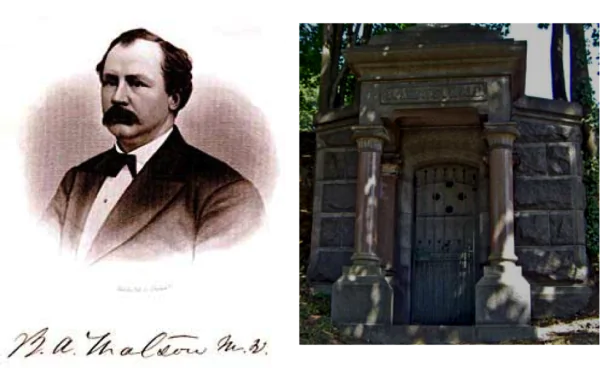
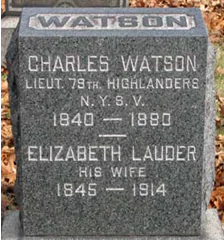
WATSON, CHARLES (1840-1880). First lieutenant, 79th New York Infantry, Companies C and I. Originally from Scotland, Watson enlisted as a corporal at New York City on July 13, 1861, and mustered into Company C of the 79th New York, known familiarly as the Highlanders, two weeks later. He was promoted to sergeant of his company at some point before he was commissioned into Company I of the same regiment as a second lieutenant on January 13, 1863. Watson returned to Company C as a first lieutenant on February 24. On November 25, 1863, he was wounded in action at Knoxville, Tennessee, and was discharged on May 31, 1864, at New York City. His last residence was 85 7th Street in New York City. In 1880, Elizabeth Watson’s application for a widow’s pension was granted, certificate 233,367. Section 1, lot 15214.
WATSON, CHRISTOPHER (1838-1869). Corporal, 56th Regiment, New York State National Guard, Company B. Of Irish birth, Watson served for 30 days in 1863 when the 56th National Guard was activated. He last lived in Manhattan. Section 121, lot 11189, grave 63.
WATSON, JAMES H. (1841-1862). Unknown soldier history. Watson died on November 17, 1862, of wounds received in battle at Suffolk, Virginia. Details of his service are unknown. Section 200, lot 25260.
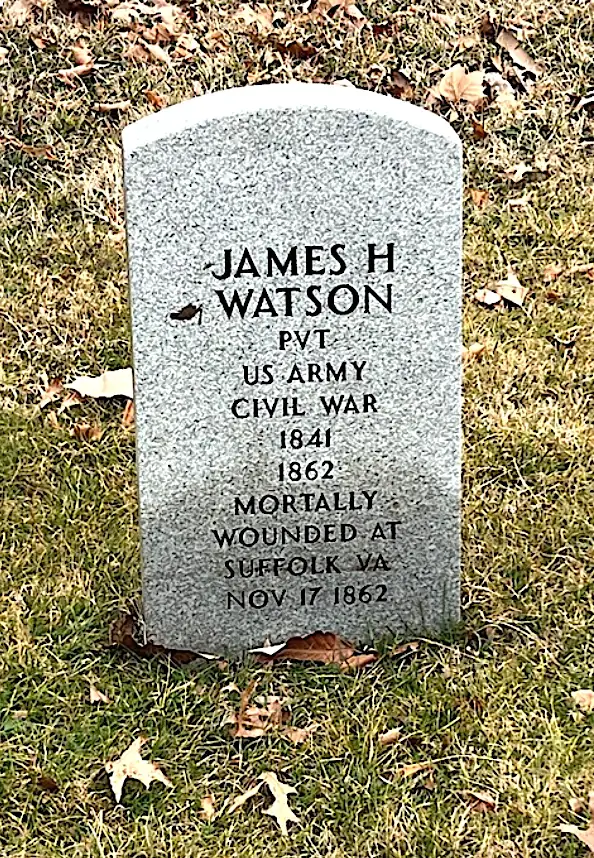
WATSON, JAMES HOLMES (or HOLMS) (1838-1862). Sergeant, 9th New York Infantry, Company A; unknown rank, 71st New York State Militia. Watson was born in New York City. As per an inscription on his gravestone, “at the first call of his country he enlisted in the 71st Regt. and was in the battle of Bull Run.” Apparently, after that service, Watson re-enlisted as a private at New York City on September 2, 1861, mustered directly into the 9th New York, was promoted to corporal on October 14, 1861, and rose to sergeant on January 19, 1862. He was killed in action on September 17, 1862, at the Battle of Antietam, Maryland, and originally buried at its National Cemetery, gravesite 747.
A handwritten “Final Statement” written by his captain, Andrew Graham, notes that Watson, who was a clerk in civilian life, was 5′ 9″ tall with blue eyes, brown hair and a fair complexion. The note went on to say that he was owed $54 by the government for his service. Watson’s family subsequently claimed his remains from Antietam and he was re-interred at Green-Wood on December 7, 1862. His gravestone confirms that he was “killed on the field of Antietam.” Section 33, lot 4194.
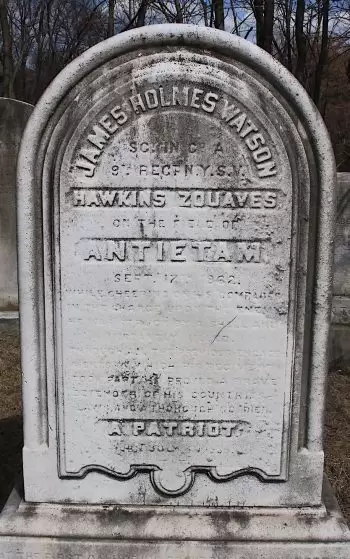

His cenotaph at Green-Wood is inscribed in part as follows:
JAMES HOLMES WATSON
SGT. OF CO. A
9TH REGT. N.Y.S.V.
HAWKINS ZOUAVES
ON THE FIELD OF
ANTIETAM
SEPT. 17TH 1862
WHILE CHEERING ON HIS COMRADES
IN THE CHARGE UPON THE ENEMY
HE WAS STRUCK BY A SHELL AND
INSTANTLY KILLED
THROUGH ALL THE PREVIOUS ENGAGE-
MENTS IN WHICH HIS REGIMENT
TOOK PART . . . PROVEN A BRAVE
DEFENDER OF HIS COUNTRIES (SIC)
LAWS AND A THOROUGH SOLDIER.
A PATRIOT
WATSON, JOHN STOUGHTON (1826-1911). Captain, United States Navy. Born in Northampton, Massachusetts, the son of a paymaster in the United States Navy, he attended Phillips Exeter Academy, class of 1839. He served in the Navy during the Civil War, attaining the rank of captain. His brother, Eugene Winslow Watson, also joined the Navy during the Civil War and attained the post of rear admiral. He may have been the John S. Watson who entered the Navy as an acting master on September 9, 1861, became an acting volunteer lieutenant on August 7, 1865, and was honorably discharged on October 21, 1866. This man served on the USS Shenandoah as part of the Northeast Squadron. Or, he might have been the John S. Watson who became an acting master on November 17, 1863, an acting volunteer lieutenant on June 3, 1864, and was honorably discharged on October 30, 1865. If that man, he served on the USS Hastings with the Mississippi Squadron.
Following the War, Watson entered the shipping business, and, beginning in 1882, he served for twenty-six years as the superintendent of the Cunard Line’s piers in New York City. The New York Herald noted his retirement at age 83 on December 31, 1908, and, like his obituary in that newspaper, stated that he was well-known to travelers and was almost always present when a ship docked or departed. Watson died at his home at 317 Park Avenue, East Orange, New Jersey. Section 166, lot 27699, graves 1 and 2.
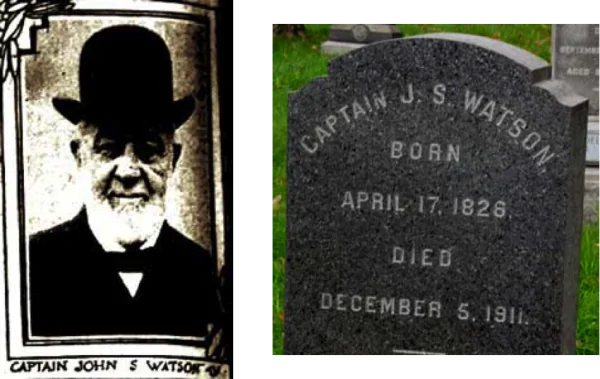
WATSON, JOSIAH (1817-1864). Major, United States Marine Corps. Watson, who was born in Washington, D.C., began serving in United States Marine Corps as a second lieutenant on June 21, 1835. He rose to first lieutenant on March 3, 1847, to captain on December 10, 1855, and to major on November 16, 1861. He last lived at 26 Garden Street in Brooklyn. He died from consumption. Section 162, lot 14384.
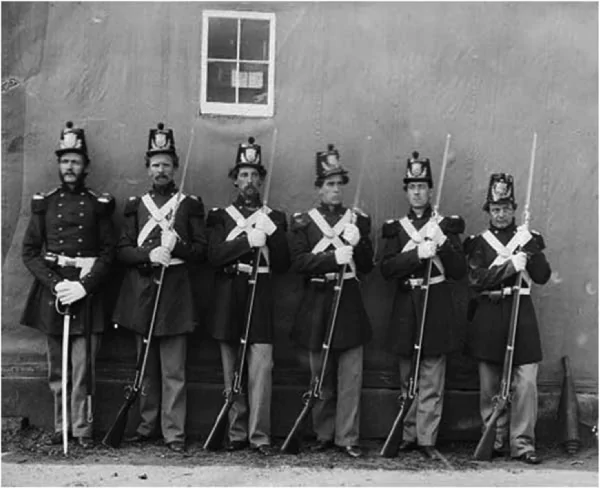
Washington, D.C. Six marines with fixed bayonets at the Navy Yard. April 1864.
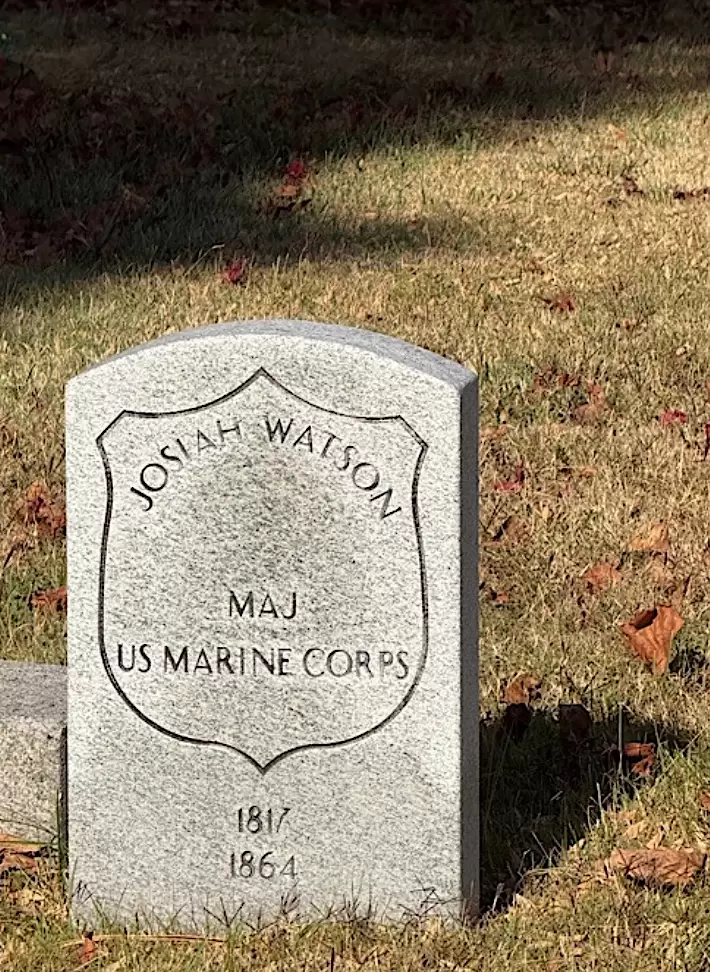
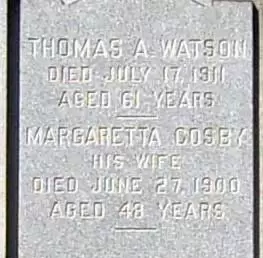
WATSON, THOMAS A. (1841-1911). Private, 13th Regiment, New York State National Guard, Company B. He enlisted at Brooklyn on May 28,1862, mustered immediately into the 13th Regiment, and mustered out after serving three months on September 12 at Brooklyn. He last resided at 607 Jefferson Avenue, Brooklyn. A gravestone was ordered for him early in the 20th century. Section 97, lot 7809, grave 7.
WATSON, WILLIAM (1836-1863). Private, 36th New York Infantry, Company C. Watson was born in New York. After enlisting as a private at New York City on May 15, 1861, he mustered into the 36th New York on June 17. According to his muster roll, he was present with his company in April 1863 after returning from desertion on March 21 of that year; his muster roll indicates that he was paid through February 28, 1863, and that he served in the 10th Regiment after he returned from desertion. Watson mustered out with his company on July 15, 1863, at New York City. As per his obituary in the New York Herald on August 5, 1863, he died suddenly; friends and relatives and members of the 36th Regiment were invited to attend his funeral at the home of his brother-in-law at 143 East 20th Street in New York City. The cause of his death was “coup de soleil” (sunstroke). Lot 4071, grave 440.
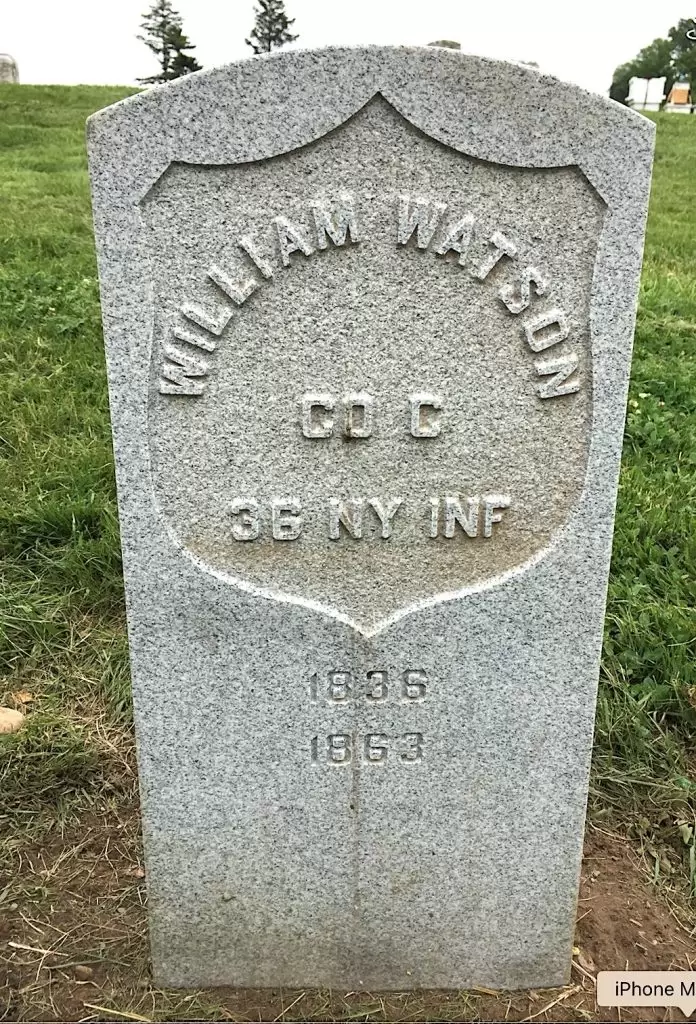
WATSON, WILLIAM (1843-1896). Private, 26th New Jersey Infantry, Company A. A New York native, Watson enlisted as a private on September 3, 1862, mustered into the 26th New York on September 18, and was discharged on June 27, 1863, at Trenton, New Jersey. He last resided in Paterson, New Jersey, but died from dementia at Middletown State Home Hospital in New York. He was survived by his wife; their two children predeceased him, one dying at age one, the other died in 1881. In 1910, his wife applied for a widow’s pension, application 947,693, but it was never certified. Section 105, lot 4030, grave 4.
WATSON, WILLIAM L. (1844-1902). Captain, 21st Wisconsin Infantry, Company G; private, 7th Regiment, New York State National Guard, Company E. Watson was born in Albany, New York, and served as a Congressional page as a youth. His ancestry dates back to the Plymouth colony and one relative, John Watson, was a land surveyor in Hartford, Connecticut, in 1644. He served in New York’s 7th Regiment during 1861. Later, as a resident of St. Lawrence, Wisconsin, he enlisted as a sergeant on August 20, 1862, and mustered that day into the 21st Wisconsin. He was taken as a prisoner of war at Perryville, Kentucky, on October 8, 1862, and subsequently was promoted to first sergeant.
After being promoted to lieutenant on March 29, 1863, Watson was again taken prisoner at the Battle of Chickamauga, Georgia, on September 9, 1863, and was confined at Macon, Georgia, and then at Libby Prison in Richmond, Virginia. He and several other prisoners dug a tunnel that they used in a daring escape on the night of February 9, 1864, but were later recaptured. In that mission, of the 109 Union officers who attempted to flee, 48 were recaptured, Watson being in sight of Union pickets when he was retaken.
Captain Frank Moran, a fellow prisoner who was with Watson in that ill-fated escape, wrote an article in The Century Illustrated Month Magazine in March 1888, recounting the difficult and arduous task that the leaders of the plot endured in planning the escape. Libby Prison was isolated, under constant guard, and all belongings kept from prisoners. Yet, with determination, a rope, and a few tools, an escape route from the kitchen and through a tunnel was carefully dug out at night with the knowledge of a few prisoners who were intent on gaining their freedom. As the time of escape came closer, the inmates had to devise plans to cover for the two men who were digging the tunnel during the day when roll-call occurred. After leaving the rat-infested sewer with scant clothing on February 9, Watson and Moran escaped but according to Moran, “…We were run down and captured in a swamp several miles north of Charlottesville, and when we were taken our captors pointed out to us the smoke over a Federal outpost. We were brought back to Libby and put in one of the dark, narrow dungeons.” Colonel Thomas Rose of the 77th Pennsylvania, who led the escape was eventually recaptured and also returned to Libby Prison.
The account of the escape was also recounted by Mortimer Thomson, his boyhood friend, who wrote a Letter to the Editor that was published in The New York Times on April 13, 1902, after Watson’s death. Thomson wrote in part of Watson, “…After several months of incarceration, during which he had been first reduced to a skeleton by privation and then swollen out of all proportion by the disorder consequent on prolonged malnutrition, he concluded that death would be preferable to life held any longer on such terms and decided to escape if he could…” Thomson went on to say that Watson “was particular to emphasize that the negroes were his only friends, and that if it had not been for the occasional aid with food and shelter he would have collapsed from starvation and exposure….” Thomson concluded by saying that Watson’s future success was founded upon the virtues developed in military life. On January 14, 1865, he was promoted to captain, serving until he mustered out on June 8 of that year at Washington, D.C.
Watson commanded Company G, the Beecher Company, of the 13th New York after the Civil War as of August 16, 1878, rose to colonel in 1895, and served in that position when the regiment was disbanded by Governor Black during the Spanish-American War. According to his obituary in the Brooklyn Daily Eagle, Watson’s “unimpeachable military record” was clouded during the Spanish-American War when there was controversy about the enlistment of New York regiments in the call for volunteers. Apparently there was dissension when officers and men were separated and in the end, Watson was sent home.
A one-time member of the New York Produce Exchange, he was the Second Deputy Collector of Taxes for Queens at the time of his death. His obituary in The New York Times described his funeral as one with full military honors, including a horse, saddled and bridled, with boots reversed in the stirrups that followed the hearse. Members of Company E of the 7th Regiment, in which he once served, fired volleys over his grave. He was a member of the Ulysses S. Grant Post #327 of the Grand Army of the Republic, an organization for Civil War veterans that also participated in his funeral. In addition, he belonged to the Masons and the Loyal Legion. He last lived in Whitestone, Queens. Section 179, lot 14416.

1. Streight’s room; 2. Milroy’s room; 3. Commandant’s office; 4. Chickamauga room (upper); 5. Chickamauga room (lower); 6. Dining-room; 7. Carpenter’s shop (middle cellar); 8. Gettysburg room (upper); 9. Gettysburg room (lower); 10. Hospital room; 11. East or “Rat Hell” cellar; 12. South side Canal street, ten feet lower than Carey street; 13. North side Carey street, ground sloping toward Canal; 14. Open lot; 15. Tunnel; 16. Fence; 17. Shed; 18. Kerr’s warehouse; 19. Office James River Towing Co.; 20. Gate; 21. Prisoners escaping; 22. West cellar.
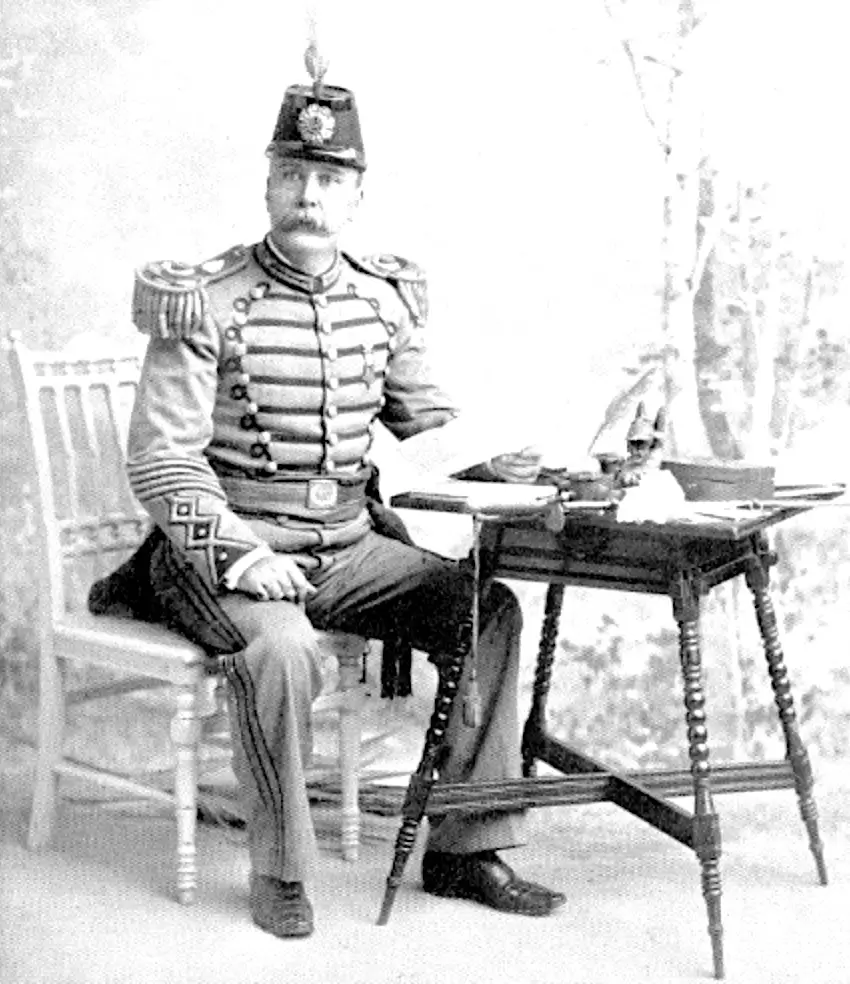
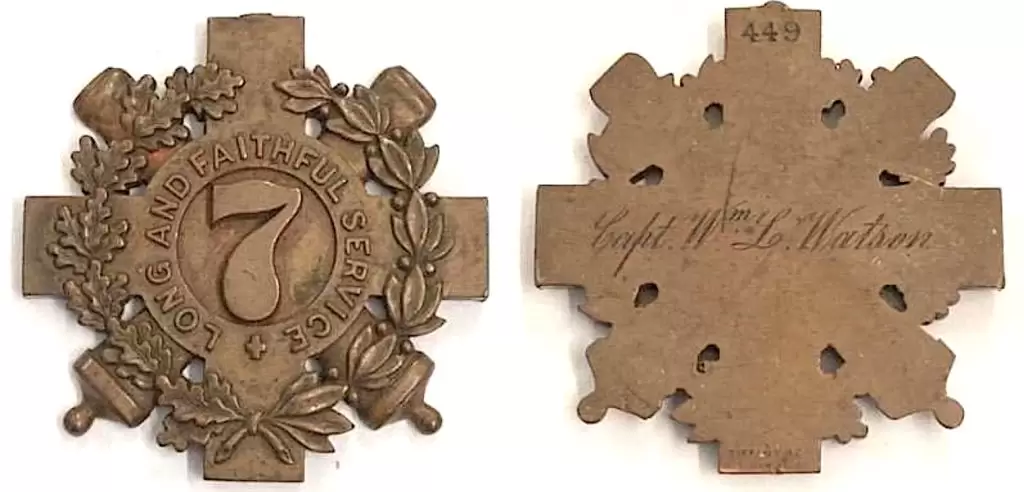
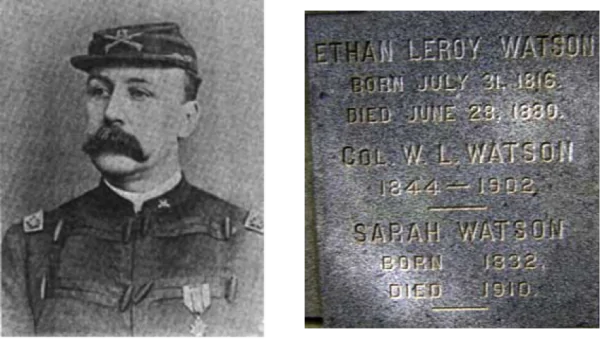
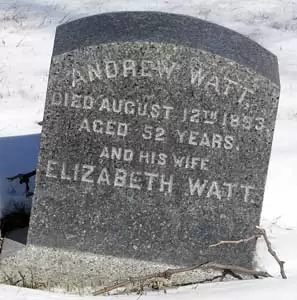
WATT, ANDREW (1842-1893). Private, 88th New York Infantry, Company B. Watt was born in Ireland. He enlisted at New York City on March 1, 1865, immediately mustered into Company B of the 88th New York, and mustered out on June 30 of the same year, at Alexandria, Virginia. In 1891, his application for an invalid pension was granted, certificate 788,309. He last lived at 50 West 42nd Street, New York City. His death was caused by dysentery. Elizabeth Watt, who is interred with him, applied for and received a widow’s pension in 1898, certificate 385,702. Section 135, lot 27263, grave 2408.
WATTERSON (or WATERSON), HENRY (1845-1876). Private, 9th New York Infantry, Company I; landsman, United States Navy. Born in Scotland (or the Isle of Man), Watterson enlisted at Brooklyn on May 4, 1861, and mustered into Company I of the 9th New York, also known as Hawkin’s Zouaves. During his service with the 9th, he engaged in skirmishes at Roanoke Island, North Carolina, on February 8, 1862; Camden, North Carolina, on April 19, 1862; Plymouth, North Carolina, on August 30, 1862; Antietam, Maryland, on September 18-19, 1862; Fredericksburg, Virginia, on December 11-15, 1862; and at the siege of Suffolk, Virginia, from April 19-May 4, 1863. He mustered out on May 20, 1863, at New York City.
When Watterson returned to service on February 20, 1865, it was as a landsman in the Navy where he served aboard the USS Wasp, was promoted to the ship’s writer, and mustered out at Washington, D.C., on December 24, 1868. Remaining active in military affairs, he was a member of the Henry M. Lee Post #21 of the G.A.R. He last lived in Poughkeepsie, New York. Section 127A, lot 8998, grave 69.
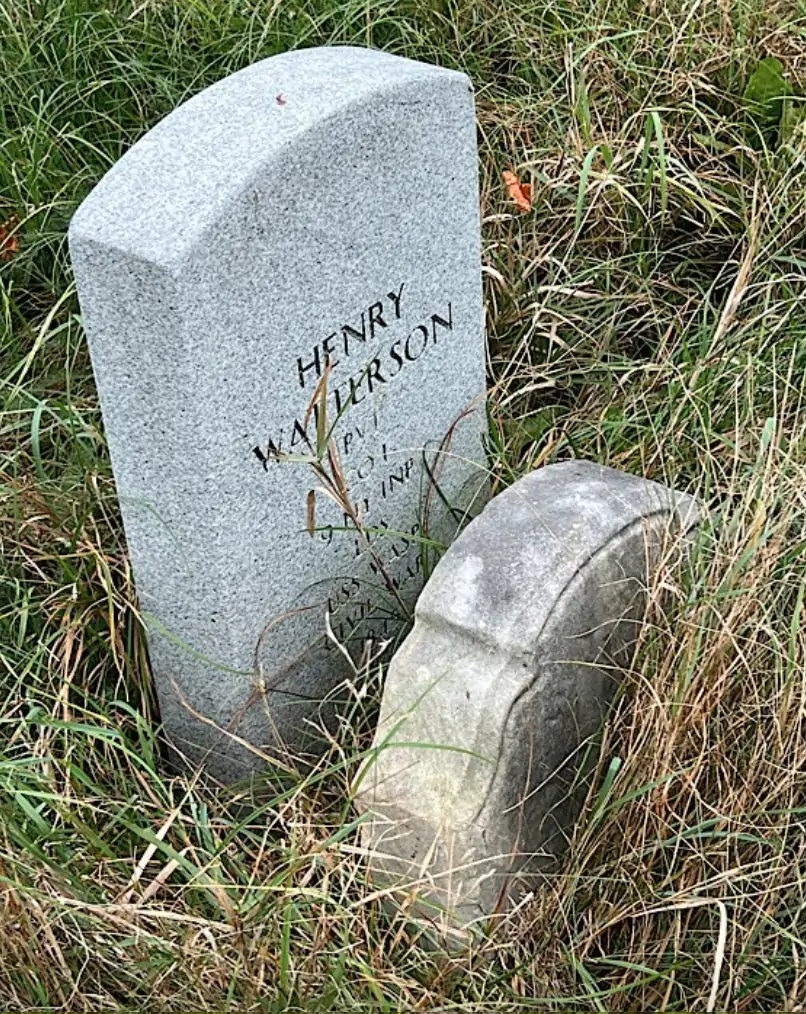
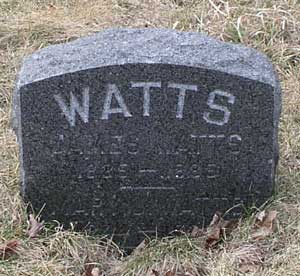
WATTS, JAMES (1844-1885). Musician, 8th New York Infantry, Company D. Originally from England, Watts’s service in the Civil War was noted in the Brooklyn Daily Eagle. According to that article, he served as a musician in Company D of the 8th New York Infantry. He last lived in the New Utrecht section of Brooklyn. Section 2, lot 5499, grave 1253.
WATTS, JOHN HENRY (1825-1877). Captain, 31st New York Infantry, Company K. Of English birth, his father was an officer in the East India Company and his mother died during or shortly after John’s birth in London according to the family historian, Liz Heaton Brown. Watts enlisted on May 24, 1861, was commissioned into the 31st New York the next month on June 13, and resigned on October 13, 1862. Colonel Calvin Pratt of the 31st commended Watts and other officers after First Bull Run, Virginia, “I deem it to be a duty to give the names of the officers of my regiment who were engaged in the battle, and to whose coolness and judgment I am indebted for the success that attended my regiment.”
The 1870 census lists Watts as a physician but according to the 1877 Brooklyn Directory, he was a druggist with a business at 1341 Fulton Street, where he took his own life. An article about his death appeared in the May 11, 1877, edition of the Brooklyn Daily Eagle. His death, attributed to prussic acid, noted that he was in business for 34 years but, despondent over the death of his wife fifteen months earlier, was in financial trouble, and was turning to alcohol for solace. During the period after his wife’s death, he was forced to move his business from Columbia Street and sell his beloved house at 186 Dean Street for less than half of what he paid for it to pay off debts. He was interred with his wife. Section 163, lot 15046.
WATTS, JOSEPH (1840-1872). Private, 83rd New York Infantry, Company H. A New York native, he enlisted as a private at New York City on September 18, 1863, mustered into the 83rd New York on that day, and deserted the next month on October 3 at Culpepper, Virginia. As per his obituary in the Evening Post, he died from the effects of sunstroke. An article in the New York Herald on August 23, 1872, noted that the temperature reached 96˚ the previous day before a squall and thunderstorm ushered in cooler weather. The article noted that Joseph Watts, a driver, had suffered from sunstroke and was admitted to Park Hospital, where he died. He last resided at 164 Franklin Street in Manhattan. Section 76, lot 8019.
WAX, JR. (or WACHS, WEIR), CONRAD (1843-1917). Private, 30th New York Light Artillery. Originally from Wurttemberg, Germany, he was also borne on the rolls as Conrad Wachs. A shoemaker when he enrolled, he had light hair, blue eyes, a “healthy” complexion, and was 5′ 3″ tall. Wax enlisted at New York City as a private on October 1, 1861, the same date that he mustered into the 30th New York Light Artillery. He re-enlisted in the regiment on January 4, 1864, and was discharged from military service on June 23, 1865, at New York City.
Wax became a naturalized citizen on October 29, 1867. In 1878, his application for an invalid pension was approved, certificate 917,428. According to several Brooklyn Directories from the mid-1880s-mid 1890s, and the 1880 census, he was employed as a hatter. The 1900 census lists an alternate name, Conrad J. Weir. His last address was 159 Washington Park in Brooklyn. Section 17, lot 17245, grave 1147.
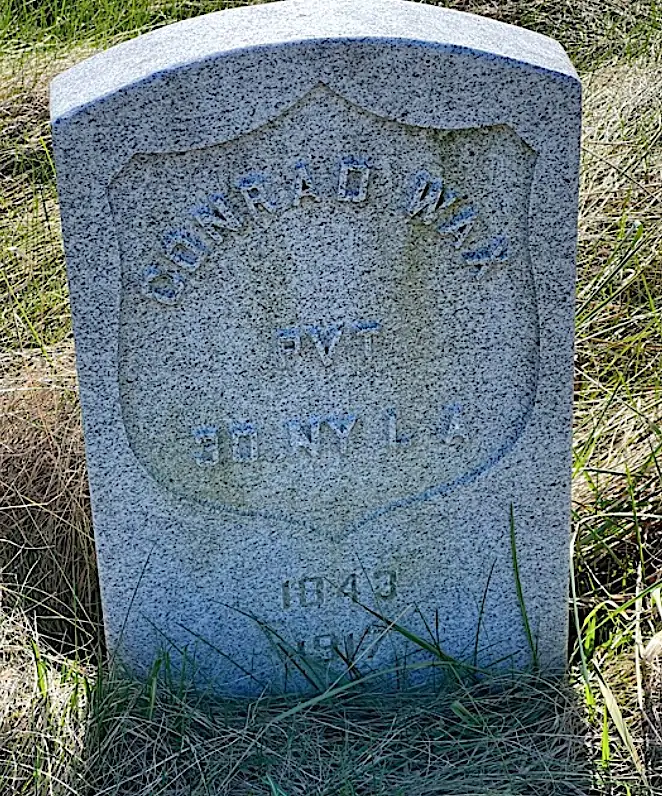
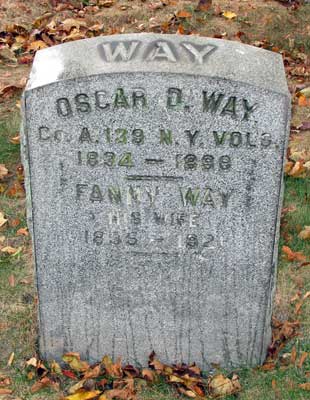
WAY, OSCAR D. (1834-1898). Private, 139th New York Infantry, Company A. A lifelong New Yorker, he enlisted at Brooklyn as a private on August 29, 1862, and mustered into the 139th on September 9. He was wounded at the Battle of Cold Harbor, Virginia, on June 3, 1864, and mustered out on June 19, 1865, at Richmond, Virginia. In 1875, he applied for and received an invalid pension, certificate 135,496. He last lived on Bruyns Lane near Bath Avenue in Brooklyn. In 1898, Fanny Way applied for and received a widow’s pension, certificate 476,123. Section 62, lot 6432, grave 8.
WAYDELL (or WADDELL), WILLIAM ANDERSON (1832-1878). Corporal, 8th Regiment, New York State Militia, Company F. A New York City native, he enlisted at New York City as a corporal in 1861 and served with the 8th Regiment when it was activated that year for three months. His last residence was on Avenue A and 117th Street in New York City. Section 120, lot 16971.
WEAVER, CHARLES (1829-1862). Private, 31st New York Infantry, Company G. Weaver was born in Connecticut. During the Civil War, he enlisted as a private on December 9, 1861, at New York City and mustered into Company G of the 31st New York. He died from typhoid fever at the Military Hospital at West Philadelphia, Pennsylvania (one source incorrectly reports the hospital was in Virginia), on or about September 26, 1862. Connecticut newspapers were asked to print notice of his death. Originally interred at Green-Wood on September 28, 1862, in Lot 8998, grave 215, his remains were removed from Green-Wood on December 12, 1899.
WEAVER, ISAIAH (1844-1879). Drummer, 53rd New York Infantry, Company E. Weaver, who was born in Troy, New York, enlisted as a drummer and mustered into Company E of the 53rd New York (second organization). Further details are not available. His last residence was Long Island, New York, where his death was listed as a casualty. Section 15, lot 17263, grave 552.
WEAVER, RICHARD (1834-1893). Private, 37th New York Infantry, Company D. Born in Islington, England, he came to New York City in 1840. On May 29, 1861, he enlisted as a private at New York City, mustered into the 37th New York, and mustered out on September 2, 1862. His last residence was 360 Bramhall Avenue in Jersey City, New Jersey. Section 147, lot 22016.
WEAVER, RICHARD (?-1898). Private, 1st Kentucky Infantry, Company H. Weaver, who was originally from England, enlisted in 1861 and served for three months in Company H of the 1st Kentucky. Section ?, lot ?.
WEBB, DAVID (1820-1863). Colonel, Horatio Seymour Cavalry. Webb was colonel of the Horatio Seymour Cavalry, a unit that originated in the 13th New York Cavalry, but was not completely organized. On January 16, 1863, Col. David Webb, succeeded, on his death, by Col. Alfred W. Taylor, and he by Col. Henry S. Gansevoort, was authorized to recruit the Horatio Seymour Cavalry. He died in New York City. Section 28, lot 9816.
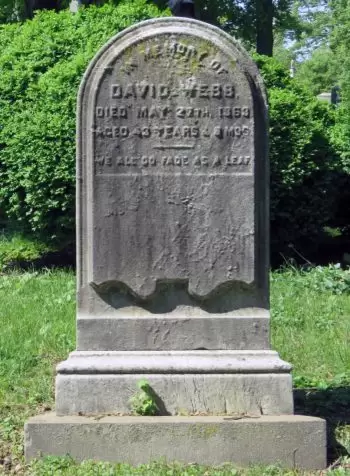
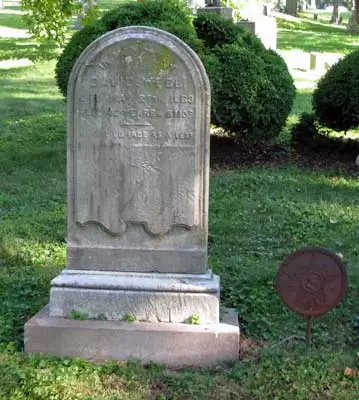
Marker from GAR Post 327
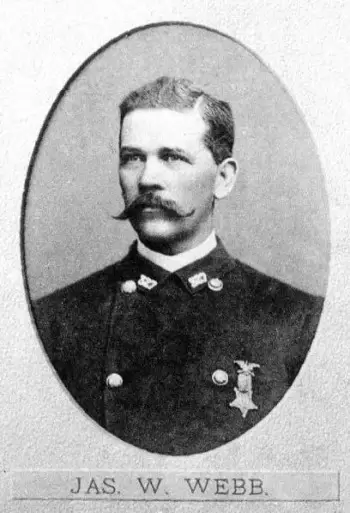
WEBB, JAMES WRIGHT (1845-1923). Quartermaster sergeant, 13th Tennessee (Union) Cavalry. This is the biography in the G.A.R. Ulysses S. Grant Post #327’s book on its members:
James W. Webb was born in New York City on the 24th of May, 1845. In 1857, when he was but twelve years of age, he removed to Texas, where he lived with an uncle. Two years later he joined a company of Texas Rangers, and from that time to the breaking out of the civil war was engaged in fighting hostile Indians and lawless bands of Mexicans. In 1862 the company with which he was connected was mustered into the Confederate service at Vicksburg, Miss[issippi], but he remained true to the old flag and joined the secret service of the U.S. government. He was subsequently captured by guerillas, but made his escape.
In 1863, finding he was becoming too well known for secret service, he enlisted in the Thirteenth Tennessee (Union) Cavalry as private of Company C, commanded by Captain Logan. He was soon after appointed Quartermaster’s Sergeant, and while acting in this capacity was ordered with his regiment to Fort Pillow [Tennessee]. Not long after this the garrison, composed of 240 white and 360 colored troops, was attacked by the Confederates under General [Nathan Bedford] Forrest. The garrison made a gallant defense until their ammunition gave out, and they were about to surrender when the indiscriminate massacre of white and black troops commenced.
After a number had been butchered in cold blood, Webb rushed up to [Confederate] General [James R.] Chalmers and said to him, “For God’s sake, General, stop the firing; our men are being all killed.” General Chalmers then went forward, and the firing soon afterwards ceased. Among the troops engaged in the attack were the Texas Rangers, the former comrades of Sergeant Webb. They conspired to take him out and hang him while a prisoner, but a Lieutenant, who was formerly a clerk in the store of Webb’s uncle, frustrated their designs and saved him. He, Webb, was taken, with fifty-nine other white men, and conveyed to Andersonville [Prison], where all but four died. These, together with Webb, were removed to Florence, Ala[bama], where two others died, leaving only Webb and one comrade. It is believed that he has since died, which would leave Sergeant Webb the only survivor of the Fort Pillow massacre. Webb was subsequently paroled, and after remaining in the hospital at Fort Schuyler for eleven months, was finally discharged by telegraphic order from the War Department.
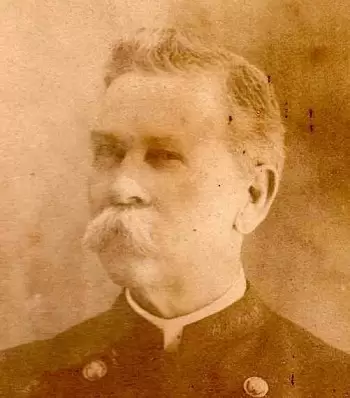
In 1875, Webb became a patrolman with the Brooklyn Police Department and soon joined the Mounted Squad. He was a founding member of G.A.R. Post 327 and was part of honor guard assigned to the remains of Ulysses S. Grant when he lay in state at New York’s City Hall in 1885.”
According to the 1896 Brooklyn City Directory, Webb was a policeman who lived at 60 Woodbine Street in Brooklyn. His obituary in the Brooklyn Daily Eagle confirmed many of the details of his sketchbook biography and notes that he had scars on his forehead and left hand as a result of the Indian skirmishes during his time with the Texas Rangers. The obituary also reports that he worked at the Williamsburg Savings Bank after leaving the police force and was a Freemason. His last address was 1462 Dean Street in Brooklyn. Section 155, lot 25920.
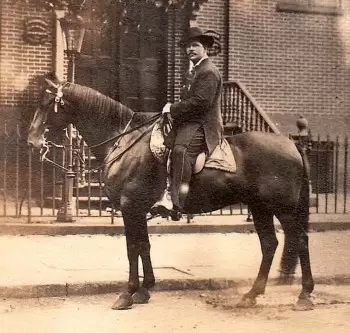
WEBB, ROBERT D. (1840-1872). First sergeant, 12th New York Infantry, Company K; sergeant, 5th New York Veteran Infantry, Company E. Of Irish origin, he enlisted as a private on September 24, 1861, at New York City, and mustered into his company on October 1. Webb was promoted to sergeant on November 1, 1862, and to first sergeant on January 17, 1864. On June 2, 1864, he transferred into the 5th Veterans with the reduced rank of sergeant and was discharged on October 3 of that year. He last lived at 316 West 53rd Street in Manhattan. Section 167, lot 16743.
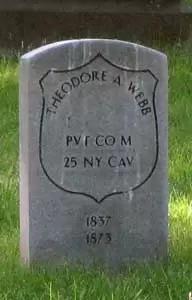
WEBB, THEODORE A. (1837-1873). Private, 25th New York Cavalry, Company M. A native of New York, he enlisted at Jamaica, New York, on September 27, 1864, mustered into the 25th New York Cavalry that day, and mustered out on June 27, 1865, at Hart’s Island, New York Harbor. He last lived in Brooklyn. Webb’s death was caused pneumonia. Section 33, lot 8859.
WEBBER, SAMUEL (1841-1899). Corporal, 15th New York Cavalry, Company L. Of English birth, a passenger manifest documents that 14-year-old Samuel Webber arrived in New York City from Bristol, England on the Petrel, on July 14, 1856. During the Civil War, Webber enlisted at Westfield, New York, as a private, on December 17, 1863, and mustered into the 15th New York Cavalry on that date. As per his muster roll, he was a laborer who was 5′ 8″ tall with hazel eyes, light hair and a light complexion.
On May 3, 1864, he was taken as a prisoner of war and sent to Andersonville Prison in Georgia. The prison was constructed in early 1864 to provide a more secure location for Union prisoners. Officially known as Camp Sumter because of the county in which it was housed and only in existence for fourteen months, the National Park Service website reports that of the 45,000 Union soldiers incarcerated there, almost 13,000 died from disease, poor sanitation, malnutrition, overcrowding or exposure. In August 1864, 33,000 men were imprisoned at the site built to house 10,000. A fifteen foot high stockade wall surrounded the prison, shaped like a parallelogram. There was a so-called “deadline,”19 feet inside the wall that prisoners were not allowed to cross; if they did so, guards had permission to shoot them. The National Park Service website quotes Sergeant Samuel Corthell of the 4th Massachusetts Cavalry who remembered:
The camp was covered with vermin all over. You could not sit down anywhere. You might go and pick the lice all off of you, and sit down for a half a moment and get up and you would be covered with them. In between these two hills it was very swampy, all black mud, and where the filth was emptied it was all alive; there was a regular buzz there all the time, and it was covered with large white maggots.
By the time General William T. Sherman occupied Atlanta on September 2, 1864, moving Federal cavalry within striking distance of Andersonville, the Confederate army moved most of the prisoners to other camps in coastal Georgia or South Carolina. From then to the end of the war, Andersonville operated on a smaller scale until it stopped operations in May 1865. Ultimately, only 460 graves of Union soldiers interred there were marked “unknown”; other graves are marked in Andersonville National Cemetery. In 1890, the Georgia Department of the Grand Army of the Republic, a Union veterans organization, purchased the land where the prison camp had stood and sold it for one dollar to their affiliate, the Woman’s Relief Corps (WRC) which planted pecan trees and began erecting commemorative monuments. In 1910, the group donated the prison to the people of the United States to be administered by the War Department. In October 1970, it was designated a national historic site, and since then it has been administered by the National Park Service.
Webber was exchanged, as per prison records, on April 1, 1865. That paperwork noted that he was a corporal; his muster roll does not indicate that promotion. Other sources state a release date of April 29, 1865. According to his muster roll, he mustered out at New York City on June 12, 1865 to date from May 16, 1865. A book of Andersonville prisoners, shared by a descendant and pictured below, was given to Webber in 1882.
The 1870 census reports that he was a blacksmith who lived in New York City with his wife Annie and a three-year-old son also named Samuel. Webber mustered into the Grand Army of the Republic on December 21, 1888. His last residence was 209 East 80th Street in Manhattan. Green-Wood records note that he was married at the time of his death attributed to injuries. Another Samuel Webber (possibly his son) was interred in Samuel Sr.’s grave in 1894. His United States-issued headstone notes his rank as private. Section 135, lot 27263, grave 556.
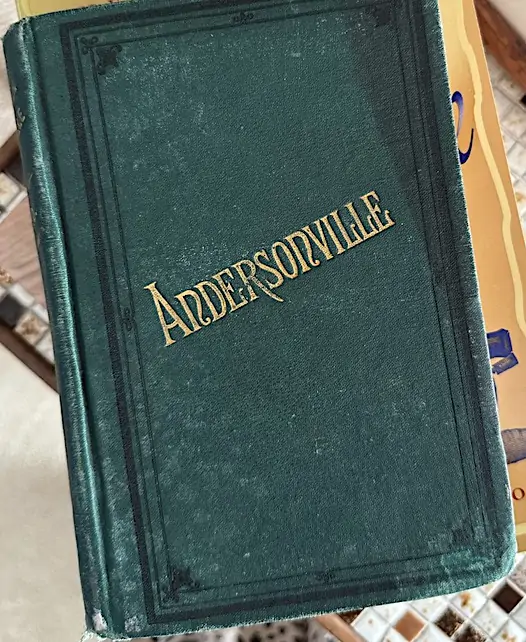
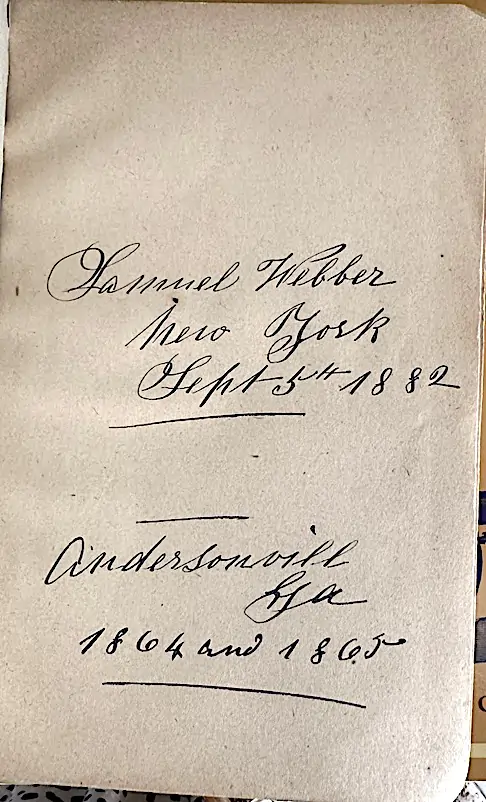
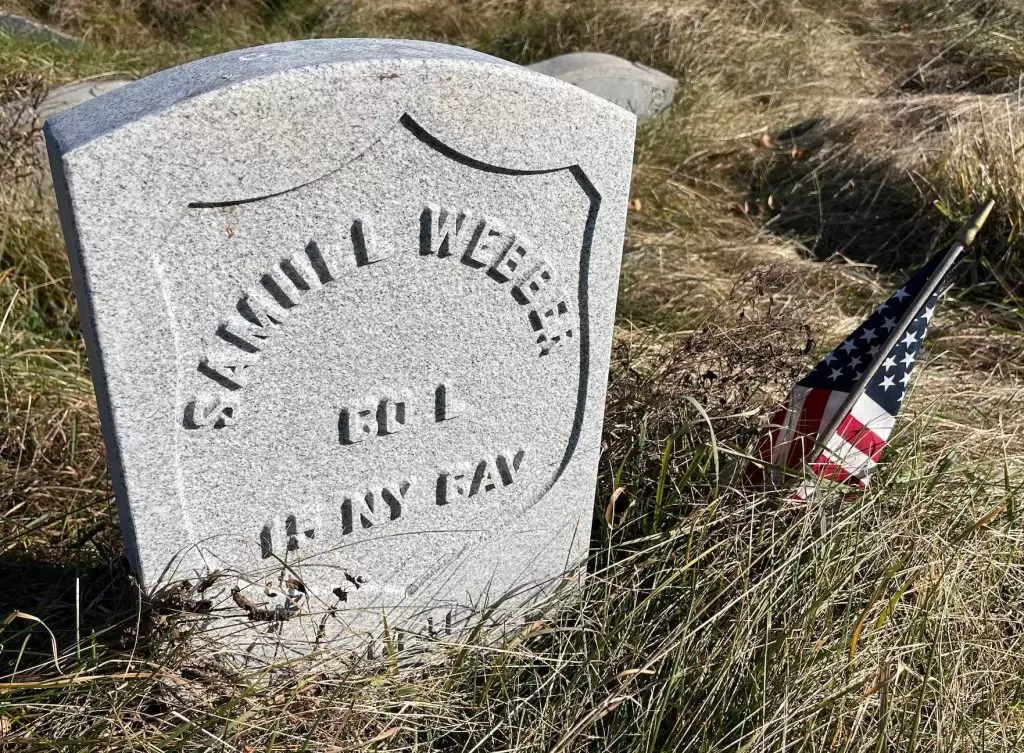
WEBER, PHILIP (1835-1911). Private, 20th New York Infantry, Company F. Born in France, Weber enlisted at New York City on August 18, 1861, mustered into the 20th New York the next day, and mustered out on June 1, 1863, at New York City. He last resided in Rye, New York. Section 46, lot 22634, grave 1.
WEDEKIND (or WETEKIND), ERNST (1819-1867). Private, 58th New York Infantry, Company E. Originally from Germany, Wedekind enlisted at New York City as a private on January 18, 1862, mustered into the 58th New York that same day, and was discharged for disability on September 12, 1862 at Fairfax Court House, Virginia. His last residence was 29 Broome Street in Manhattan where he succumbed to consumption. Section 121, lot 11189, grave 178.
WEEDEN (or WEEDOR, WEEDON), FREDERICK (1839-1862). Private, 13th Regiment, New York State National Guard, Company H. A Brooklyn native, Weeden enlisted there as a private on May 28, 1862, and mustered immediately into Company H of the 13th Regiment. The 13th Regiment was stationed in Suffolk, Virginia, and at the end of its tour of duty, was sent home on the steamer Baltic. While on its journey, the ship ran aground at Chincoteague Shoals, where it remained for 24 hours before it was set afloat and proceeded to New York City.
Although Weeden was scheduled to muster out with his company on September 12, 1862, he died in transit to his hometown on September 10 of typhus fever; his soldier record notes the muster out date but not his death. As per an article in the Brooklyn Daily Eagle on September 13, 1862, members of Company H turned out to escort his body to his gravesite at Green-Wood. Military honors were performed at his burial. He last lived at 274 Livingston Street in Brooklyn. Section 20, lot 7135.
WEEKES, EDWARD FERRIS (1836-1913). Assistant surgeon, United States Navy. Weekes, who was from Huntington, New York, was an assistant surgeon in the Navy, where he served aboard the USS Kingfisher in the Gulf Blockading Squadron. The Kingfisher assisted in the capture of the Olive Branch, the Mary Nevis, and the Lion. Weekes was then ordered to return to Boston in 1862 after an outbreak of scurvy on the vessel. Subsequently, the Kingfisher was assigned to the South Atlantic Blockading Squadron. He died in Blue Point, New York. Section 187, lot 16640.
WEEKS, ERIC (1819-1882). Mate, United States Navy. Of Swedish origin, Weeks served as a mate in the United States Navy aboard the USS Arago. Further details of his service are unknown. He last lived at 115 Washington Street in Hoboken, New Jersey. Weeks died of Bright’s disease. Section 7, lot 9819.
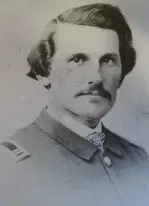
WEEKS, GEORGE D. (1835-1899). Major by brevet; assistant quartermaster, United States Volunteers Quartermaster’s Corps; captain, 173rd New York Infantry, Companies A and I; private, 84th New York (14th Brooklyn) Infantry, Engineers. Weeks, who was born in Long Island, enlisted at Brooklyn on April 18, 1861, mustered into the 14th Engineers on May 23, and mustered out on August 28 at Arlington, Virginia. He re-enlisted at Brooklyn as a second lieutenant on September 11, 1862, was commissioned into Company A of the 173rd on October 30, and was promoted to captain on July 7, 1863, effective upon his transfer to Company I.
According to his obituary in the Brooklyn Daily Eagle, which outlined his Civil War service, he became quartermaster of General Dwight’s division of the 9th Army Corps during the Red River Campaign of 1864 with the rank of major. On March 13, 1865, he was promoted by brevet to major, “for faithful and meritorious service during the War. He was commissioned into the United States Volunteers Quartermaster’s Corps as a captain and assistant quartermaster on June 15, 1865, and mustered out on October 23, 1865.
The aforementioned obituary reports that Weeks was on custom house duty in Louisiana after the War. In 1892, he was appointed janitor of the United States Building in Brooklyn, a position that he held for five years before serving as the city weigher for the Fifth Judicial District. In addition, he was a member of the Grand Army of the Republic and the War Veterans’ Brigade; members of both organizations were invited to his funeral. He last lived at 481 Carlton Avenue in Brooklyn. Weeks died of pneumonia. Section 152, lot 19405, grave 2.
WEEKS, JOHN (1828-1895). First sergeant, 78th New York Infantry, Company B. Born in Sweden, Weeks enlisted at New York City as a first sergeant on October 30, 1861, mustered into the 78th New York six days later, and deserted on July 29, 1862, at Little Washington, Virginia. His last residence was in Brooklyn. Section 135, lot 27263, grave 2457.
WEEKS, WILLIAM E. (enlisted as ELLSWORTH, GEORGE) (1843-1926). Corporal, 10th Illinois Cavalry, Company I. A native of Palmyra, New York, he enlisted as a private on September 23, 1861, and mustered into the 10th Illinois Cavalry on December 6. He was promoted to corporal at some point and mustered out on May 1, 1862. His pension record indicated that he used the alias George Ellsworth and that he had additional service in the 9th Illinois Heavy Artillery. In 1906, he received a pension, certificate 1,125,214. Weeks last lived at Port Ewen, New York, but died at Tampa, Florida. Nina Weeks applied for and received a widow’s pension in 1926, certificate A-5-6-26. Section 131, lot 35911.
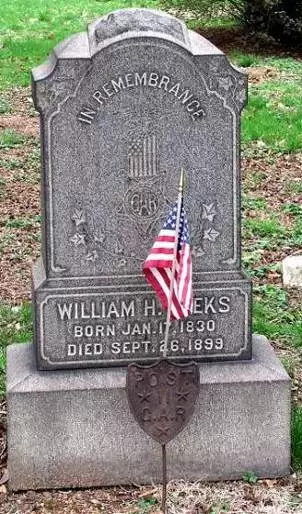
WEEKS, WILLIAM H. (1830-1899). Corporal, 15th New York State Engineers, Companies I and A. After Weeks enlisted as a private on June 17, 1861, at Willets Point, New York, he mustered into Company I of the 15th New York Engineers. At some point, he was promoted to corporal before he was discharged on June 25, 1863. On March 29, 1864, he re-enlisted as a corporal in the same regiment, mustered into Company A, and mustered out of service on July 2, 1865, at Washington, D.C. A member of the G.A.R., a shield from that veterans’ association is inscribed on his stone and an additional marker noting the Barbara Frietchie Post #11 is on his gravesite. His last residence was 15 Tompkins Avenue in Brooklyn. Section 186, lot 19713, grave 2.
WEIGAND, CHARLES (1827-1864). Major, 39th New York Infantry, Company F. Of German birth, he enlisted at New York City as a captain on May 3, 1861, and was commissioned into Company F of the 39th New York on May 28. Subsequently, he was promoted to major on August 2, 1861, and was discharged on January 24, 1862. He last lived at 759 Third Avenue in Brooklyn where he succumbed to remittent fever. Section 117, lot 10975, grave 118.
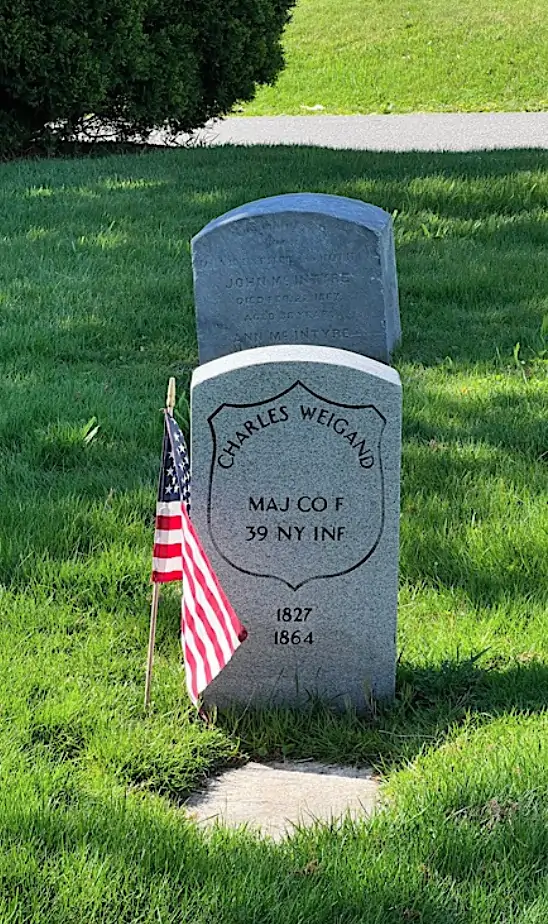

WEIMER (or WEYMER), MICHAEL (1837-1867). Private, 33rd New York Infantry, Company H. Private, 33rd New York Infantry, Company H. Weimer, who was born in New York State, enlisted as a private on May 1, 1861, at Geneva, New York, and mustered into the 33rd New York on May 22. He mustered out on June 2, 1863, at Geneva, New York. He last lived in New York. In 1890, Barbara Weimer applied for and received a widow’s pension, certificate 287,161. Section 2, lot 7838.
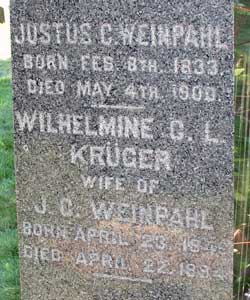
WEINPHAL, JUSTUS (or GUSTAV, GUSTAVE) C. (1833-1900). Private, 5th Regiment, New York State Militia, Company B. Weinphal, a native of Germany, enlisted on May 16, 1861, at Washington, D.C., immediately mustered into the 5th New York Regiment, also called the Jefferson Guard, and mustered out on August 7, 1861, at New York City.
As per the 1869 and 1870 Brooklyn Directories, Weinphal was in the liquor business in Red Hook on the India Wharf of the Atlantic Docks. The 1888 New York City Directory also indicates that he was in the liquor business. He was a member of the Mackenzie Post #399 of the G.A.R. He applied for an invalid pension in 1897, application 1,188,604, but there is no evidence that it was certified. He last resided at 369 2nd Street in Brooklyn. He died from a malignant tumor. Charlotte Weinpahl’s application for a widow’s pension was granted in 1921, certificate 925,538. Section 204, lot 28530, grave 1.
WEIR (or WIER), DANIEL (1842-1881). Private, 84th New York (14th Brooklyn) Infantry, Company I. . After enlisting on July 1, 1861, Weir mustered in on August 1, 1861, and deserted on October 28, 1862, at Alexandria, Virginia. It is possible that he did not desert but was ill and sent home by Surgeon Farley with the blessing of Colonel Ned Fowler; both men thought their soldiers could get better care at home than in the field hospitals. It is possible that Daniel Weir is the son of Donald Weir (see). Section 166, lot 4073, grave 197.
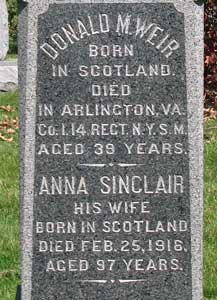
WEIR (or WIER), DONALD M. (1821-1861). Private, 84th New York (14th Brooklyn) Infantry, Company I. Weir was born in Scotland and came to America in 1850. Shortly after he enlisted at Brooklyn at the age of 39, and mustered in on July 1, 1861, Weir died of disease at Arlington, Virginia, on July 28, 1861. Anna Weir, who is interred with him, applied for and received a widow’s pension in 1868, certificate 162,704.
On the occasion of Anna Weir’s 96th birthday, an article in the Brooklyn Daily Eagle was written about her in which she said that she lost her husband and son, who was named after Donald, in the Civil War. She said, “You see, the great conflict between the North and the South robbed me of two of my dear ones. My husband, Donald M. Weir, and my son did their full duty as every man ought when his country calls.” That article and her obituary in the Brooklyn Standard Union note that her husband died at Second Bull Run in 1862. However, that information conflicts with her husband’s soldier record which states that he died a year earlier of disease. Anna Weir recalled that her son returned to Brooklyn but died of disease contracted during the War. It is possible that Daniel Weir (see) is the son of Donald Weir. Donald Weir’s remains were moved to Green-Wood in 1893. Section 166, lot 28472.
WEIR, HENRY CARY (1840-1927). Medal of Honor recipient; lieutenant colonel and major by brevet; major and assistant adjutant general, United States Volunteers; second lieutenant, 1st Pennsylvania Cavalry, Company G. Born in West Point, New York, he enlisted as a second lieutenant on October 10, 1861, and immediately mustered into the 1st Pennsylvania Cavalry. He was discharged for promotion on July 17, 1862, and commissioned that day into the Quartermaster’s Department of the United States Volunteers where he was promoted to captain and assistant quartermaster on August 7.
Weir was awarded the Medal of Honor in 1899 for his action on June 24, 1864, at St. Mary’s Church, Virginia. According to the citation, “the division being hard pressed and falling back, he dismounted, gave his horse to a wounded officer enabling the latter to escape, and on foot rallied and took command of some stragglers, and with pistol in hand helped repel the last charge of the enemy.” Weir was also brevetted major for that action on August 1, 1864.
On September 9 of that year, he was promoted to captain and assistant adjutant general and commissioned into the Adjutant General’s Department of United States Volunteers. In a letter recommending Weir for promotion by brevet, he was cited for “conspicuous gallantry and meritorious services in the engagements at Saint Mary’s Church on the 24th of June1864; Deep Run on August 16, 1864, and at Ream’s Station on August 23, 1864.” On October 1, 1864, he was severely wounded in battle at Vaughan Road, Virginia. He became major and assistant adjutant general on February 5, 1865, and was brevetted to lieutenant colonel on March 13, 1865. Two months later, on May 19, Weir resigned. His application for an invalid pension was granted. His last residence was in Warwick, New York. He died of arteriosclerosis. Section 10, lot 13957.
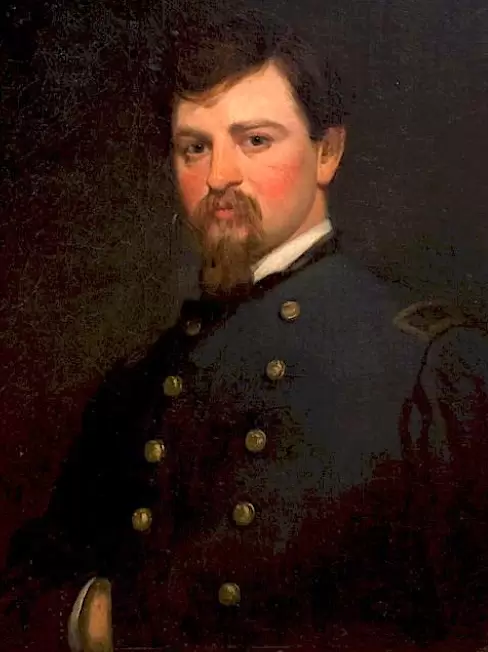
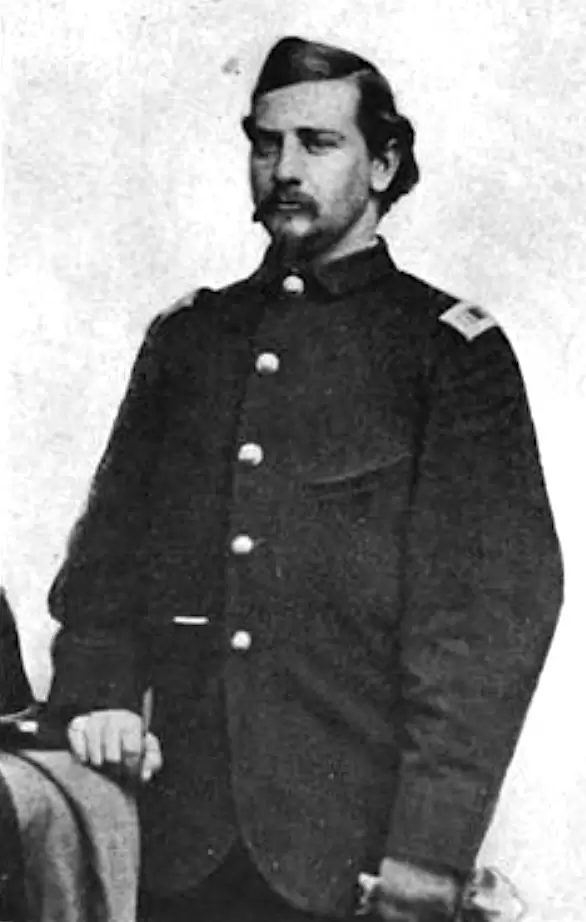
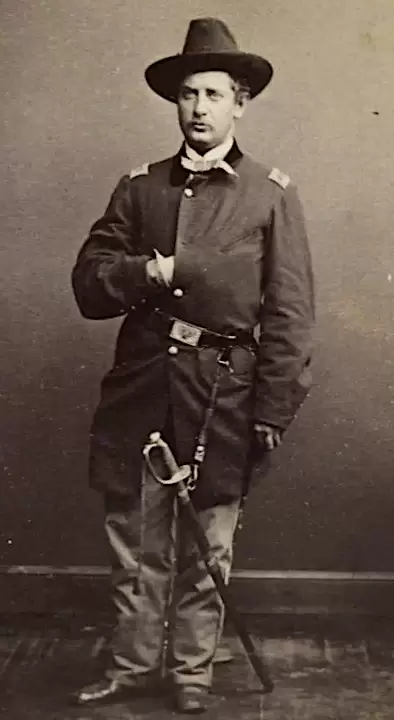
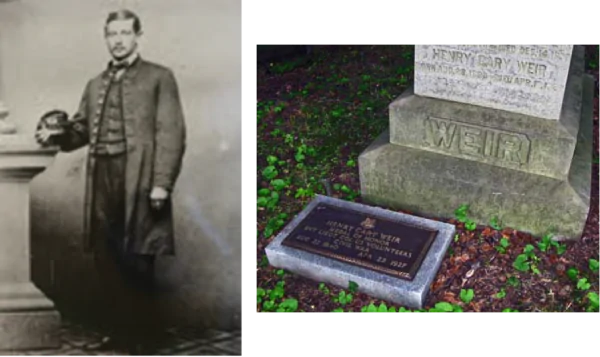
WEIR, JAMES E. (1842-1903). Private, 5th New York Infantry, Company C; second class fireman, United States Navy. A native of Canada and a soap-boiler by occupation, he enlisted on April 23, 1861, at New York City, and mustered into the 5th New York on May 9. Weir was court-martialed on February 1, 1863, for refusing to carry wood until he was given some rations. He was sentenced to carry a 30-pound log for six hours a day for 30 days and wear a placard that read, “I disobeyed orders.” He mustered out on May 14, 1863.
Subsequently, Weir enlisted in the Navy on October 20, 1864, and was a second class fireman aboard the USS Potomac, Owasco, and North Carolina, until his discharge on July 20, 1865. After the War, he was a member of the 5th Veterans Association where he held the position of secretary. His last residence was in Jersey City, New Jersey. Section 15, lot 17263, grave 64.
WEISHEIT, WILLIAM (1820-1866). Private, 3rd New York Infantry, Company C. Originally from Germany, Weisheit enlisted as a private at the Second Congressional District, New York, on February 22, 1865, mustered into the 3rd New York on March 22, and was discharged at Raleigh, North Carolina, on August 28, 1865. His last residence was 375 Whitworth Street in Brooklyn where he died from consumption. Section A, lot 8998, grave 326.
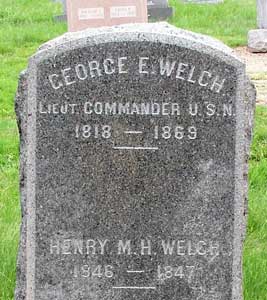
WELCH, GEORGE E. (1818-1869). Acting volunteer lieutenant, United States Navy. A native of Massachusetts, Welch joined the Navy as an acting volunteer lieutenant on October 31, 1861, and resigned on April 12, 1862. He returned as an acting volunteer lieutenant on July 1, 1862, and was honorably discharged on September 13, 1865. His last address was 46 Ryerson Street in Brooklyn. Section L, lot 18796.
WELCH, PATRICK (1824-1881). Private, 37th New York Infantry, Company B. He enlisted as a private on May 9, 1861, and mustered into the 37th on June 7. Other details of his service are unknown. His last residence was in Linden, New Jersey. His death was caused by paralysis of the brain. Section 181, lot 12077.
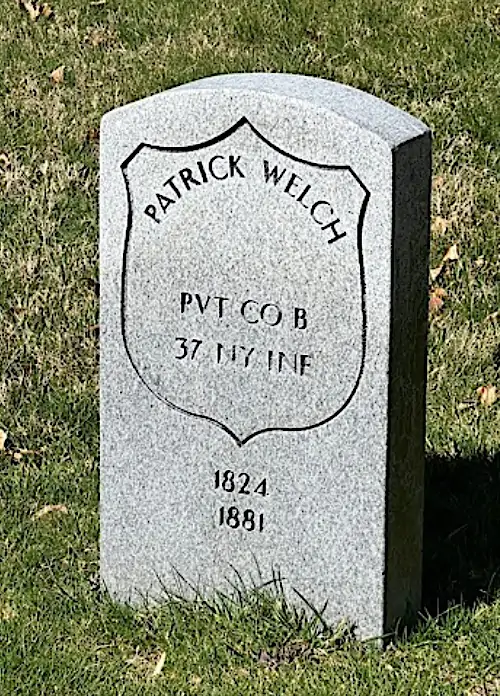
WELCH, WILLIAM (1837-1911). Landsman, United States Navy. Originally from France, Welch served in the United State Navy. After enlisting and mustering in on August 25, 1864, he served aboard the USS R. R. Cuyler, and mustered out on June 30, 1865. His last residence was 266 12th Street in Jersey City, New Jersey. Section 141, lot 23596, grave 6.
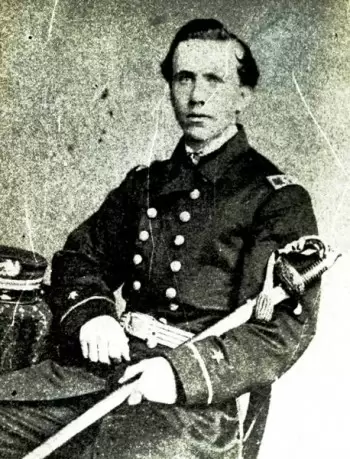
WELD, MANCHESTER WARD (1841-1877). Acting ensign, United States Navy. Weld was born in New York. After enlisting in the Navy at New York City on December 18, 1863, he was commissioned as an acting ensign in the North Atlantic Squadron. He served on the USS Canonicus, one of nine 2,100-ton “Monitor” class vessels commissioned at Boston, Massachusetts, in April 1864. In May 1864, the ship was stationed in the James River area of Virginia, and took part in the bombardment of Confederate batteries on June 21, August 16 and December 5-6. On December 24-25, the Canonicus participated in the bombardment of Fort Fisher, North Carolina. In mid-January 1865, the ship, part of a large fleet, shelled the fort before a successful Union ground assault, effectively closing the port of Wilmington to blockade runners. The ship was then stationed off Charleston, South Carolina. A mission to Havana, Cuba, in April, to intercept the Confederate ironclad Stonewall, was cut short due to the end of the War. Weld was honorably discharged on May 27, 1865.
In his letter of resignation to Secretary of the Navy Gideon Welles from the USS John Adams on that date, he wrote, “Having entered the service out of patriotic motives to aid our Government in apprehending traitors and putting down treason, and as our Government has succeeded in establishing itself throughout the land, also in bringing the authors of this unholy war to their just deserts, I would most respectfully resign my position as an Acting Ensign of the Navy in the United States in temporary service.” Weld’s papers which are included in Records of Southern Plantations from Emancipation to the Great Migration edited by Ira Berlin are on microfilm at Duke University Library. They indicate that, after the War, he was an agent for the Freedman’s Bureau in North Carolina. In Weld’s writings of that period, he records disputes over crops, animals, and unpaid debts, and efforts by African-American men to reunite with their families.
A Columbia Law School graduate, class of 1871, he was a practicing lawyer as per the New York City Directory of 1876. According to The History of the Weld Family 1632-1878, Weld was married to Miss Elizabeth Pierce of Rhode Island. “They are nicely housekeeping in Brooklyn. Are congenial and happy.” At that time, 1873 (or later), they had three children. At the time of his death, he was living at the corner of 4th Avenue and 17th Street in New York City. In 1901, Mary E. Weld, in a sworn affidavit for a widow’s pension, stated that her husband had no life insurance and left her no property or money necessitating that she support herself by her own labor. In 1911, Mary E. Weld received a widow’s pension from the Navy, certificate 15,031. Section 199, lot 24992.
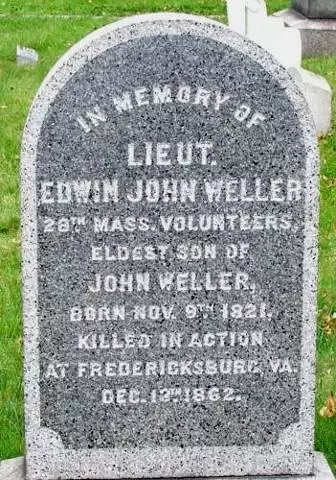
WELLER, EDWIN JOHN (1821-1862). Second lieutenant, 28th Massachusetts Infantry, Company G. A resident of Boston and an artist by profession, he enlisted as a private on November 5, 1861, and mustered into the 28th Massachusetts on December 13. He rose to corporal, was wounded at Bull Run, Virginia, on August 3, 1862, and became a second lieutenant on October 9, 1862. Weller was killed in action on December 13, 1862, at Fredericksburg, Virginia. Section 194, lot 30951.
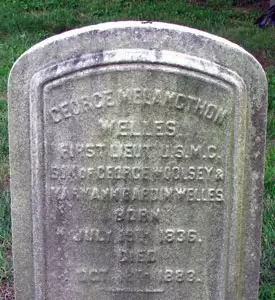
WELLES, GEORGE M. (1836-1883). First lieutenant, United States Marine Corps. A New Yorker by birth, Welles joined the Marine Corps as a second lieutenant on July 12, 1862. He rose to first lieutenant on January 11, 1865, and retired from service on November 29, 1874. His last residence was in Fort Dodge, Iowa where he died of bronchitis. Section 179, lot 13515.
WELLS, HENRY PARKHURST (1842-1904). First lieutenant, 13th New York Heavy Artillery, Company K. Born in Providence, Rhode Island, he was educated in Massachusetts at the Williston Seminary and Mt. Pleasant School and was graduated from Amherst College in 1862. During the Civil War, Wells enlisted as a first lieutenant on September 30, 1863, the same date that he was commissioned into Company K of the 13th New York Heavy Artillery as a first lieutenant. He was discharged from military service on June 28, 1865, at Norfolk, Virginia.
After studying law at Columbia Law School, Wells was admitted to the bar in 1869, and practiced in New York for the rest of his life. According to an article in The New York Times on December 20, 1887, he was elected president of the National Rod and Reel Association. He wrote Fly Rods and Fly Tackle, The American Salmon Fisherman, A City Boy in the Woods and numerous articles about hunting and fishing and protecting fish at seaports. On July 6, 1901, an article in The New York Times favorably reviewed his work, Fly Rods and Tackle, quoting Wells, “A fly fisherman is par excellence an artist. To be an artist, he must fish with his brains. He does not care for the number of fish he may catch, but how he secures them. It is the way the thing is done- this and the open air, the odor of the woods and flowers, the laughter of the running water the beauty and song of the birds, and that peace and content which open the heart of man to see and love the ever-changing beauties of nature – these give the pastime a charm possessed by no other.” The review went on to praise Wells’s work for its descriptions of rods, of which he preferred bamboo, reels, and flies and his anecdotes that showed how an Easterner could successfully fly-fish to the astonishment of Westerners. According to his obituary in the New York Evening Post, he last lived at 168 Clinton Street in Brooklyn. The obituary noted his Civil War service adding that he was complimented on several occasions for bravery in that conflict. Section 157, lot 21508.

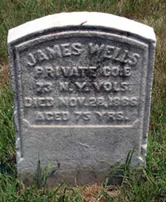
WELLS, JAMES (1811-1886). Corporal, 73rd New York Infantry, Company E. He enlisted on August 6, 1861, at Camp Decker, New York, mustered into the 73rd eight days later, and was reduced to ranks at some point before he mustered out on August 20, 1864, at Petersburg, Virginia. Section 64, lot 4071.
WELSH, JOSEPH W. (1831-1913). Second lieutenant, 163rd New York Infantry, Company B. After enlisting on September 19, 1862, at New York City, he was commissioned into the 163rd New York that day, and discharged on November 1, 1862. A resident of 431 President Street in Brooklyn, he died of a skull fracture in New Haven, Connecticut. Section 205, lot 30130.
WELSH, WILLIAM (1838-1928). First lieutenant, 68th New York Infantry, Company D; corporal, 83rd New York Infantry, Company A. Born in New Germantown, New Jersey, he enlisted at New York City as a private on May 27, 1861, the same day that he mustered into the 83rd New York. He was promoted to corporal on October 15, 1862, and discharged for promotion to second lieutenant on January 14, 1863, the same date that he was transferred and commissioned into the 68th New York. Welsh was promoted to first lieutenant on May 16, 1863, and discharged on December 14, 1864. In 1904, his application for a pension was approved under certificate 1,129,884. He last lived in Peapack, New Jersey. He succumbed to arteriosclerosis. Section 10, lot 29219, grave 3.
WENDEL, VALENTINE (1829-1897). Private, 45th New York Infantry, Company B; 58th New York Infantry, Company B. Born in Germany, Wendel enlisted at New York City as a private on September 2, 1861, and mustered into the 45th New York a week later. After re-enlisting on January 4, 1864, he was transferred into the 58th New York on June 30, 1865. On October 1, 1865, he mustered out at Nashville, Tennessee. He last lived at 213 Avenue A in Manhattan. Christina Wendel applied for and received a widow’s pension shortly after his death in 1897, certificate 458,940. Section 135, lot 14964, grave 729.
WENMAN, SAMUEL (1832-1887). Sergeant, 165th New York Infantry, Company B. Born in New York City, Wenman enlisted there as a private on August 27, 1862, and mustered into the 165th New York on November 28. He was promoted to corporal in February 28, 1863, and to sergeant on August 2, 1863, before he was reduced to the rank of private on September 27, 1863. He was absent and hospitalized in New York City at the mustering out of his regiment on September 1, 1865. According to his obituary in The New York Times, he was brevetted lieutenant for meritorious service but that is not indicated on his soldier history.
A graduate of St. John’s College, Wenman was employed after the War as a city general agent for the Equitable Life Insurance Company. He was a member of the Edwin D. Morgan Post #307, G.A.R. As per an article about his funeral in The New York Times on August 10, 1887, about 30 comrades from the Morgan Post attended his funeral; four members stood guard in the church at his flag-draped coffin throughout the night prior to his interment at Green-Wood. He last lived in the Manhattan Flats on the southwest corner of Second Avenue and 86th Street, New York City. Section 168, lot 15521.
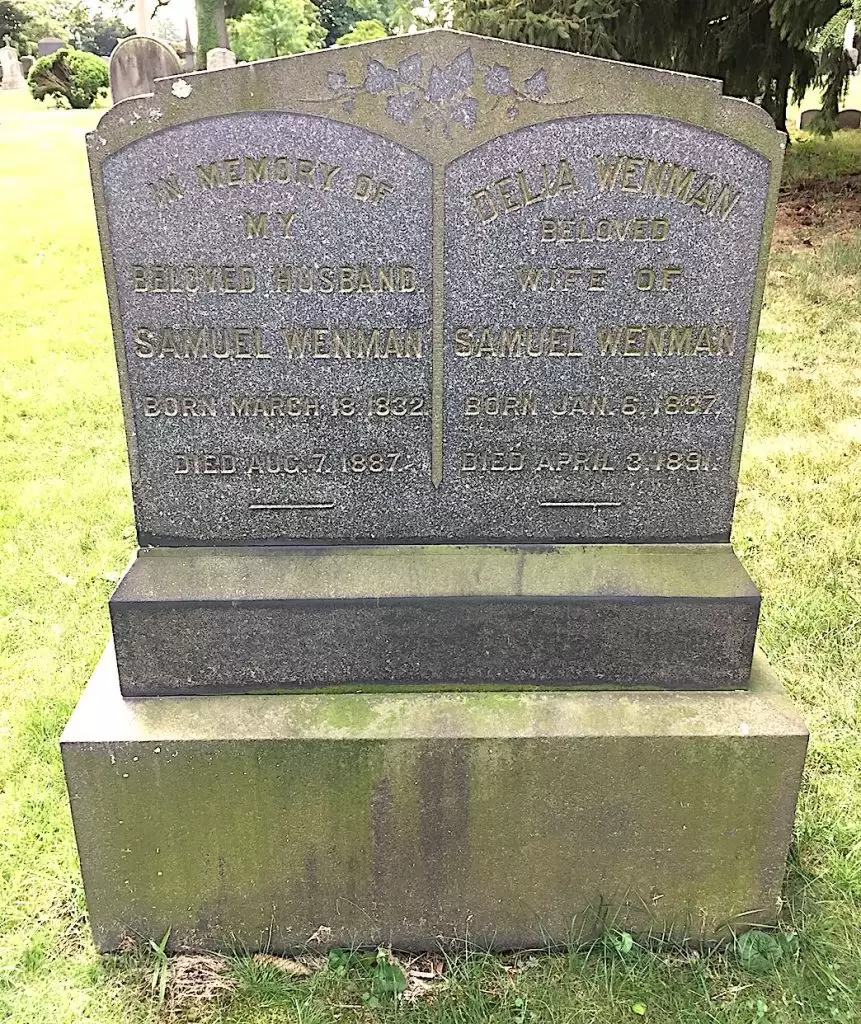
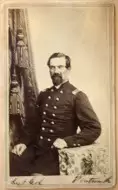
WENTWORTH, OBEDIAH F. (1819-1876). Lieutenant colonel, 8th Regiment, New York State Militia. After enlisting at New York City at age 42 on April 23, 1861, he was commissioned into the 8th Regiment as its major two days later, and mustered out on August 2 at New York City. In 1862, Wentworth returned to the 8th Regiment, then part of the New York State National Guard, as its lieutenant colonel, commissioning in on May 29 the date of his promotion, and mustering out after three months on September 10 at New York City. He returned to serve in the 8th Regiment on June 17, 1863, and mustered out after 30 days on July 23 at New York City. His last residence was 152 South 5th Street, Brooklyn. Wentworth’s death was attributed to exhaustion. Section 118, lot 7037.
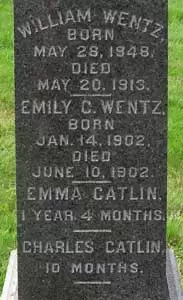
WENTZ, WILLIAM (1848-1913). Seaman, United States Navy. A native of New York City, Wentz enlisted there as a seaman and joined the United States Navy during the Civil War. He served on the USS Sabine. Further details about his service are unknown.
In 1898, he became a member of the Grand Army of the Republic’s Brooklyn City Post #233 in Brooklyn. In civilian life, he was in the poultry business in Manhattan, then was a transfer tax appraiser. Active in the Republican Party politics, he was an alderman at one time.
As per an article in the Brooklyn Daily Eagle on February 22, 1913, Wentz, a tall and heavy man, sustained internal injuries necessitating surgery after he fell at the Levi P. Morton Republican Club, an organization of which he was the president. That article, several months before his death, noted that he served in the Navy at age fifteen and was honorably discharged for disability during the Civil War. The Republican leader of the Fifth Assembly District in 1913, he belonged to many social organizations including the Freemasons, the Elks, the Odd Fellows, and the Knights of Pythias. His last residence was 405 Stuyvesant Avenue in Brooklyn. Section 8, lot 26827, grave 2.
WENZEL, AUGUSTUS (1847-1923). Hospital steward, 18th New York Cavalry, Company I; private, 47th Regiment, New York State National Guard, Company B. Wenzel, who was born in New York City, apparently lied about his age—claiming that he was older than he was—in order to serve in the Civil War. After enlisting as a private at Brooklyn on May 27, 1862, he mustered into Company B of the 47th Regiment that same day, and mustered out with his company after three months at Brooklyn on September 1. Wenzel re-enlisted at New York City as a private on September 21, 1863, mustered into Company I of the 18th New York Cavalry on October 3, was promoted to hospital steward at some point, and mustered out on May 23, 1865.
As per the 1880 Federal census and the 1892 New York State census, Wenzel was employed as a druggist. He listed his occupation as druggist when he mustered into the Abel Smith-First Long Island Post #435 of the G.A.R. on June 23, 1884. In 1904, he applied for and received an invalid pension, certificate 1,079,401. His obituary in The New York Times, which confirms his Civil War service as a pharmacist, indicates that he was a druggist in Williamsburg. That obituary notes that he was a trustee of the Dime Savings Bank of Williamsburg, a Freemason and a member of the old Hanover Club. He last lived at 992 Sterling Place in Brooklyn. His widow, Elizabeth Wenzel, reported that he died with real estate valued in excess of $5,000 and personal property in excess of $2,000; all of his property was left to his wife and nothing to his daughter. Section 82, lot 3342.
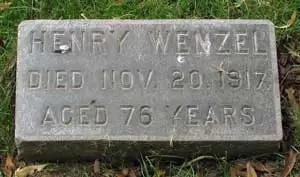
WENZEL, HENRY (1841-1917). Private, 13th Regiment, New York State Militia, Company D. Wenzel, who was born in New York State, served for three months with the 13th Regiment in 1861. In 1917, he applied for a pension, application 1,427,385, but apparently died before it was certified. He last resided on West 5th Street and Sheepshead Bay Road in Brooklyn. Section 81, lot 1493.
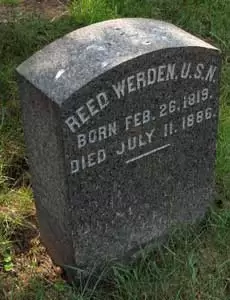
WERDEN, REED (1818-1886). Commander, United States Navy. Born in Delaware County, Pennsylvania, Werden was living in Ohio when he was appointed as a midshipman in the United States Navy on January 9, 1834. He was attached to the Brazil Squadron serving aboard the Enterprise in 1835, the Ontario in 1836, and the Erie from 1837-38. After spending time in Philadelphia at the Naval School there in 1839, he was promoted to passed midshipman on July 16, 1840, spent time in the West Indies Squadron, and was commissioned lieutenant on February 27, 1847. During the Mexican War, he served on the Germantown in 1847-48. Among many subsequent assignments, Werden was stationed at the Washington Naval Observatory and was on the sloop Cumberland off the coast of Africa from 1857-59.
At the onset of the Civil War, while attached to the frigate Minnesota, Werden participated in the attacks on the forts at Hatteras Inlet, North Carolina. He then commanded the steamers Yankee and Stars and Stripes in the North Atlantic blockade in 1861-62 and led the first division in the capture of Roanoke Island, North Carolina. After he was commissioned commander on July 16, 1862, he was in charge of the steamer Conemaugh in the South Atlantic blockade in 1862-63, then became fleet captain of the Eastern Gulf blockading squadron in 1864-65, at the helm of the Powhatan.
In describing his actions on the Conemaugh, Werden wrote about the bombardment of five schooners at Murrells Inlet, South Carolina, in 1863, “It affords me pleasure to state that so accurate was our firing that in less than an hour we had fired about 100 bales of cotton on the beach near the schooners, set one schooner on fire, and more or less injured all the others in spars and hull.” Later, he blockaded the Confederate ram Stonewall in the port of Havana, Cuba, until she was surrendered by Spanish authorities. After spending part of 1864 at the Philadelphia Navy Yard, he was fleet captain and headed the East Gulf Blockading Squadron from 1864-65. Then he was sent to the New York Navy Yard on special duty in 1866.
Werden was commissioned captain on July 25, 1866, spent two years at Mare Island, California, from 1868-69, and was promoted to commodore on April 27, 1871. He was made rear admiral on February 4, 1875, and subsequently rose to commander-in-chief of the South Pacific station in 1875-76 when Rear Admiral Napoleon Collins died. He retired from that position. His funeral in Newport, Rhode Island, included many tributes to his service. Werden’s last address was 68 Ayvault Street in Manhattan. Section 35, lot 2718.
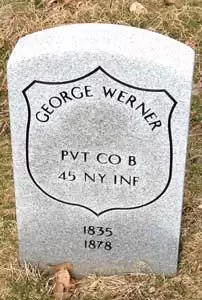
WERNER, GEORGE (1835-1878). Private, 45th New York Infantry, Company B; 58th New York Infantry, Company B. Born in Germany, he enlisted as a private on September 18, 1862, at New York City, and mustered into the 45th New York the next day. As per his muster roll, he was a clerk who was 6′ tall with blue eyes, brown hair and a fair complexion. The muster roll also notes that he was detached as “turnkey” to the military prison in Nashville, Tennessee in October 1864. He served with the regiment until June 30, 1865, at which time he transferred into the 58th New York Infantry, and mustered out on July 6, 1865, at Nashville, Tennessee. Werner died at St. Francis Hospital in New York. A marble Veterans Administration stone was ordered for him early in the 20th century. Section 115, lot 13536 (Soldiers’ Lot), grave 125.
WERNER, HENRY (1833-1900). First lieutenant, 28th Regiment, New York State Militia, Company F. Of German birth, he enlisted at Brooklyn as a first lieutenant on April 23, 1861, was commissioned into the 28th Regiment on May 11, and mustered out on August 5 at Brooklyn. He last lived on Dean Street in Brooklyn. His death was caused by chronic cystitis. Section 138, lot 26570, graves 1 and 2.
WERNER, JOHN (or JOSEPH) (1839-1897). Private, 20th New York Infantry, Company F. Originally from Norway, Werner enlisted at New York City as a private on August 12, 1861, and mustered into the 20th New York that day. As per his muster roll, he was also borne on the rolls as Joseph Werner. The muster roll also indicates that he was tried by court-martial for mutiny and misbehavior before the enemy, found guilty, and sentenced to a dishonorable discharge. Although he was listed as confined and in arrest in April 1863, he was restored to duty on April 10 and honorably mustered out on June 1, 1863, at New York City. His last residence was High Street in Brooklyn. Section 135, lot 14964, grave 928.
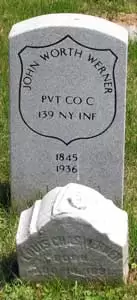
WERNER, JOHN WORTH (1845-1936). Private, 139th New York Infantry, Company C. After Werner enlisted at Brooklyn on August 21, 1862, he mustered into the 139th on September 9, and mustered out on May 15, 1865, at David’s Island, New York Harbor. His obituary in the Brooklyn Daily Eagle, which confirms his Civil War service, notes that Werner was a retired jewelry manufacturer. He died of arterial sclerosis at the age of 90 in Brooklyn where he lived on Clermont Avenue. Section 135, lot 14964, grave 1014.
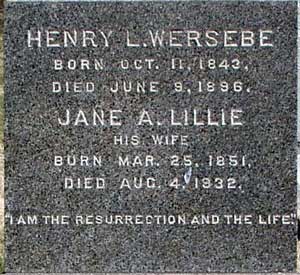
WERSEBE, HENRY L. (1843-1896). Sergeant, 45th New York Infantry, Company F. After enlisting as a sergeant at New York City on August 25, 1861, he mustered into the 45th New York on September 9. He became a first sergeant on January 17, 1863, and a sergeant on January 3, 1864. On October 8, 1864, he mustered out at Nashville, Tennessee. He last lived in Brooklyn where he succumbed to pneumonia. Section 137, lot 29195, graves 4 and 5.
WERTZ, JOHN MARZ (1835-1915). Private, 7th New York Infantry, Company C. After enlisting as a private at New York City on January 11, 1862, Wertz, a native of Germany, immediately mustered into the 7th New York and served with the regiment until he mustered out at New York City on May 8, 1863. His last residence was in Fort Lee, New Jersey. He died of chronic indolent ulcer. Section 134, lot 29725.
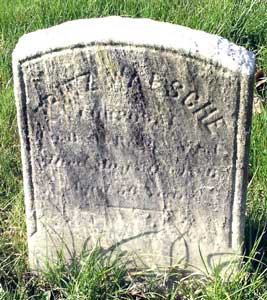
WESCHE (or WESCKE, WASCHE), FREDERICK (or FRITZ) (1830-1886). Corporal, 8th New York Infantry, Company B. A Brooklynite by birth, Wesche enlisted at New York City as a private on April 23, 1861, and mustered into the 8th New York the next day. At some point, he was promoted to corporal before mustering out on April 23, 1863, at Brooks Station, Virginia. He applied for an invalid pension, application 436,452, but no certificate number is listed. Ann Wesche, who is interred with him, applied for and was awarded a widow’s pension in 1890, certificate 363,167. Section 2, lot 5499, grave 1765.
WESSELS, JAMES H. (1826-1887). First sergeant, 141st New York Infantry, Company D. Born in New York State, he enlisted on August 16, 1862, at Corning, New York, as a private. He mustered into his company the same day, and on September 11, 1862, was promoted to sergeant. Subsequently, he was promoted to first sergeant on April 1, 1865, before mustering out on June 8 at Washington, D.C. In 1886, his application for an invalid pension was approved, certificate 354,124. He last resided at 59 Bank Street in Manhattan. His wife applied for and received a widow’s pension, certificate 232,011. Section 4, lot 21316, grave 226.
WESSMAN, CHARLES B. (1842-1888). Sergeant, 5th New York Light Artillery. A native of New York City, Wessman enlisted at Brooklyn as a sergeant on August 15, 1861, and mustered into the 5th New York Light Artillery six days later. He was reduced to ranks (private) on December 31, 1862, and mustered out on October 12, 1864, at Middletown, Virginia. He last lived at 186 West Street in Manhattan; his death was a suicide. Section 146, lot 24550.
WEST, CHARLES (1834-1908). Private, 51st New York Infantry, Company K. Born in England and a farmer by occupation, West enlisted as a private on March 19, 1864, at New York City, and mustered into the 51st the same day. He mustered out on June 13, 1865, from a hospital in Philadelphia, Pennsylvania. West last lived at the Soldiers’ Home in Bath, New York, where his death was caused by “mental insufficiency.” Section C, lot 20524, grave 2.
WEST, CLIFFORD HARDY (1846-1911). Midshipman, United States Naval Academy. A Brooklyn native, he was the brother of Edward Walter West (see). As per his obituary and articles about his career in the Brooklyn Daily Eagle, he was born on Clinton Place and lived across the street from Brooklyn Mayor John W. Hunter. West entered the United States Naval Academy, at Annapolis, Maryland, on September 22, 1863. He was a midshipman during the Civil War, and served in the Union Navy from 1863-1867, including service on the USS Macedonian.
West graduated from the Naval Academy with the rank of ensign on June 1867. From 1867 to 1870, he served on board the frigate Minnesota, the storeship Guard, the sloop Ticonderoga, and the frigate Franklin under Admiral Farragut. On March 31, 1870, he was promoted to master, served in the Navy Department as chief signal officer, and subsequently was promoted to lieutenant in March 1871. From 1871-1873, he was master on the Wyoming in the West Indies during the Virginius incident (a diplomatic dispute involving the United States, Great Britain and Spain), and made a survey of the east coast of Mexico. For much of the 1870s, he was on ordnance duty at the New York Navy Yard, then was attached to the steam sloop Alliance in the North Atlantic Squadron from 1879-1883. In 1883, he was the executive officer in the search for Lieutenant De Long in Greenland, Iceland, and Spitsbergen.
A career officer, he rose to the rank of lieutenant commander in March 1888 and served on lighthouse duty during the early 1890s. The Veterans Schedule of 1890 confirms his service as a midshipman in the Navy during the Civil War. In October 1896, he was promoted to commander and served as an aide to Rear Admiral Montgomery Sicard at the New York Navy Yard. During the Spanish-American War, he was in control of the USS Princeton and subsequently led operations against Philippine insurgents after that war. West became a captain in 1901, and in June 1902, achieved the rank of rear admiral, a month before he retired after 48 years in the Navy.
According to his obituary in The New York Times, which indicates that he served in the Civil War prior to his graduation from Annapolis, he received service medals for the Civil War, Spanish War and Philippine campaign. West was a member of the Knights of Honor, the Royal Arcanum, and other military and naval associations. He died from diabetes Washington, D.C.; his last residence in New York City was 1062 Park Place in Brooklyn. Section 72, lot 1333.
WEST, EDWARD WALTER (1836-1916). Lieutenant colonel, 33rd New Jersey Infantry; first lieutenant, 4th Rhode Island Infantry; second lieutenant, 1st United States Artillery; sergeant, 14th United States Infantry, private, 7th Regiment, New York State Militia, Company F. Born in Newton, Massachusetts, he graduated from Columbia College in 1861. He served in several regiments during the Civil War: as a private in the 7th Regiment, New York State Militia for 30 days in 1861, a first lieutenant in the 4th Rhode Island Infantry, acting aide-de-camp to the staff of Brigadier General Silas Casey and Major General Samuel P. Heintzelman, sergeant of the 14th United States Infantry, and second lieutenant of the 1st United States Artillery. At some point, he was an aide-de-camp to General Hooker. He was appointed lieutenant colonel of the 33rd New Jersey Infantry, but never mustered into that unit.
Although West was brevetted to colonel and brigadier general on the recommendations of Generals Casey and Heintzelman, supposedly for his service as lieutenant colonel of the 33rd New Jersey, and those brevets were confirmed by the Senate, someone in the War Department discovered that West had refused that appointment, and the Department refused to issue these brevets. His brother, Clifford Hardy West (see), is buried with him. As per his obituary in the New York Sun, which confirmed his Civil War service, West returned to his studies after his military service, earning a masters and doctor of laws degree from New York University. He last lived at 1062 Park Place in Brooklyn. Section 72, lot 1333.
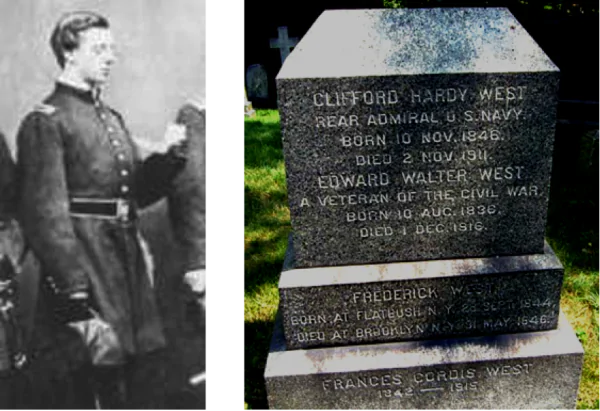
WEST, GEORGE (1830-1899). Private, 65th New York Infantry, Company C. West, who was born in England, enlisted as a private at Brooklyn on February 24, 1865, and mustered into the 65th New York that day. He was discharged from military service on July 17, 1864, at Hall’s Hill, Virginia. A member of the G.A.R. as of October 15, 1883, his last residence was 122 Summer Avenue in Brooklyn. Section 126, lot 2458, grave 927.
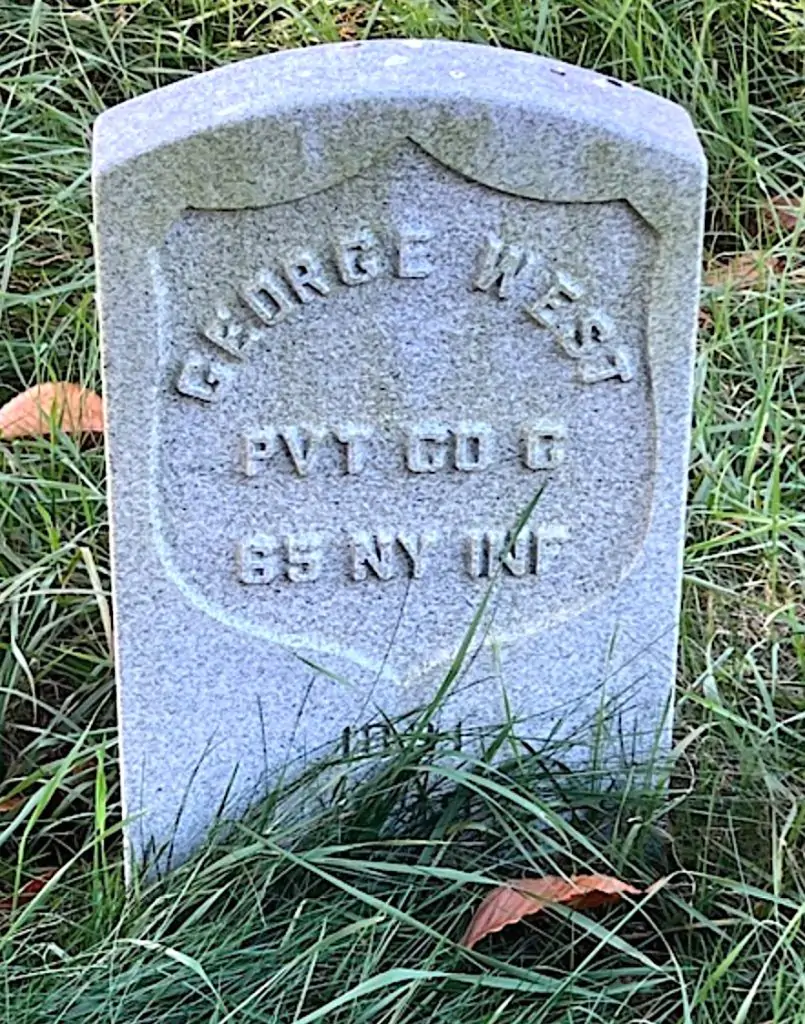
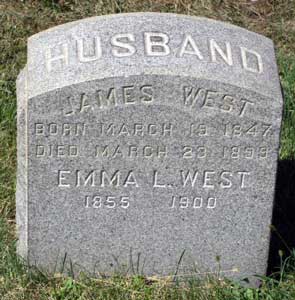
WEST, JAMES (1847-1899). Private, 48th Indiana Infantry, Company I; Indiana Veterans Infantry. Born in New York City, West enlisted at Goshen, Indiana, and mustered into the 48th Indiana on January 6, 1862. He was 5′ 5″ with hazel eyes, blond hair, and a fair complexion. The regiment was part of the Army of the Tennessee where it saw action at Pittsburg Landing, Tennessee. He later fought at Corinth, Mississippi, and was engaged in General Grant’s Central Mississippi Campaign. In the course of that operation, miles of track were destroyed during the attack on the Central Mississippi Railroad. The regiment returned to LaGrange, Tennessee, and became part of the reconnaissance units in Mississippi.
As part of the Army of the Mississippi, West’s unit took part in the campaigns in Vicksburg, Mississippi, and General Sherman’s March to the Sea in Georgia. The 48th Indiana was used as an Honor Guard at the surrender of General Johnston’s Confederate Army. West transferred into the Indiana Veterans Infantry on January 3, 1864, and was discharged from service at Louisville, Kentucky, on July 15, 1865. His last residence was 20 Cornelia Street in Manhattan. Section 127, lot 17931, grave 294.
WEST, JAMES THEODORE (1839-1910). Private, 5th New York Infantry, Company D; 146th New York Infantry, Company I. As per a researcher of the 5th Regiment, West was born in New York City on August 22, 1839; his tombstone incorrectly states 1846 as the year of birth and an online family tree shows a birth date of August 25, 1838. He enlisted as a private at New York City on August 18, 1862, and mustered into Company D of the 5th New York that same day. Two days after he enlisted, West married Mary Francis Berrian in New York City; their marriage is listed in the United Methodist Church Records. As per his muster roll, West was a 24-year-old moulder who was 5′ 7″ tall with hazel eyes, dark hair and a dark complexion. He was transferred to Company I of the 146th New York on May 4, 1863. His online family tree indicates that he fought at the Battle of Gettysburg, Pennsylvania. On June 2, 1864, he was wounded in the left side and captured at Bethesda Church, Virginia. Taken as a prisoner to Andersonville Prison in Georgia, he was paroled on February 27, 1865, and taken to a hospital at Annapolis, Maryland on March 29, 1865. He mustered out at West’s Buildings General Hospital in Baltimore, Maryland, on May 18, 1865.
After he returned to civilian life, he and his wife had a large family of seven children, five boys and two girls, born from 1867 through 1883. At the time of the 1870 census, he was living in New York City with his wife Mary and two sons. He was employed as an iron moulder and was denied voting rights (unexplained). As per the 1880 census, he was living at 284 East 4th Street in New York City with his wife, five children, father-in-law and other members of the Berrian family. That census and the 1880 New York City Directory indicate that he was still working as an iron moulder. In 1897, his application for an invalid pension was approved, certificate 995,468. The 1897 New York City Directory shows that he was employed as a molder.
His wife, who is interred with him, died in 1904. The 1905 New York State census and the 1910 federal census report that he was a widower living in the Bronx with his daughter and her family; he was not working. West’s death certificate, which lists a birth year of 1839, reports that he died in the Bronx at 424 East 162nd Street, his last address. His death was attributed to a cerebral hemorrhage. Section 85, lot 6830.
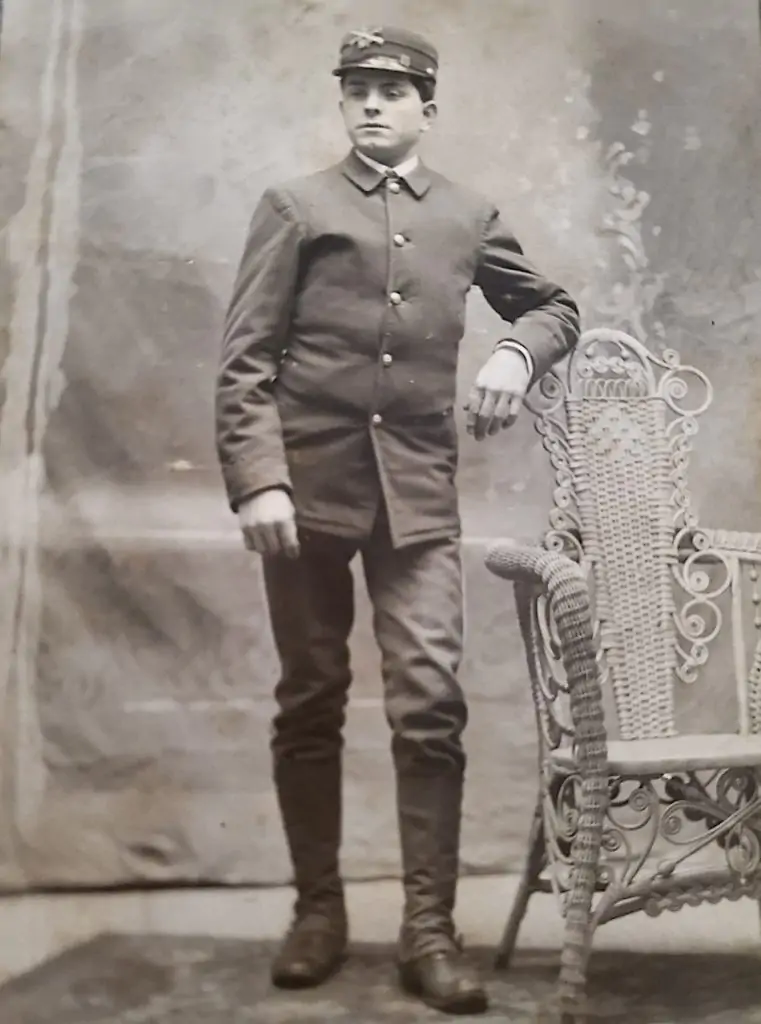

WEST, ROLAND (or ROWLAND) R. (1832-1888). Major, 12th New York Cavalry, Company D. After enlisting as a captain at Albany, New York, on January 3, 1863, he was commissioned into the 12th New York Cavalry a week later. He commanded his company in North Carolina at the skirmish at Smith’s Mills Bridge on July 15, 1863, at Greenville on November 25, 1863, and at Southwest Creek Dam on June 21-22, 1864. On September 26, 1864, he was promoted to major and subsequently transferred into the Field and Staff the next month on October 14. West mustered out on July 19, 1865, at Raleigh, North Carolina. He last lived in Brooklyn where he died of an aortic aneurysm. In 1890, his wife applied for and received a widow’s pension, certificate 316,843. Section L, lot 18523.
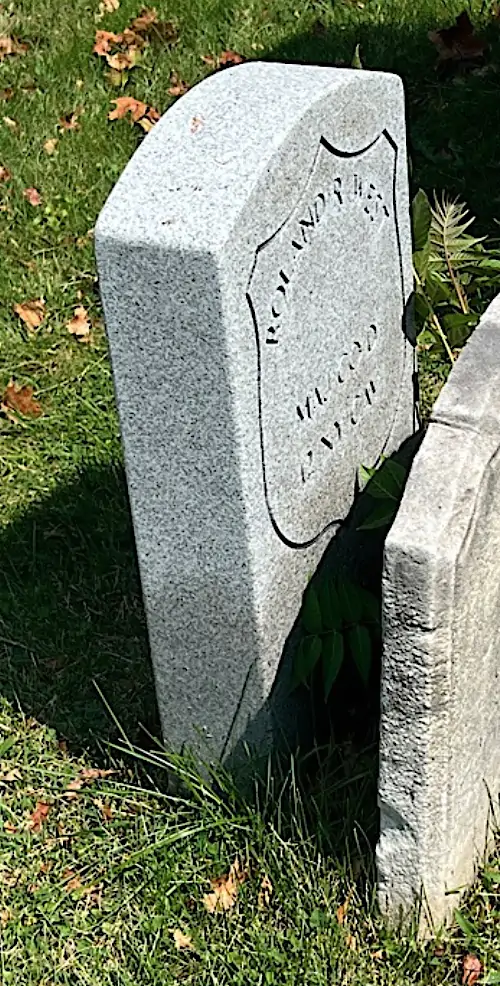
WEST, WILLIAM F. (1838-1874). First lieutenant, 173rd New York Infantry, Company I. West, who was born in New York, enlisted at Brooklyn as a first lieutenant on October 31, 1862, was commissioned into the 173rd New York on November 10, and was discharged on August 21, 1863, at Brooklyn. His last address was in Cold Springs, New York; his death listed as a casualty. Sarah J. West applied for and received a widow’s pension in 1886, certificate 309,479. Section 81, lot 3173.
WESTERVELT, PETER (also enlisted as GILDERSLEEVE, HENRY ALGER) (1812-1894). Private, 150th New York Infantry, Company C; Veteran Reserve Corps. A New Yorker by birth and a resident of Poughkeepsie, New York, he enlisted there as a private on September 13, 1862. On October 11, 1862, he mustered into Company C of the 150th New York Infantry, and was discharged for disability on May 15, 1864. As per the regimental Descriptive Book for the 150th New York, he enlisted under the name Henry Alger Gildersleeve and stated that he was 42 years old; he was in fact 50, but it was not uncommon for men to state that they were younger than their actual age, particularly when they were older than the maximum age for enlistment, 45 years old. He indicated that he was a farmer who was 5′ 9″ tall with dark hair, dark eyes and a fair complexion. The Descriptive Book notes that he transferred to the Veteran Reserve Corps.
In 1890, Westervelt’s application for an invalid pension was approved under certificate 632,492. His gravestone confirms his service in the 150th. He last lived on Quincy Avenue in Arlington, New Jersey. Section 115, lot 11193, grave 389.
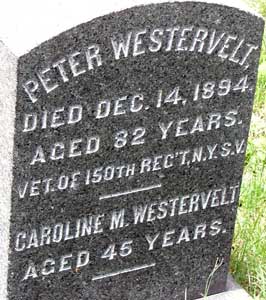
WESTLAKE, FREDERICK (or FRED, FREDRICK) S. (1826-1862). Private, 5th New York Infantry. Westlake is not buried at Green-Wood. A cenotaph honoring his memory is in his family’s lot. A native of New York, the 1850 census reports that Westlake was married with young children, lived in New York City and worked as a cooper (barrel-maker).
During the Civil War, Westlake enlisted as a private at New York City on May 9, 1861, and mustered immediately into Company B of the 5th New York. He was killed in action at the Battle of Gaines Mills, Virginia, on June 27, 1862. Apparently, his body was never recovered. His name is listed on the Casualty Sheet for Deceased Soldiers 1862. A letter to his wife, Sarah Westlake, from the captain of Company B on February 20, 1863, noted that the family was due about two months pay, less $6.14 for his clothing account; that letter also indicated that a bounty of $100 was forthcoming and that she was entitled to about $8 a month as a widow’s pension.
Sarah Westlake applied for and was granted a widow’s pension on January 27, 1863, certificate 6,887. In 1911, Sarah Westlake Allen reapplied for her pension as a remarried widow. In October 2019, the Veterans Administration recently approved an application for a cenotaph honoring his Civil War service and sacrifice. The cenotaph will be placed in his in-law’s lot where his widow Sarah Allen is interred. Section 60, lot 2499.

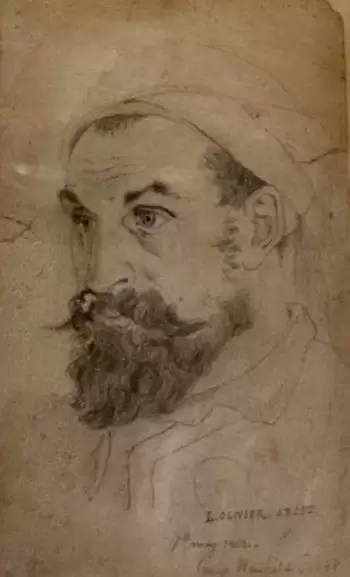
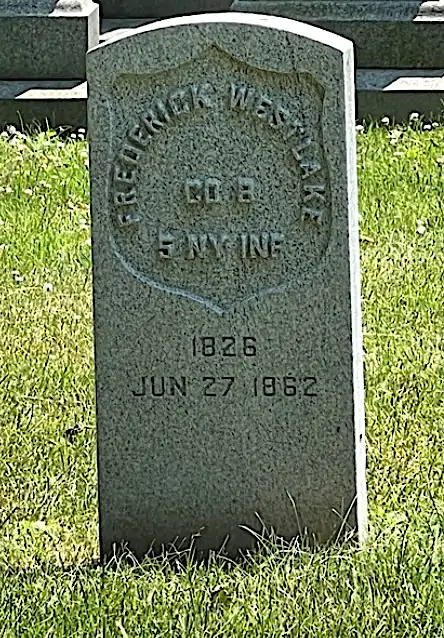
WESTLAKE, WALTER (1841-1919). Sergeant, 10th New York Infantry, Company K. Westlake, who was born in New York City, enlisted there as a private on May 2, 1861, and mustered into Company K of the 10th New York on that date. He was promoted to sergeant of his company on November 2, 1861, and mustered out on May 7, 1863, at New York City. In 1889, his application for an invalid pension was granted, certificate 499,394.
Remaining active in military affairs, Westlake was a member of the Winchester Post #197 of the Grand Army of the Republic and the Brooklyn Masonic Veterans Association. He was likely a relative of William Westlake (see). His last residence was 263 Lincoln Avenue in Brooklyn. Section 111, lot 11642.
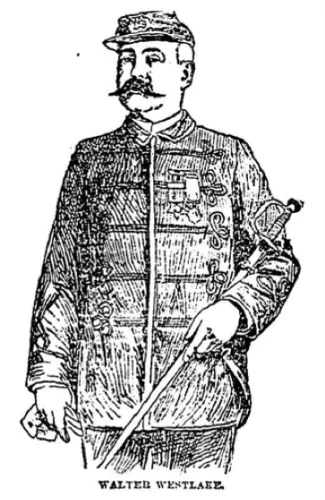
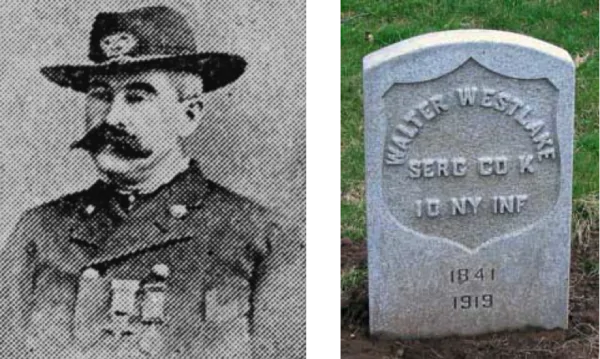
WESTLAKE, WILLIAM (1843-1922). Unknown soldier history. Westlake, who was born in New York City, was a Civil War veteran according to his obituary in The New York Times. He was likely a relative of Walter Westlake (see). Employed as a traveling salesman, he belonged to the Winchester Post #197 of the G.A.R., the Masons, the Hyatt Lodge and the Elks. His last residence was 1600 East 45th Street in Brooklyn. Section 111, lot 11642, grave 2.
WETMORE, JR., AUGUSTUS (1832-1906). Private, 7th Regiment New York State Militia, Company A. Wetmore was born in New York City and enlisted there in 1861 when he served for 30 days in the 7th Regiment. His last residence was 74 West 52nd Street, Manhattan. Section 24, lot 4874.
WETMORE, JR., OLIVER (1828-1873). Lieutenant colonel by brevet; major, 13th New York Heavy Artillery; captain, 5th New York Infantry, Company F; New York Marine Light Artillery. Born in New Jersey, he graduated from Columbia College with high honors, became a professor at the College of the City of New York and joined the 7th Regiment, New York State Militia. When the Civil War started, he was a merchant whose office was at 110 Pearl Street in Manhattan.
Wetmore enlisted at New York City as a first lieutenant on April 25, 1861, and was commissioned into Company F of the 5th New York on May 9. He was promoted to captain on September 8, 1861, and resigned on June 20, 1862, due to poor health resulting from his exposure during the Peninsula Campaign. After re-enlisting as a captain and mustering into the Light Artillery on December 30, 1862, he was discharged on March 31, 1863. On September 12, 1863, at Albany, New York, he again enlisted, this time as major, and was commissioned into the 13th Heavy Artillery on that date. He mustered out on July 18, 1865, at Norfolk, Virginia. On December 10, 1868, he was brevetted lieutenant colonel “for gallant and meritorious service in the late War.”
Continuing in the military after the War, Wetmore was a first lieutenant in the 19th United States Infantry from 1866 through December 1872, when he was forced to resign because of charges of conduct unbecoming an officer and drunkenness. Attempts to be reinstated were unsuccessful. He died of apoplexy in Washington, D.C. Section 46, lot 5350.
WETMORE, ROBERT D. (1842-1873). Private, 67th New York Infantry; 5th New York Heavy Artillery, Company B. Born in New York State, Wetmore enlisted as a private at Brooklyn on August 23, 1862, mustered into the 67th (unassigned company) that day, and was discharged on an unknown date. He re-enlisted at Brooklyn as a private on April 9, 1864, and immediately mustered into the 5th New York Heavy Artillery. On June 26, 1865, he was transferred into Company L, but never joined that company. He mustered out on July 20, 1865, at Cumberland, Maryland. A resident of New York, he died of phthisis (tuberculosis) at the Charity Hospital. Section 172, lot 14423.
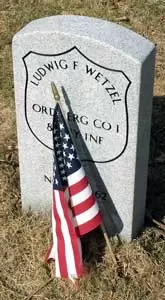
WETZEL (or WETZELL), LUDWIG (or LOUIS) F. (or I.) (1839-1862). Sergeant, 82nd New York Infantry, Company I. Originally from Germany, Wetzel enlisted as a private, mustered into the 82nd New York on an unknown date, was promoted to sergeant, and died of dysentery at his home on November 17, 1862. He last lived on West 26th Street in Manhattan. His death was caused by dysentery. Section 115, lot 13536 (Soldiers’ Lot), grave 44.
WEYER, JOSEPH (1832-1889). Corporal, 11th New York Cavalry, Company H. Of Bavarian birth, Weyer enlisted as a private on January 28, 1862, and mustered into the 11th Cavalry on that same date. At some point, he was promoted to the rank of corporal before he deserted at Washington, D.C., on August 2, 1862. At the time of his death, he resided at 210 West 33rd Street in Manhattan. Section 168, lot 16627.
WHEELER, ANDREW MERWIN (1836-1918). Private, 23rd Regiment, New York State National Guard, Company K. Wheeler was born in Hauppauge, New York. Married to Teressa Van Loon, the couple had one daughter, Ida May, who was born in 1863.
As per his records in the G.A.R. Descriptive Book, Wheeler served in Company K of the 23rd Regiment, New York State National Guard, as of July 1863 when it was activated for 30 days. He was officially discharged in August 1865. He was a member of the Clarence D. Mackenzie Post #399 of the G.A.R. as of May 13, 1884; he listed his occupation as merchant. He died in Brentwood, New York. Section 132, lot 32861.
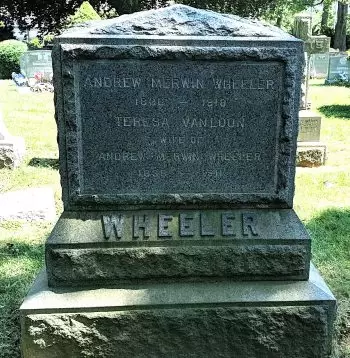
WHEELER, EDWARD BEACH (1841-1923). Corporal, 1st California Cavalry, Company M. After enlisting on August 25, 1863, at Sacramento, California, he mustered into the 1st California Cavalry two months later on October 18, and mustered out at Santa Fe, New Mexico, on September 1, 1866. In 1892, he applied for and was granted an invalid pension, certificate 908,500. As per his obituary in the Brooklyn Standard Union, he lived in Brooklyn for sixty years and had been employed as a grain weigher. His last residence was 312a 15th Street in Brooklyn. Shortly after his death from a cardiac condition, Mary A. Wheeler, who is interred with him, applied for and received a widow’s pension in 1923, certificate 936,700. Section 2, lot 5499, grave 1840.
WHEELER, GEORGE S. (1841-1871). Private, 133rd New York Infantry, Company H; Veteran Reserve Corps. Born in Ireland, he enlisted at New York City on August 26, 1862, and mustered into the 133rd New York on September 24. On April 29, 1864, he transferred into the Veteran Reserve Corps. Wheeler last lived in New Britain, Connecticut; his death was caused by consumption. Section 29, lot 13348.
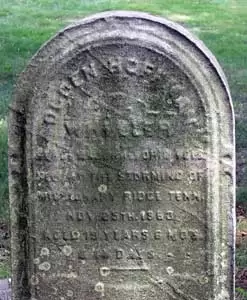
WHEELER, OGDEN H. (1844-1863). Sergeant major, 1st Ohio Infantry, Company I. After he enlisted on August 18, 1861, as a private, he immediately mustered into the 1st Ohio Infantry. He was promoted to sergeant major on October 11, 1863. Wheeler was killed in action at Missionary Ridge, Tennessee, on November 25, and was interred at Green-Wood on March 20, 1864. Section 142, lot 24656.
WHEELER, RUSSELL M. (1840-1927). Acting second assistant engineer, United States Navy. Wheeler, who was born in White Plains, New York, enlisted in the United States Navy on October 26, 1863, as an acting third assistant engineer. He was promoted to acting second engineer on February 13, 1865, and was discharged on December 9. A member of the Grand Army of the Republic, McPherson-Doane Post #499, he also belonged to the Masonic Veterans Association of Brooklyn. His last residence was 89 Rutland Road in Brooklyn. Section 195, lot 30579, grave 2.
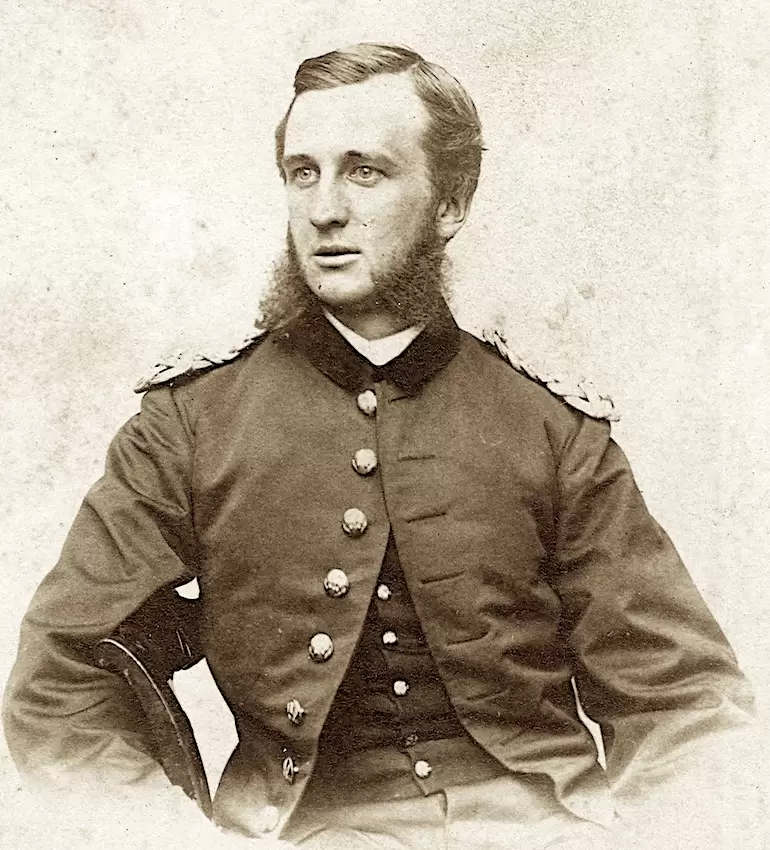
WHEELER, WILLIAM (1836-1864). Captain, 13th New York Light Artillery; sergeant, 7th New York State Militia. Born in New York City, he was educated at Yale (graduating in the class of 1855), and studied law at Yale, the University of Berlin, and Harvard. Wheeler traveled extensively in Europe before practicing law.
On May 9, 1861, Wheeler enlisted as a private in the famed 7th New York State Militia. He was soon promoted to sergeant and mustered out with the 7th after its brief 30-day service. After enlisting as a first lieutenant on October 15, 1861, at New York City, where he lived on Waverly Place, he was immediately commissioned into the 13th Independent Battery, New York Light Artillery. On March 9, 1862, he wrote to his mother from Camp Hunter’s Chapel, Virginia, “My letters to and from home are my only means of communication with the outer world. I am always in camp and have not been to Washington once since we have been out here. When my isolation is interrupted by letters from the dear friends, I feel repaid for all discomforts, and prepare myself to endure all that is endurable, and in my case the unendurable has not been reached yet.”
Wheeler was promoted to captain on May 26, 1863, served as the chief of artillery of the Second Division, 20th Corps, and commanded the 13th at Gettysburg, Pennsylvania, where his battery was nearly overrun in each of the three days of that battle. Wheeler was killed in action at Marietta, Georgia, on June 22, 1864, while sighting battery fire on rebel infantry. After his death he was described, “…as noble as he was brave.” Brigadier General John M. Brannan, United States Army, wrote of his death from Atlanta, Georgia, on September 14, 1864, and praised him for his “energy, efficiency, skill, and courage equal to any officers in the service…” When a monument was dedicated to the New York State troops at the Orchard Knob, Chickamauga and Chattanooga National Military Park, the following tribute was given to Wheeler:
Comrades, our visit to this battlefield today is mainly for the purpose of dedicating to our fallen comrades this monument erected to their memory by the people of the State of New York. Of the members of the battery who took part in the battle of Gettysburg only a very few are living. Many of them gave their lives for their country on the battlefields of Georgia and Tennessee in 1863 and 1864 and many others died of wounds received in those campaigns. Of the number who returned to their homes at the close of the war many have died of diseases contracted because of the many hardships and privations they had to suffer in the many campaigns in which they took part during their four years of service from 1861 to 1865.
We sadly miss them today but we miss more than all the gallant and brave Captain Wheeler who commanded the battery at Gettysburg and on many subsequent fields until he gave his life for this country at the Battle of Kolb’s Farm, in Georgia, on June 22, 1864.
The inscription on this monument is most appropriate. “The Thirteenth New York Independent Battery – Wheeler’s!” It was Wheeler’s Battery; because to him, as an officer of the command from its enlistment, was due the efficiency which made it such a valuable military organization.
This tribute appeared in the Obituary Record of Graduates of Yale College (1864):
WILLIAM WHEELER, youngest son of Russell C. (Y[ale] C[lass] 1816) and Theodosia (Davenport) Wheeler, fell in battle, near Marietta, Ga., July 22, 1864. He was born in New York, August 14, 1836. During his college life, the family residence was removed to New Haven.
After graduation he remained in New Haven, engaged in legal and other studies, till May, 1857, when he sailed for Europe. After passing the summer in travel, he continued the study of law during the winter of 1857—8, at the University of Berlin, and he subsequently visited Italy and Greece.
He returned to New Haven in July, 1858, and in the next Spring he entered the Law School at Cambridge, Mass., where he received the degree of LL. B. in 1860. He soon opened an office in New York City, and entered on the practice of his profession but when the rebellion began, he could not resist the call of his country, and first went to the defense of the Capitol, with the Seventh Reg. N. Y. S. N. G. in the spring of 1861. After this temporary service, he enlisted a company of men, many of whom were Germans, and received a commission first as Lieutenant, and subsequently as Captain of the 13th Independent Battery of New York. In this artillery service he was arduously engaged until he was cut down by death.
In the Shenandoah Valley and at Gettysburg, with the Army of the Potomac, and subsequently in the battle of Look- out Mountain, and during the recent advance into Georgia, he bore a most honorable part.
As his battery was connected with no brigade, promotion above the rank of Captain was not possible for him without a change of service. He was however appointed Chief of Artillery on the staff of Gen. Geary, (2d Div. 20th Army Corps,) in which capacity he served with distinction.
During an engagement with the enemy, it was necessary for his battery to hold an unoccupied position between the First and Second Divisions of his corps. Gen. Geary told him that he could give him no support from the infantry- “Very well, I will support myself then,” was Capt. Wheeler’s reply. A few moments afterwards a bullet from a sharp shooter pierced his heart, and he fell instantly killed.
His keen relish for knowledge, his quickness of perception and his nobility of soul were strengthened by the army service;—and bright hopes of scholarly distinction were buried in this patriot’s grave.
His body rests in Greenwood Cemetery. A Discourse commemorative of his life was preached in New Haven, July 17, by Prof. Timothy Dwight.
He was interred at Green-Wood on July 7, 1864. His uniform, vest, and letters were on display at the Long Island Museum in 2005. Section 100, lot 1891.
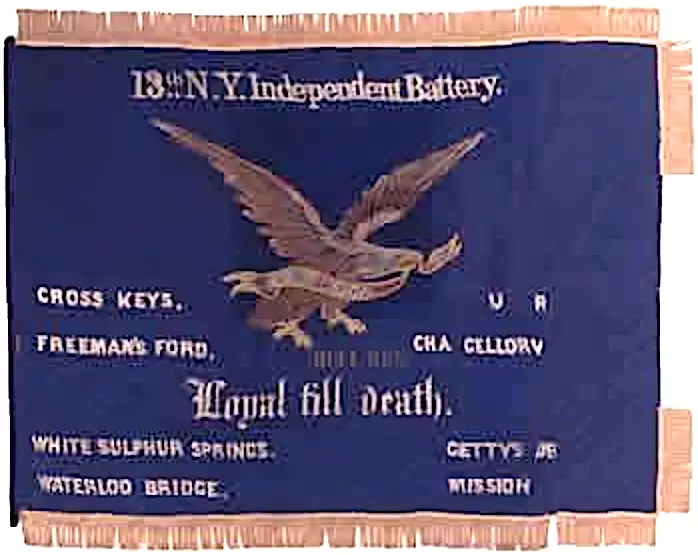
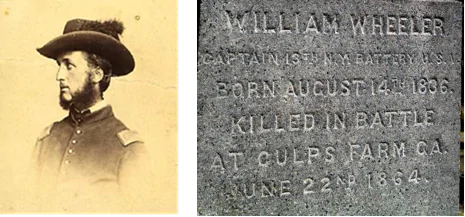
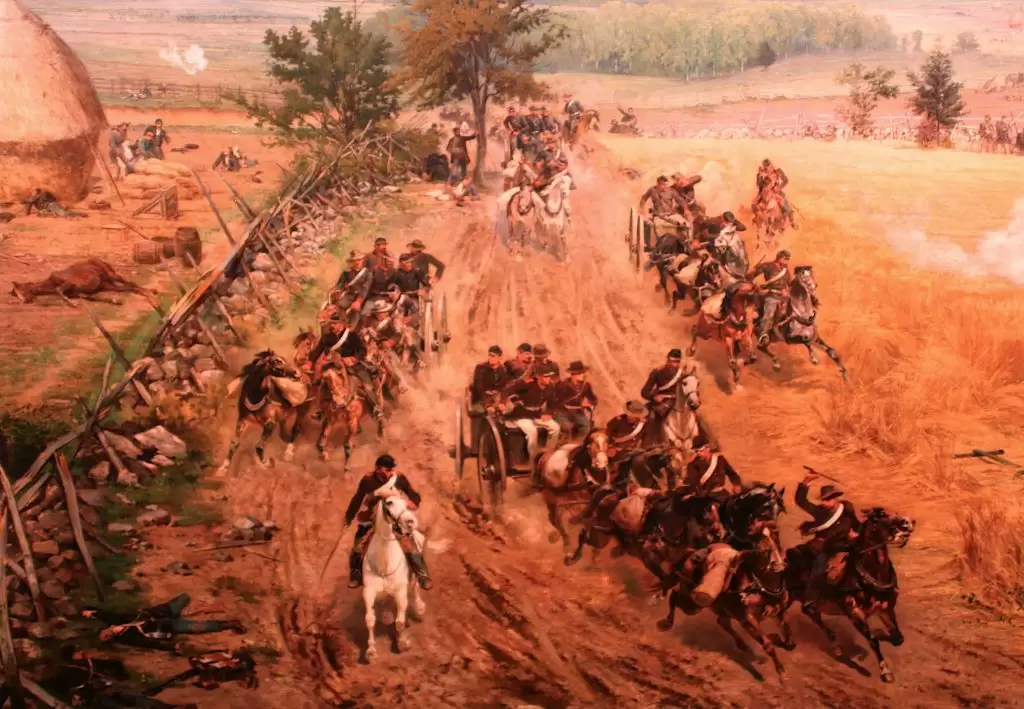
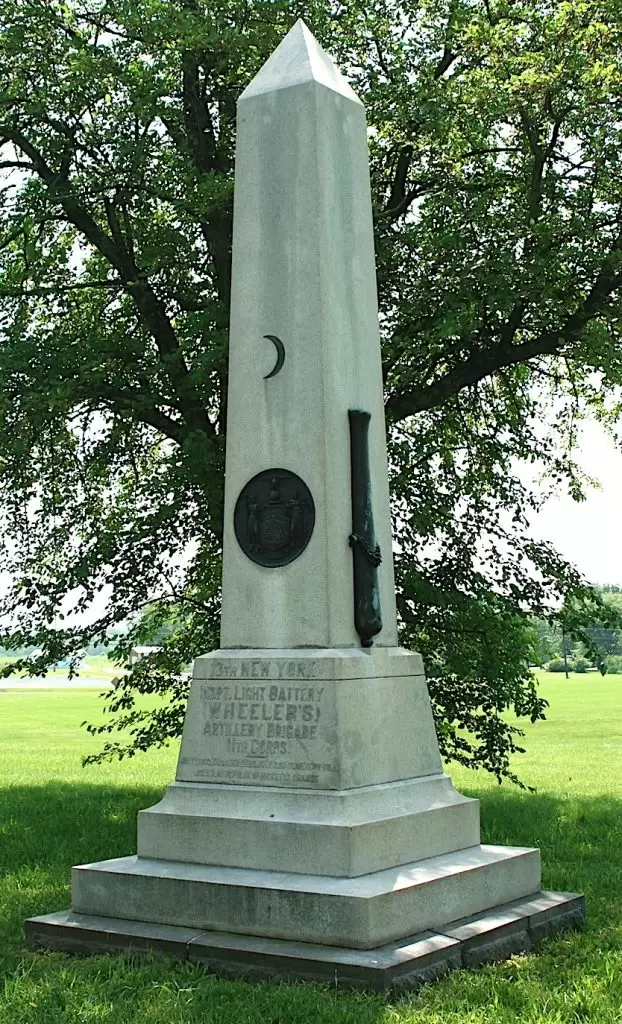
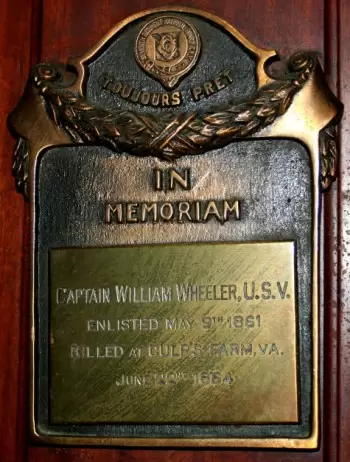
WHEELOCK, ELISHA ROE (1841-1904). Private, 13th Michigan Infantry, Company E. On September 1, 1862, he enlisted as a private at Jackson, Michigan, and mustered into Company E of the 13th Michigan the same day. He was discharged for disability on April 5, 1863, at Nashville, Tennessee. After the War, he moved to New York where in 1901 he applied for a pension, application 1,245,689, but there is no certificate number. Wheelock last lived at 69 Tompkins Avenue, Brooklyn. Section 188, lot 31635, grave 1.
WHEELWRIGHT, CHARLES N. (1844-1912). Private, 37th Regiment, New York State National Guard, Company H. Wheelwright, who was born in Maine, enlisted at New York City as a private on May 29, 1862. After mustering into the 37th Regiment that day, he mustered out three months later on September 2 at New York City.
He was a member of the Grand Army of the Republic, Mansfield Post #35. In 1906, his application for a pension was granted under certificate 1,120,263. His obituary in the Brooklyn Daily Eagle, which confirms his Civil War service and G.A.R. membership, indicates that he had lived in Brooklyn for forty years. His last address 1125 South Curtis Avenue in Morris Park in the Bronx. Section 7, lot 13169, grave 4.
WHEELWRIGHT (or WHEELRIGHT), CHARLES S. (1837-1883). Private, 1st New Jersey Cavalry, Company M. A native of England, he enlisted as a private and mustered into the 1st New Jersey Cavalry on September 1, 1863. As per Find A Grave, Wheelright’s wounds were discussed in a rare report of the detailed treatment of a Civil War soldier/patient from The Medical and Surgical History of the War of the Rebellion, Part III, Volume II, by United States Army Surgeon General’s Office (1883):
“Case 900. — Shot fractures of metatarsal bones. — Private C. S. Wheelwright, Co. M, 1st New Jersey Cavalry, aged 26 years, was wounded on picket duty near Warrenton, January 31, 1864, and admitted to Douglas Hospital, Washington, the following day. Acting Assistant Surgeon C. Carvallo, reported: “The ball entered the external dorsal aspect of the right foot anterior to the fourth tarso-metataisal articulation, and emerged posteriorly to the metatarso-phalangeal articulation of the big toe, having fractured the fourth metatarsal bone obliquely and passed beneath the others. Water dressings had been applied before admission and were continued. The foot became red. swollen, and painful, and the patient had considerable fever, anorexia, and pain. Epsom salts, weak diaphoretics, and the dressings soothed the symptoms considerably. On February 8th the distal fragment of the fourth metatarsal bone was found to be movable, but still attached by its phalangeal articulation, and an effort to remove it proved impossible without injuring that joint. It was therefore decided to leave its removal to nature, and a seton was conducted through both wounds in order to keep them open and promote suppuration. Subsequently an exacerbation of the symptoms manifested itself, after which the foot showed an erysipelatous tendency by swelling, redness, heat, and puffiness. A solution of nitrate of silver with acacia, constantly applied for forty-eight hours, finally subdued the inflammation, when a profuse discharge of healthy pus followed and gave great relief to the patient. Thenceforward the stimulants were substituted by tonics, and water dressings took the place of all former local applications. In a very short time all the swelling and redness had left the foot, and the wound showed such a healthy appearance and discharged such small quantities of pus that I entertained hopes the fractured bone would heal without being removed. I then applied Sentin’s starch bandage, which the patient still had on when he went home on furlough on March l5th. I afterwards heard that he was attacked with erysipelas and had entered Central Park Hospital, New York City.” The patient was discharged at the latter hospital May 20, 1864, and pensioned. Examining Surgeon J. T. Burdick, of Brooklyn, N. Y., certified that “the flexor tendons of the middle toes and some of the ligaments of the pedal arch were injured.” The pensioner was paid September 4, 1880.”
Wheelwright was discharged for wounds on May 24, 1864, at Central Park, New York. His last residence was 451 East 86th Street in Manhattan. He was survived by his wife and three children. In 1884, his widow, Mary Ann Furlong Wheelwright, who is interred with him, applied for a widow’s pension. Section 28, lot 10443.Wounded at an unknown place, he was discharged for wounds on May 24, 1864, at Central Park, New York. His last residence was 451 East 86th Street in Manhattan. He was survived by his wife and three children. In 1884, Mary Ann Furlong Wheelwright, who is interred with him, applied for a widow’s pension. Section 28, lot 10443.
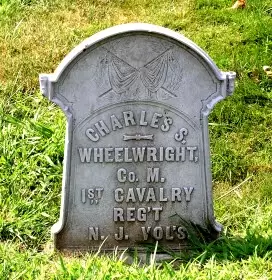
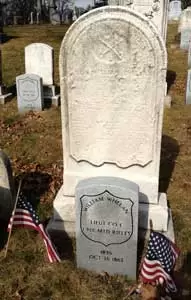
WHELAN (OR WHEELAN), WILLIAM (1835-1862). Second lieutenant, 1st New York Mounted Rifles, Company F. A native New Yorker, he resided at 93 Attorney Street in Manhattan before the War. Whelan enlisted at New York City on August 13, 1862, and was commissioned into the 1st Mounted Rifles that day. He was wounded in action on October 25, 1862, at Black Water Bridge, Virginia, and succumbed the next day. Section 115, lot 13536 (Soldiers’ Lot), grave 28.
WHERRY (or WHAREY, WHARRY), RICHARD (1832-1915). Private, 79th New York Infantry, Companies K and G. Of Irish birth and a laborer by occupation, Wherry was 5′ 7″ tall with blue eyes, brown hair. He enlisted as a private on May 13, 1861, mustered into Company K of the 79th New York, also known as the Highlanders, on May 28 for a term of three years, and was transferred into Company G on June 1. Wounded and captured at the Battle of Bull Run, Virginia, on July 21, 1861, he was listed as absent on the muster rolls, where he was borne as Richard Wharry, until February 1862. According to his pension application, he was wounded by buckshot to his right eye, damaging the optic nerve. He was subsequently treated on the battlefield and at a Richmond hospital by a doctor who died in a jail in Charleston, South Carolina. On May 24, 1862, he mustered out at Washington, D.C. During Wherry’s service, the 79th left New York for Washington, D.C., then served in the Army of the Potomac.
In civilian life, Wherry was a baker by trade. In 1890, he received an invalid pension, certificate 689,228. The Veterans Schedule of 1890 confirms his military service. He last lived at 414 63rd Street in Brooklyn but he also lived at the Soldiers’ Home in Bath, New York, from where he petitioned the Pension Bureau in 1908. His death was caused by nephritis. Section 204, lot 29588.
WHIPPLE, RICHARD FRANKLIN (1845-1912). Private, 23rd Regiment, New York State National Guard, Company E. Whipple, a Brooklynite by birth, served for 30 days when the 23rd National Guard was activated in 1863. After the War, he was a lumber merchant. As per his obituary in the New York Herald, veterans of the 23rd Regiment were invited to attend his funeral. He last lived at 245 West 107th Street in Manhattan. Although his widow, Viola Whipple, applied for a pension, application 1,603,264, it apparently was not certified. Section 119, lot 8456.
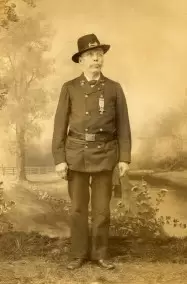
WHISTANCE (or WISTANCE), JOHN (1838-1919). Private, 13th Regiment, New York State Militia, Company I; 87th New York Infantry, Company D. Originally from England, Whistance became a naturalized citizen in 1860. According to his official discharge, which is owned by a descendant, and his pension record, he served in the 13th New York’s Company I, from May 6-August 6, 1861. He was listed as a shoemaker in the 1862 Brooklyn Directory. He re-enlisted as a private at New York City on March 6, 1862, and mustered into the 87th New York on that date. On September 6, 1862, his regiment was consolidated into the 40th New York. Taken as a prisoner of war on an unknown date, Whistance was listed on the roll of paroled prisoners at Annapolis, Maryland, from August 31 through October 31, 1862, as absent and not paid.
A boot-fitter as per the 1864 Brooklyn Directory, Whistance established a small shoe store that later grew into a large concern. He was a member of the Devin Post #148 of the Grand Army of the Republic. The Brooklyn Directory of 1888-1890 lists him as working in shoes. In 1899, he successfully applied for an invalid pension, certificate 1,000,590. In 1906, Whistance was working as a shoemaker. His last residence was 303 Myrtle Avenue, Brooklyn. Section 121, lot 7639, grave 443.
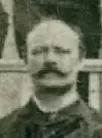
WHITE, EDWARD P. (or GEORGE B.) (1836-1869). Corporal, 11th New York Infantry, Company B. Born in New York State, White enlisted as a private on April 20, 1861, at New York City. He mustered into the 11th New York on May 7, was promoted to corporal on February 15, 1862, and mustered out on June 6, 1862, at New York City. His last residence was 100 19th Street, New York City. Section 107, lot 685.
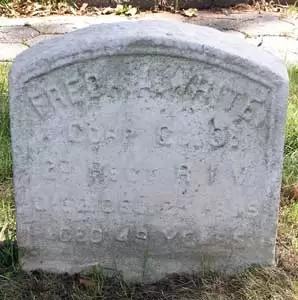
WHITE, FREDERICK (or FREDERIC) ALONZO (1846-1895). Corporal, 2nd Rhode Island Infantry, Company D. White, who was born in Blackstone, Massachusetts, was the oldest of five children. A resident of Providence, Rhode Island, he enlisted as a corporal on October 11, 1864, and mustered into the 2nd Rhode Island on October 31. He fought at the 1865 Virginia battles at Petersburg, Sayler’s Creek and Appomattox Court House. He mustered out on July 13, 1865, at Hall’s Hill, Virginia.
On September 5, 1866, he married his first wife, Abbie Mariah Moses, in Wickford, Rhode Island; they had two daughters before their marriage dissolved. In 1871, he married his second wife, Catherine Quinn, with whom he had six children. The 1879 Brooklyn Directory lists White as a shoemaker. As per an online biography by his grandson, White was a member of the Winchester Post #197 in which he held the leadership positions of quartermaster, sergeant major and junior vice-commander (December 4, 1890). His death certificate notes that he was married, was a foreman at a shoe factory, lived at 522 Fourth Avenue in Brooklyn and died from mitral regurgitation (heart disease). Section 135, lot 14964, grave 34.
WHITE, HENRY P. (?-1920). Corporal, 5th New York Cavalry, Company G; private, 23rd New York Infantry, Company C. After enlisting as a private at Owego, New York, on April 30, 1861, he mustered into the 23rd New York on May 16, and mustered out on May 22, 1863, at Elmira, New York. (The pension record indicates a date of enlistment as April 30, 1862.) He also served in the 5th New York Cavalry from December 23, 1863-July 19, 1865, where he rose to corporal on an unspecified date, and in the 35th Pennsylvania. He applied twice for an invalid pension, first in 1896 and then in 1907; it was granted under certificate 1,119,906. Section ?, lot ?.
WHITE, HIRAM G. (1843-1874). Sergeant major, 14th New York Infantry, Company A. Born in New York State, White enlisted as a private on April 23, 1861, at Utica, New York. On or about June 15, 1862, he was promoted to drum major of his company and transferred to the regiment’s Field and Staff. He was subsequently promoted to sergeant major four months later on October 13 and mustered out on May 24, 1863, at Utica. His last residence was 334 Navy Street in Brooklyn, New York. Section ?, lot ?.
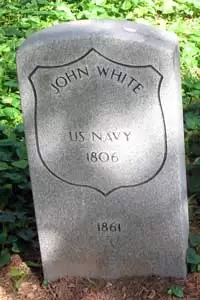
WHITE, JOHN (1806-1861). Acting master, United States Navy. A native of Ireland, White served as an acting master in the Navy beginning on October 7, 1861. He died of a tumor at Bellevue Hospital in Manhattan on October 30. Interment at Green-Wood was on February 4, 1862. Section 28, lot 10776.
WHITE, THOMAS (1842-1918). Private, 4th New Jersey Infantry, Company C. A native of Ireland, White enlisted as a private on April 24, 1861, and mustered into Company C of the 4th New Jersey Infantry three days later. He mustered out on July 31, 1861. White applied for and received an invalid pension in 1891, certificate 793,986. He last lived at 264 West 25th Street in Manhattan but died of arteriosclerosis at the Manhattan State Hospital. Section 199, lot 28664, grave 1.
WHITE, WILLIAM D. (1840-1902). Corporal, 13th Regiment, New York State National Guard, Company B. Born in Brooklyn, White enlisted there and mustered into the 13th Heavy Artillery on May 28, 1862. He mustered out after three months at Brooklyn on September 12. After the War, he was employed at the Soldiers’ Home in Bath, New York, and was a member of the George C. Strong Post #534 of the G.A.R. He last resided at 120 Raymond Street in Brooklyn. Section 12, lot 8277, grave 6.
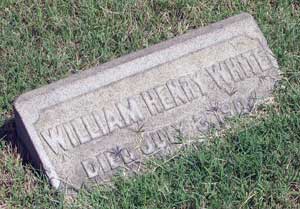
WHITE, WILLIAM HENRY (1844-1904). Private, 68th Pennsylvania Infantry, Company D. A native of New York City, White enlisted as a private on February 14, 1865, the same date that he mustered into Company D of the 68th Pennsylvania Infantry. He was discharged on June 9, 1865, at Hart’s Island, New York Harbor. His last residence was at the Hotel Marie Antoinette in New York City. Section 146, lot 30269, graves 1 and 2.
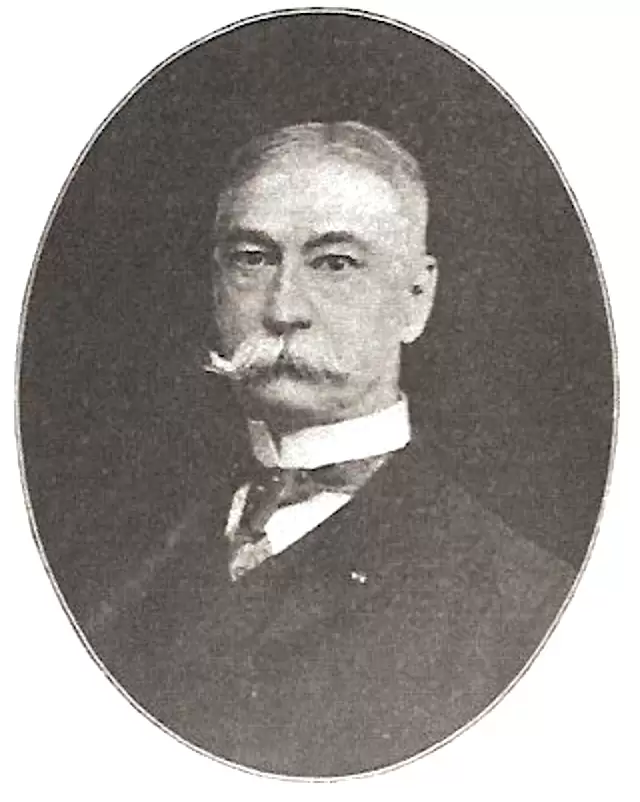
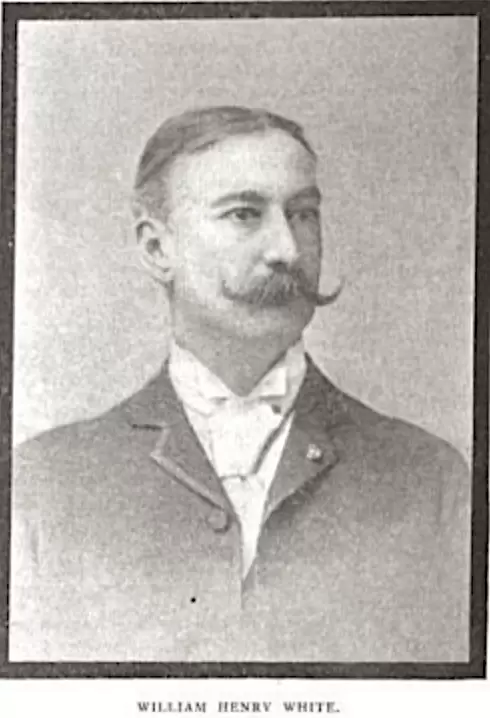
WHITEFORD, ANDREW (1836-1882). Private, 79th New York Infantry, Company K. Born in Scotland, Whiteford enlisted at New York City as a private on May 13, 1861, mustered into the 79th on May 28, and mustered out three years later on May 31, 1864, at New York City. As per the New York City Directory of 1877, he was a machinist. His last address was 594 11th Avenue in Manhattan. His death was caused by phthisis. Section 7, lot 5499, grave 1780.
WHITEHEAD, DANIEL RETON (1847-1903). Private, 37th Regiment, New York State National Guard, Company D. In the first of two tours of duty with the 37th New York State National Guard, Whitehead enlisted at his birthplace, New York City, on May 29, 1862, and served with Company D for three months until mustering out at New York City on September 2. When his unit was reactivated in 1863, he re-enlisted at New York City on June 18, 1863, engaged in battle in Pennsylvania at Sporting Hill on June 30 and at Carlisle on July 1, and mustered out at the expiration of his enlistment on July 22.
Active in the G.A.R., Whitehead belonged to the Henry M. Lee Post #21 where he was junior vice commander at the time of his death. According to his obituary in the Brooklyn Daily Eagle, which confirms his Civil War service, he lived in the Bedford section of Brooklyn for nearly thirty-five years and was a longtime member of the Janes M. E. Church in his community. The superintendent of the Art Students’ League of Manhattan, he also belonged to the Knights of Honor and the Ethan Allen Council of the American Legion of Honor, fraternal benefit organizations. His last residence was 355 Gates Avenue. Section 8, lot 10912.
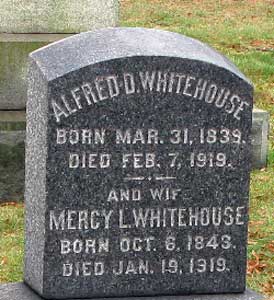
WHITEHOUSE, ALFRED D. (1839-1919). Private, 8th Regiment, New York State Militia, Company D. Whitehouse was born in London, England, and immigrated to New York in 1849. On April 23, 1861, Whitehouse mustered into the 8th Regiment, familiarly known as the Washington Grays. When the 8th passed through Washington, D.C., on its way to the front, he visited the Smithsonian Institute on July 15, stepped on the scale there, and recorded his height as 5’8″ and weight as 141 pounds.
An artist, Whitehouse made a 6″x 11″ pencil sketch of the officers’ tent outside Washington, D.C., as the regiment prepared for its first battle. On July 27, he was severely wounded in the right arm at Bull Run, Virginia, was left on the field as a prisoner of war, and had the arm amputated. Despite the amputation of his right arm (his drawing hand), he appears to have continued with his art. A sketch dated May 26, 1865, in pastel, depicts a battle from the Napoleonic Wars in which British Commodore Nelson helped defeat the French in the Battle of the Nile (1798). The 6″ x 9″ sketch shows details of the San Joseph, hand-to-hand combat, and period clothing and artifacts. On January 8, 1862, Whitehouse applied for and received an invalid pension, certificate 9,627. In the 1889-1890 Brooklyn Directory, his occupation is listed as painter. He last lived at 332 10th Street in Brooklyn. Section 157, lot 22141, grave 2.
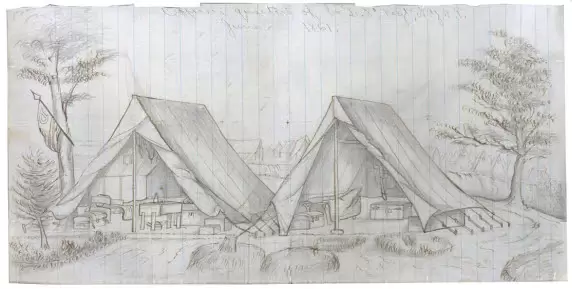
WHITESIDE, EDWARD (1839-1917). Musician, 5th New York Infantry, Company C; 146th New York. Whiteside, who was born in Manhattan, was one of eight children. Two of his brothers subsequently lived in Georgia and served in the Confederate Army. A book-binder by trade, he was 5′ 5″ with blue eyes and reddish brown hair. After enlisting as a musician on October 26, 1861, at Baltimore, Maryland, he mustered into the 5th two days later, and was a drummer for his company. On August 30, 1862, he was slightly wounded at the Battle of Second Bull Run, Virginia. When he was transferred into the 146th New York on May 4, 1863, he deserted. He and others protested the transfer arguing that they signed up to fight with the 5th not the 146th, but those soldiers who enlisted for three years were transferred despite their objections.
Returning to Brooklyn after the War, Whiteside was employed as a book-binder at the Brooklyn Daily Eagle for 45 years and was active in the Democratic Party. He continued his military affairs in 1867 as a member of the 7th Regiment, Company K, the 7th Drum Corps, and the 5th New York Veterans. His last residence was 200 Monroe Street in Brooklyn. Section 138, lot 26910, grave 1.
WHITFIELD, EDWIN AUGUSTUS (1840-1924). Private, 7th Regiment, New York State National Guard, Company B. Born in New York City, Whitfield was called up for duty with the 7th New York State National Guard for three months beginning May 25, 1862, and again for 30 days in 1863. In 1909, he applied for and received an invalid pension, certificate 1,158,569. His last residence was on 74th Street in Manhattan. Section 21, lot 4701.
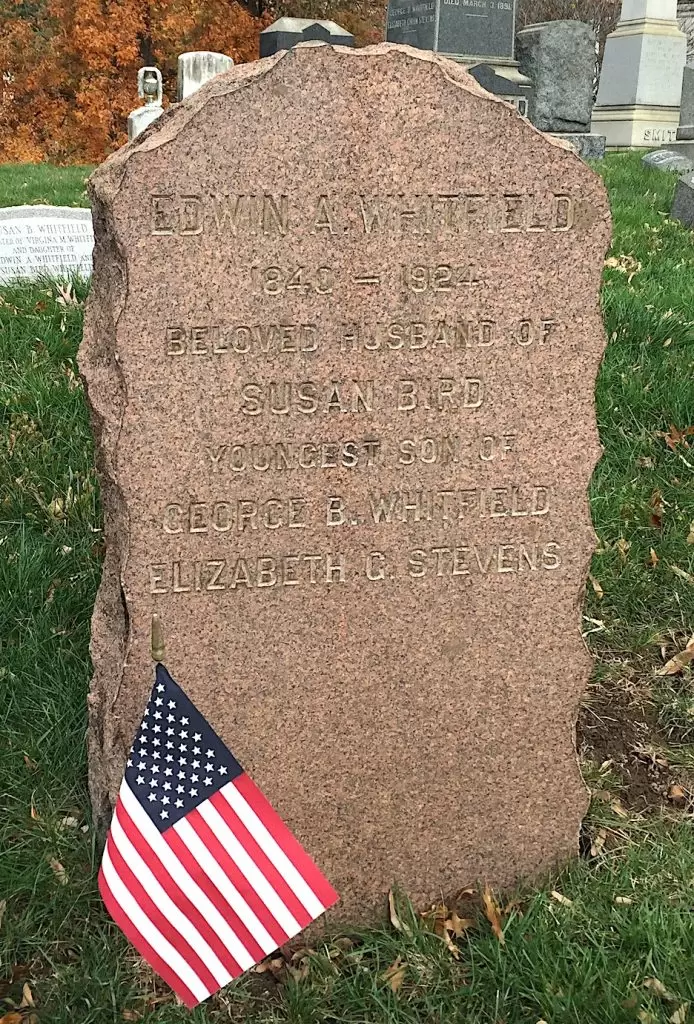
WHITIN, HENRY (1826-1885). Private, Independent Corps of Cadets. Originally from Whitinsville, Massachusetts, a town named for the Whitin family who owned a mill there, he joined the Independent Corps of Cadets in Massachusetts on April 12, 1859. That organization was an officer-producing institution from the Revolutionary War through World War II. During the Civil War, Whitin was a merchant and Boston resident when the Corps was activated on May 26, 1862. The cadets were assigned to Fort Warren in Boston Harbor where they guarded Confederate soldiers. He mustered out on July 2, 1862. Whitin last lived in Morristown, New Jersey, where he died from angina pectoris. Section 66, lot 6509.
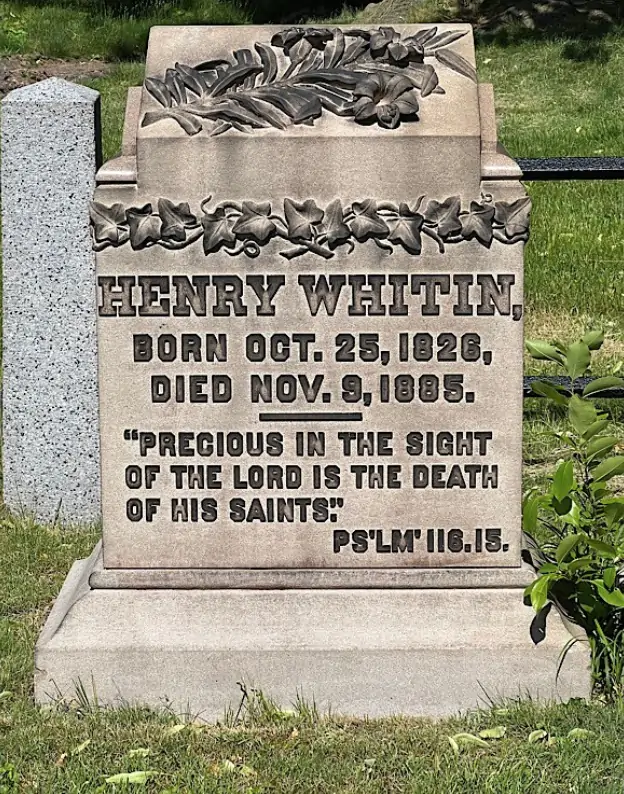
WHITING, CHARLES A. (1845-1926). Private, 145th New York Infantry, Company A; 150th New York Infantry, Company K. After enlisting as a private at New York City on August 28, 1862, he mustered into 145th on September 11, and transferred into the 150th on December 9, 1863. His last address was on West 79th Street in Manhattan. His death was caused by uremia. Section 153, lot 21618.
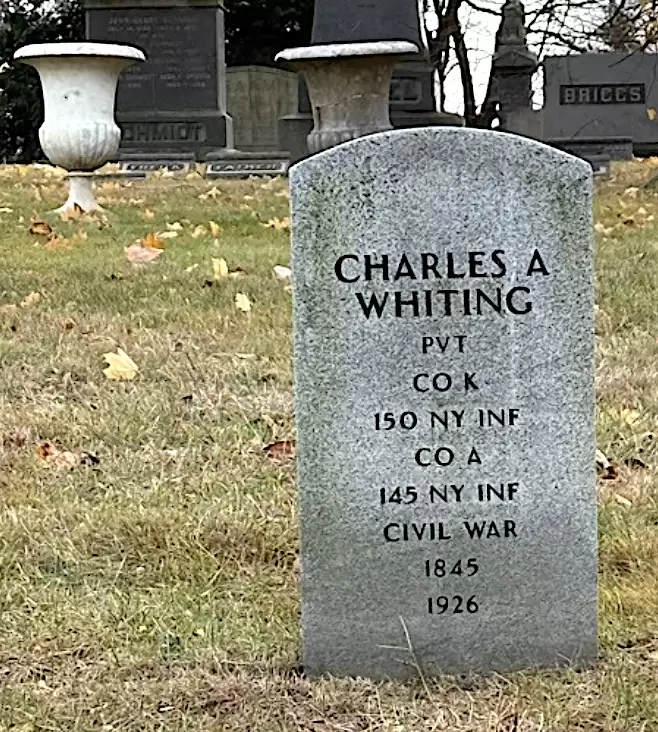
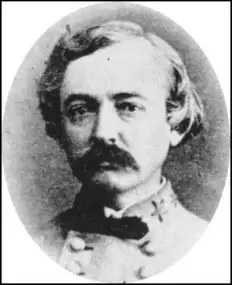
WHITING, WILLIAM HENRY CHASE (1824-1865). Major general, Confederate States of America. Originally interred at Green-Wood, his remains were removed to Oakdale Cemetery in Wilmington, North Carolina, on June 16, 1900. Born in Biloxi, Mississippi, he was a graduate of English High School in Boston, Massachusetts, at age 12, and a graduate of Georgetown at age 16. Admitted to the United States Military Academy as an at-large-cadet, Whiting graduated July 1, 1841, first in his class. On July 1, 1845, he was appointed second lieutenant of engineers, and was promoted to first lieutenant on March 16, 1853. During that time, he was involved in constructing seacoast defenses in Maryland and Florida, surveying the Big Bend area of Texas, and building fortifications in San Francisco, California. He was made captain, corps of engineers, in 1858 and spent the five years prior to the Civil War improving canals and river defenses in North Carolina, South Carolina, Georgia and Florida. He resigned from the United States Army on February 20, 1861.
After he helped improve defenses at Fort Sumter, South Carolina, for the Confederacy, Whiting served under Major General Joseph E. Johnston as chief engineer of the Army of the Shenandoah. He led a small division during the Peninsula Campaign, then was put in charge of the Military District of the Cape Fear River, North Carolina, where he built Fort Fisher into the South’s strongest citadel. During his service, he was promoted to major on March 16, 1861, to brigadier general on July 21, 1861, and to major general on April 22, 1863. He was wounded and captured on January 15, 1865, when Fort Fisher fell. From his jail cell, he requested an investigation of his superior, General Braxton Bragg, questioning his actions in assaulting the fort. He died of debility and diarrhea on March 10, 1865, at Fort Columbus, Governors Island, New York Harbor. Robert Whiting, his brother, was in charge of Green-Wood Cemetery in the 1860s.
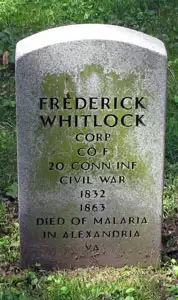
WHITLOCK, FREDERICK (1832-1863). Corporal, 20th Connecticut Infantry, Company F. Born in New York and a resident of Southbury, Connecticut, Whitlock enlisted as a corporal on August 15, 1862, and mustered into the 20th Connecticut on September 8. He died of malaria in Alexandria, Virginia, on January 24, 1863. Section 78, lot 9033.
WHITLOCK, JAMES SEWELL (1842-1919). Private, 84th New York (14th Brooklyn) Infantry, Company A; 5th New York Veteran Infantry, Company I. A New York native, Whitlock first saw service in the 14th Brooklyn after he enlisted at Brooklyn as a private on August 20, 1862, and mustered into the regiment two days later. According to his New York Times obituary, he served with his regiment at Bull Run, Virginia; Antietam, Maryland; and Gettysburg, Pennsylvania. On June 2, 1864, he transferred into the 5th Veterans from which he mustered out on May 31, 1865, at Alexandria, Virginia.
After the war, he was a commander for several terms in the William Rankin Post #10 of the G.A.R. In 1891, he successfully applied for an invalid pension, certificate 720,235. As per his obituary in the Brooklyn Standard Union, which confirms his Civil War service in the 14th Regiment and identifies him as one of the original “Red Leg Devils,” he was among only 39 survivors of the regiment at the time of his death. Whitlock last lived at 413 Bergen Street in Brooklyn; his death was attributed to throat cancer. James was survived by his widow, two sons, Arthur and James, and a married daughter. Mary Whitlock applied for and received a widow’s pension shortly after his death in 1919, certificate 879,515. Section 12, lot 8568, grave 1.
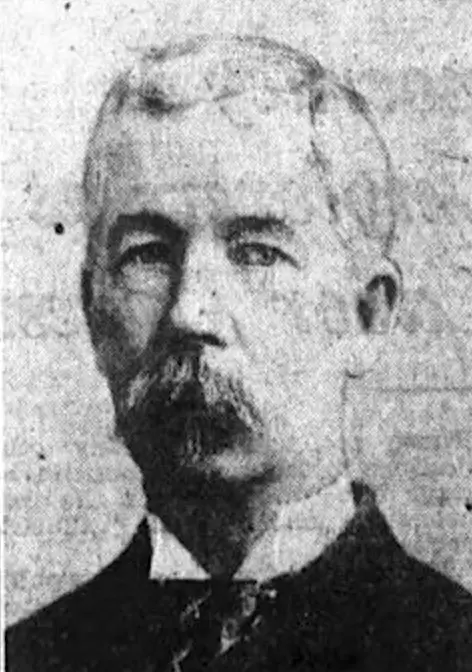
WHITLOCK (or WHITLACK), THADDEUS K. (1833-1916). Corporal, 71st Regiment, New York State National Guard, Company D; 5th New York Cavalry, Company F. Whitlock enlisted as a corporal on May 27, 1862, mustered immediately into the 71st Regiment, and mustered out with his company after three months of service on September 2 at New York City. On September 19, 1862, he re-enlisted as a corporal at New York City, mustered into the 5th New York Cavalry seven days later, and mustered out on June 17, 1865, at Winchester, Virginia.
As per the 1882 Brooklyn Directory, Whitlock was a salesman living at 413 Adelphi Street; the 1910 census notes that he was a salesman living on Greene Avenue in Brooklyn. In 1906, he applied for and received an invalid pension, certificate 1,130,217. His obituary, which confirms his Civil War service, indicates that he lived in Mount Vernon, New York, but died in Ocean Grove, New Jersey. Section 169, lot 15265.
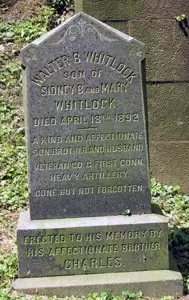
WHITLOCK, WALTER B. (1844-1892). Corporal, 1st Connecticut Heavy Artillery, Company G. Born in Brooklyn and a resident of Southbury, Connecticut, he enlisted as a private and mustered into the 1st Connecticut Heavy Artillery on October 21, 1861, and was promoted to corporal on March 9, 1862. He re-enlisted on January 26, 1864, and mustered out at Washington, D.C., on September 25, 1865. He last lived in New York City. Section 78, lot 6252.
WHITLOCK, WILLIAM (1819-1892). Sergeant, 25th New York Infantry, Companies F and I. After Whitlock enlisted at New York City as a private on May 20, 1861, he mustered into Company F of the 25th New York on June 13, and transferred into Company I on or about June 30 of that year. He was promoted to sergeant at some point and then reduced to the rank of private on an unknown date. He was discharged for disability on December 4, 1862, at Baltimore, Maryland. On April 13, 1863, his application for an invalid pension was approved, certificate 130,775. His last residence was 23 Willow Street, Brooklyn. Section 90, lot 421.
WHITMAN, IRA A. (or N.) (1844-1889). Private, 8th Regiment, New York State National Guard, Company K; 176th New York Infantry, Company B. Whitman enlisted on May 29, 1862, at New York City, mustered into Company K of the 8th Regiment, and mustered out after three months on September 10 at New York City. On September 30, 1862, he re-enlisted as a private at New York City, mustered into the 176th New York on December 18, and was discharged on February 15, 1864. After the War, he belonged to the Grand Army of the Republic (G.A.R.)’s James C. Rice Post #29. His last residence was 47 West 133rd Street in Manhattan. Section 188, lot 19937.
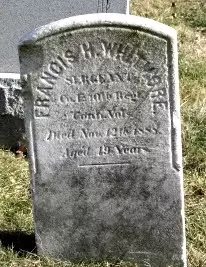
WHITMORE, FRANCIS H. (1841-1888). Sergeant, 10th Connecticut Infantry, Company E. Born in England and a resident of Southbury, Connecticut, Whitmore began service as a private on December 9, 1864, when he was drafted into the 10th Connecticut. On August 7, 1865, he was promoted to sergeant of his company and mustered out on August 25 of that year.
The 1880 census indicates that Whitmore was a painter; the 1887 Brooklyn Directory notes that he was a paperhanger. His last residence was 159 9th Street, Brooklyn. His death was caused by asthenia (general weakness). Although Elizabeth Whitmore applied for a widow’s pension in 1909, application 926,281, it was never certified. Section 200, lot 24226.
WHITMORE, WILLIAM TITUS (1841-1913). Acting assistant paymaster, United States Navy. Born in Middle Haddam, Connecticut, Whitmore’s obituary in the Brooklyn Daily Eagle, which confirms his Civil War service, notes that his maternal grandfather, Joseph Dart, who commanded a company at the New Haven Alarm, was a soldier in the American Revolution. The census of 1860 reports that he lived in Middle Haddam with his parents and extended family and was a post office clerk. During the Civil War, Whitmore was an acting assistant paymaster in the United States Navy. He enlisted on August 18, 1862, served on the USS Valley City and the USS Mackinaw, and was discharged on October 3, 1865.
After the War, Whitmore married in 1869, and settled in Brooklyn. His obituary notes that he was a representative of woolen mills in New York City. The 1880 census shows that he lived in Brooklyn, was married with three young children and was a wool dealer. As per the 1900 and 1910 censuses, he owned his house at 142 South Portland Avenue in Brooklyn and was a merchant in the woolens industry; in 1900, he lived with his wife, two sons and a servant and had been married for 30 years. He had retired from business at the time of his death.
Active in community life, Whitmore was for more than thirty years a deacon of the Lafayette Avenue Presbyterian Church, a teacher at its Sunday school, and treasurer of the Missionary Society at the school. He last lived at the South Portland Street address. According to the affidavit of his wife Elizabeth, filed with his will, he left an estate of less than $100. Section 187, lot 19745.
WHITNEY, EDWARD JENNINGS (1839-1895). Lieutenant colonel by brevet; surgeon, United States Volunteers Medical Staff. A native of New York, he was commissioned as an assistant surgeon into the United States Volunteers Medical Staff on November 7, 1862. He rose through the ranks being promoted to surgeon on April 13, 1863, and then promoted by brevet to lieutenant colonel for “faithful and meritorious service” on October 28, 1865. He served until mustering out on November 3, 1865. His last residence was 100 Lafayette Avenue in Brooklyn. Section 190, lot 26965.
WHITNEY, HIRAM REED (1830-1879). Corporal, 132nd New York Infantry, Company F. Hiram, who was also known as Harry, was born in Poughkeepsie, New York, to Marcus and Mary Ann Stayner Whitney. His father was a stone-cutter and he had older sisters, Ann, who was born in Quebec in 1820, and Louisa, born in Poughkeepsie in 1827, and an older brother, Mariner, who was born in Schenectady, New York in 1925. Hiram was baptized by the Episcopal Diocese of New York on October 12, 1831. Prior to the Civil War, Hiram was a butcher.
During the Civil War, Whitney enlisted at New York City as a private on August 5, 1862, and mustered into the 132nd New York Infantry on October 4, 1862. As per his muster roll, he was 5′ 5½ tall with blue eyes, brown hair and a fair complexion. His regiment served mostly in North Carolina where it suffered more than 90 casualties at the Battle of New Bern in February 1864. His sister Ann died in the autumn of 1864; Ann’s husband, Henry Manning served with the 11th New York Cavalry where he held the rank of saddler sergeant. Whitney was promoted to corporal in January 1863 and mustered out on June 29, 1865, at Salisbury, North Carolina. Sometime after 1865, he married Isabella.
The letters of Hiram Reed Whitney were donated Gettysburg College in June 2022 by Edson Whitney, a second great-nephew of Hiram and a 1970 graduate of the school. A 2022 summer Brian Pohanka intern and student at the college, Danielle Russell, transcribed the letters and provided biographical information about Hiram and his family which she hopes to share with those interested in the Civil War Era. The information on Hiram Whitney’s life, based on Ms. Russell’s research, is the basis for much of this biography.
The following letters are a sampling of those that Hiram wrote to his brother Mariner (who did not serve in the Civil War). The letters, as transcribed by Danielle Russell, contain the original grammar and spelling. Below are among the first of Hiram’s letters written before the regiment reached New Bern. This letter was written from Virginia in October 1862 and describes the muddy living conditions and his first experience with combat:
Dear Brother
Suffolk Virginey Oc 13th 1862
We arived in Baltimor 29 of Sepetember
we arived hear Oc 5th it is a Bad place Bad Wate
Mudy ground plenty foug and raine, we have not
drilled sense we arived her only on forts and
ditches with picks and spades wear 25 milles
from the black warter river the rebles are
hear in stunnd force last friday weake
the pickets had a fight witthem kilingn 6 of
them and wounnned 30, of them we are strangley hear
in the neighhood of 28 thousand men
right to E Tueker tell her i sent $5.00
from Baltimoe the 30th of setember tell
the folks that can well right to Ann former
i see right and maning is Washington
weare about 45 milkes of Richmond, the generul
gave strickd orders to Day to be redeness
[pg. 2]he exptes to go to the black Warter in
tow Walker a drive the rebles out of that place
the countrey is in a bad conditon hear
thare is plenty of seepic hear we gad a fuenril
this morning of one of the Ohio Boys the hospital,
hear ant as good as the parke Baracl
salt horse and porke, burndsides minan,
fires is our food it has rained the last 20 hures
we expeto stay hear this winter, if not we will
move on to meat McBridges genrial preck
is in command, pen, i will send you $20.00
to take care of four mee i will send moor
when i get paid if any thing shoud hapen to me
Send to Captain T.F. Goodwin Company F
2nd regment N.Y.V. Empire Brigade Cornal Classen
Direct to Suffolk Vegene or do whar to campe
classen give my Love to all the folke
Hiram Whitney.
Whitney had previously written his brother that he was suffering from rheumatism and that thieves had stolen many of his belongings. This letter describes the gathering of forces and what he would like his family to send him:
Dear Brother Suffolk Va. Dec 7, 1862.
I recived your Letter on Saturday the 6th i was very
glad to hear that you ware all well and you got the
Likeness of mine Ann made a misstake about me being in
the hospital i would not go thear we have two in thear now near
Ded i have wrote to Anne and Libe since i wrote to you the person
sent the Box to was Mrs. Pynes ^her husband is^ a friend and bedfellow of mine
and she recived a recepet for the same thear is nothing now ear
present except the arivel of the first regment on saturday morning with
seald orders we have hear nearley 40 thousand men hear now
i supose that we will move soon in the Direction of petersburgh,
gus smith, formerly street comishner in N. York, is in command
thear with a strong force of rebels thear will be some hard
fighting be fore we get to fredericksburgh we have not ben paid of
yet we expect it on the 15th i will send a Letter to Louisa next
week. i am very good helth now, if you can aford it send
me a few things i want i will pay you when i receive mine
with out discomoding your self i have got flanen shirts of
from the quartermasters department i am out of tobacco,
[pg. 2]chewing and smoking, both i would Like to have some
apples and butter and peper and msstrd send me a strong plaster
for my back and brandith pills i want socks very Bad
a pare of gloves chus also if you can get a good ham i would
Like to have it if you send them put the butter in a tin
Pail, pack the things in tight direct to H. Whitney
132 Rg. N.Y.S.V. Co. F Spinnolia Brigade Suffolk Va.
Ann sent me a Letter that she got from May to read
it is very good for one so young thear is a expedition to go out
of hear soon we cant tell ware but we geota go with it
it is for 13 days we got to cary our french tents on our Back.
they are in 4 piecs 4 men carry a pics. dodges rifelmen had
a fight on the 2nd this side of Black warter, takin 30 prisners
and killing 19 of them with the hole of his face cut of nose and all
with a sabre cut it is very cold hear to day but clear
no more at present
give my Love to all
H.R. Whitney
Ps Marner when i get Paid i will send it in a Letter
I shant trust to the express
if thear should be any thing happen to me my
[pg. 3]Discriptive List will tell you all conerning
My Back pay and wats Left of my clothing
and wat i hav drawn you are the one which i will
bear it to in care of Capitin Goodwin, ore any one that
of my company that can sware that i served in this co.
wright soon. good by
[Following is a transcript of the ½ piece of paper included in this letter]i send wat Clothing i have drawn
from August the 11th 1862 up to this Date,
2 pair of pants =
4 pairse of socks =
1 over coat =
1 Dress coat =
2 pairse o shoes =
1 cap =
1 Blous =
1 cantein =
1 Haver sack = gave this to Mariner.
1 Blanket = My sargent Jones
2 pare of Draws = has got the List of all this
1 Knapsack 4 shirts = i have not had no ^Bed^ tick
The first page of this letter to Mariner describes the journey to New Bern, North Carolina, where his unit experienced most of its action:
Dear Brother New Buren North Carolina
Januray 11th 1863
it is some time since i wrote to you a Letter this is the
first chance i have had sence we Left Suffolk we started
to weekes ago to Days at 11 oclock and march 19 milles
on that Days and so on till we march 63 milles in
3 Days and nights till we got to the schwan river on
Halleys farm and then embarked on 7 transports Down
this river into albemarel and into pamleco rounds and then
into ruize river and a cros Hattress inlet up to new buren
it was a very hard tramp and a rough passage we get out
of ginbe on the tramp and then seceshhad to suffer in
the poltrey Bacon Whiskey Tine un till we got a bord
of the gun Boats thare was not a Holey crew of troupes
a Borde of Hundred of us stored on way in a small strener
we fared splendid on Hard Bread coffe and raw salt porke
the Brigade had 6 Regments in all most all the troupes
has Left has Left that place and pickes Divison
we are in mger general fosters Division now, god news
ware next they will sned us the talk is near to
Wilmington, this is a very nice city for the south…
This letter demonstrates how the family at home also experienced illness and suffering. In the first page of this letter, Hiram has learned of his sister’s death. Apparently, there is illness in his regiment as well:
Camp Classen Out. Post.
Newbern N.C. Oct 23rd / 64
Dear Brother i recived your Letter of
the 13th on the 18th informing of
dear sisters death it is wat i ave
been Looking for this month back
i am very sorey that i could not
get home to see her befor she died
but i could not + i am satisfied
that all was don that could be don
i hope she is in a better world +
in peace it is very Little She had
in this one thing She is out of the
way of that dam brute the feaver
is very bad yet it has made its
appearence in our camp this week
there has been one death on thursday
+ one found dead this morning in
bead 7 of my companey reported
this morning sick at surgons call
with some kind of fever it has swept
of one thousand in the city…
Whitney died in 1879 at St. Luke’s Hospital in New York City. His death was attributed to stricture of the urethra. His funeral took place at 142 East 84th Street in New York City at the home of his sister, Louisa Whitney Wright. He is buried with Charles Washington Wright, Louisa’s husband, who died in 1868; Wright’s father was a famed engraver, Charles Cushing Wright. The collection of Whitney memorabilia is archived under the heading “Whitney Family Civil War Letters” at Gettysburg College where it is available to researchers. Of the 46 letters there, 37 were written by Hiram to his brother Mariner. Section 15, lot 17263, grave 149.
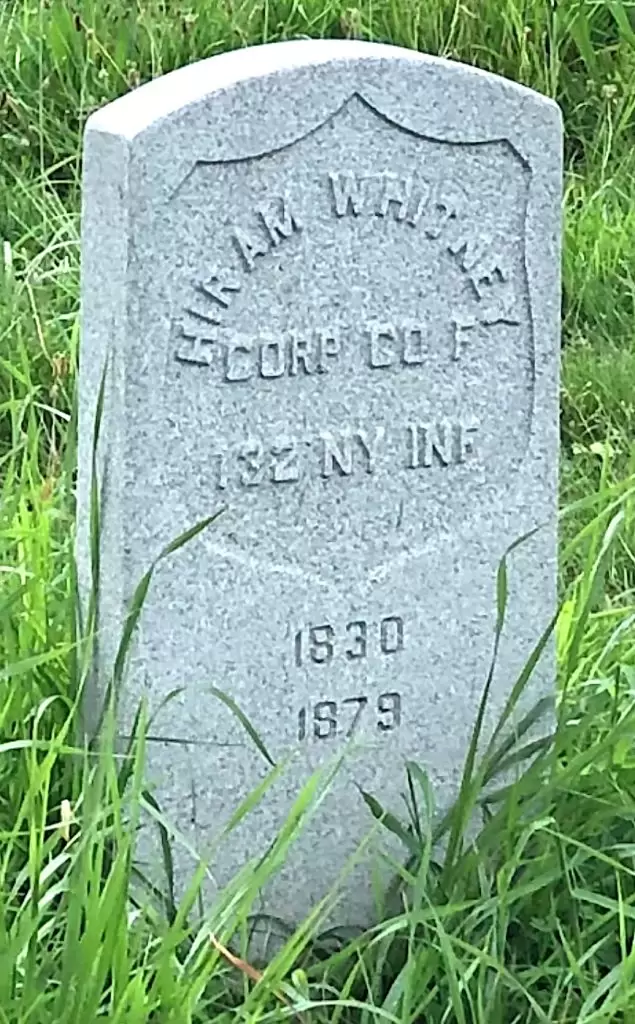
WHITNEY, JOHN H. (1840-1891). Sergeant, 9th New York Infantry, Company B. A New York native, he enlisted as a private at New York City on April 23, 1861, and mustered into the 9th New York on May 4. The Hawkins Zouaves, led by Colonel Rush C. Hawkins from 1861-63, formed the nucleus of the 9th and gained a reputation as a fighting regiment. Whitney fought in Virginia at Big Bethel and Newport News, and at Hatteras, North Carolina, with Burnside’s expedition. He was also at Roanoke Island, Winton and Camden, North Carolina, and at South Mountain, Maryland.
At the Battle of Antietam, Maryland, on September 17, 1862, Whitney was wounded in the abdomen, a permanent disability that kept him confined to bed for a good part of ten years. The 9th encountered the 3rd Georgia, commanded by Colonel Wright, at three skirmishes, the first being at Dismal Swamp, North Carolina. Antietam was the third meeting of the two regiments at which time Whitney recalled that the 9th got the upper hand “in each engagement defeating it badly, and capturing a number of its men.” Twice hospitalized, the first time was at Smoketown, Maryland, on January 23, 1863. After his hospitalization at Frederick, Maryland, on May 10 of that year, he was discharged from Hospital No. 1 on June 11.
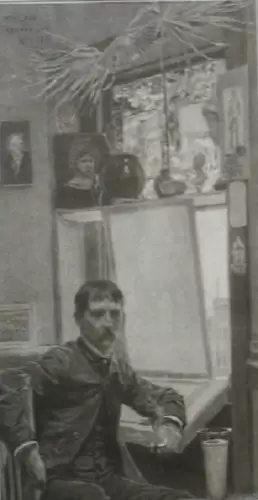
Whitney was promoted to sergeant at some point during his service. Relying on his War experience, he wrote The Hawkins Zouaves, published in New York in 1866. Whitney was also an instructor at Cooper Union in Manhattan. In the 1880 U.S. census, he was listed as living in Chappaqua, New York, and was employed as an engraver for Harpers Magazine. He joined the Lafayette Post #140 of the G.A.R. in 1881. In describing one of his experiences in the G.A.R. book, he wrote about a storm on October 31, 1861, while detailed at Hatteras Inlet:
In War there are many dangers besides those before the cannon’s mouth. On the 31st day of October, 1861, I was detailed Sergeant of the Guard, with three corporals and twelve men, to relieve Hut Picket, an outpost on Bald Beach, Hatteras, N.C., about six miles above the inlet. Bald Beach was a narrow stretch of sand dotted with distorted cedar stumps from two to ten feet high, remnants of a forest that had existed beyond the memory of the most ancient yokels. The hut was a framework of saplings split and woven over with rushes, six feet wide and fifteen feet long, the only aperture a doorway five feet high, facing the ocean and standing on the ridge thrown up by the tide. The hut had been used by wreckers. An immense school of porpoises was passing near the shore for half a day in review, going northward, and an old native said, ‘Storm, mighty smart storm.”
After dark it began to blow from the southeast, gradually increasing in violence, and the tide steadily rising. The last relief had been posted about seven o’clock. By ten o’clock the storm was a wild one. The rain was hurled along in horizontal fury, the lightning increased in nearness and brilliancy, and the thunder became one continuous crash. Thinking so furious a storm must soon abate somewhat, we all sat around a good fire in the middle of the hut, telling stories, and now and then tasting the circle of sweet potatoes and yams roasting beneath the hot ashes. Our muskets leaned against the rear end of the hut, we expecting to be able soon to relieve the sufferers on the posts. A schooner was wrecked within two hundred feet of us, high above low-tide mark, and every time a breaker heaved her, a huge bow chain slashed and clanked so loudly about her bowsprit we heard it above the storm, which led to her discovery by us; but the vivid lightning showed us no signs of life or death on or about her, so we resumed our fire, our stories, and our yams. Omitting several incidents, 11.30 o’clock arrived, and while we were bursting our sweets and cracking ancient ‘chestnuts’ with laughter inside, the big chain whanked (sic) and clanked above the roar of the storm without, a huge breaker rolling high as the doorway came smashing in. We were on our feet in an instant. It obliterated the fire with the hiss of a thousand serpents, and slashed up to the tops of our muskets behind us. It left us soaked and blinded with steam and the fluff of ashes. I stepped out to reconnoitre, and found every breaker going over the dunes, where the sea had cut a hundred streams, the water rushing down beyond to Pamlico Sound, not a mile away. The lightning showed us the ocean, white as snow far to the rough horizon. The only spot not covered with breakers and running water was a small triangle of sand directly behind the hut, where I stationed the guard, with their muskets now leaning against the outside of the same wall that had supported them inside, and we huddled close there till daylight. I drew in No. 1, but what had became of the other men? Could I find them and do anything for them? We knew they must be in running water. Such water, such wind and rain! I called for volunteers, and three men soon responded. We started without arms or belts, and were plunging into swift runnels, waist deep, that often threw us down, and we extricated one another with difficulty. It was impossible to stand against the wind, and the roar was deafening. The breakers threw up the sand, and the gale hurled it like particles of steel that cut the skin. When we had gone what we thought was far enough, though we could not see but little for the blinding sand, we shouted singly and in concert. But no response. Again and again we called, screaming till our voices broke. No reply. Good Heavens! The men must be drowned! Sadly we struggled and floundered back, faces cut, eyes blinded, mouths and noses choked with the piercing sand. By morning the storm had ceased, but the tide and breakers were still high. Again I went out, and found the men, nearly exhausted, clinging to the tops of stumps near their posts. I took them in, for there was no danger that the rebels would come down upon us through that running sea then covering Bald Beach and uniting Pamlico and the Atlantic. The men had heard us in the night, and shouted back, but their puny voices were nothing against the gale, for every sound they made, it tore to shreds and dashed behind them.
At daylight, a son of Captain Stowe, a native, came to the hut and said, ‘Farthur sez ef ye don’ cum in ye mout git drownded. The camps hez all been flooded out an’ sum sojers drownded.’ I said I could not then withdraw the guard for so little danger. He went away but returned again. ‘Farthur sez ef ye don’ cum in ‘fore half an hour ye kaint git in at all. Need a guide, or ye’ll get lost in the water.’ He hung around and looked so solemn I decided to take the men in. Duncan’s Creek, that’s what we had crossed on a stick of timber the morning before, was now a quarter of a mile wide. And not in the same place after the water subsided. We climbed sand hills, or floundered through streams neck deep, going several miles to make one mile before we reached any solid earth. I waited at a ruined house, but the sergeant of the new guard refused to relieve me there, because it was not the Hut Picket, and said he would report such a proceeding. I replied that I should report it first. I might add that a new inlet was cut across the island near Fort Clarke, about a mile north of Hatteras Inlet, which also was cut out by just such a storm about twenty years previous.”
In 1864, his application for an invalid pension was approved, certificate 31,847. He last lived at 37 East 20th Street in Manhattan. His widow received a pension after his death, certificate 337,597. Section 153, lot 19456.
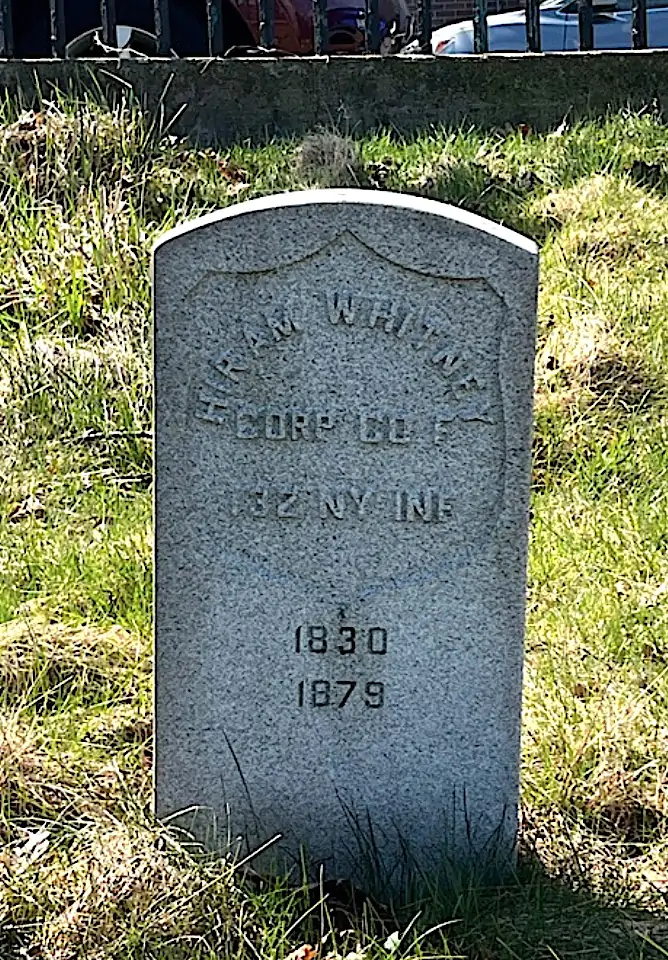
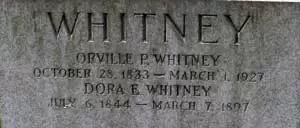
WHITNEY, ORVILLE PORTER (1833-1927). Private, 8th Regiment, New York State Militia, Company B. Whitney, who was born in Massachusetts, served with the 8th Regiment’s Militia. Other details are unknown. He was a member of the Brooklyn City Post #233 of the Grand Army of the Republic. In 1904, he successfully applied for a pension, certificate 1,097,286. As per his obituary in the Brooklyn Daily Eagle, members of his G.A.R. post were invited to attend his funeral. His last residence was 255 Halsey Street in Brooklyn where he died at age 94. Section 204, lot 29610, grave 1.
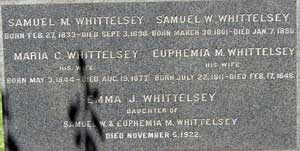
WHITTELSEY, SAMUEL M. (1833-1898). First lieutenant, 71st Regiment, New York State National Guard, Company A. A New Yorker by birth, he enlisted there on May 28, 1862, as a second lieutenant, was immediately commissioned into the 71st New York State National Guard, and mustered out on September 2 of that year at New York City. On June 30, 1863, he was promoted to first lieutenant and commissioned into the same unit and company. He mustered out the next month on July 22 at New York City. As per the 1877 New York City Directory, he was a weigher. He last lived at 252 Livingston Street, Brooklyn. Section 154, lot 22573, grave 12.
WHITTLE, LATIMER (1843-1877). Private, 73rd New York Infantry, Company H. Originally from Ireland, Whittle enlisted as a private at New York City on May 14, 1861, and apparently enlisted again on July 20. He mustered into the 73rd New York on September 5. On August 30, 1862, he was wounded at the Battle of Second Bull Run, Virginia. He was discharged from military service on January 14, 1863, at Alexandria, Virginia, for disabilities suffered in combat. On April 20, 1863, his application for an invalid pension was granted, certificate 20,296. His last residence was 200 York Street in Jersey City, New Jersey. Section 64, lot 9075.
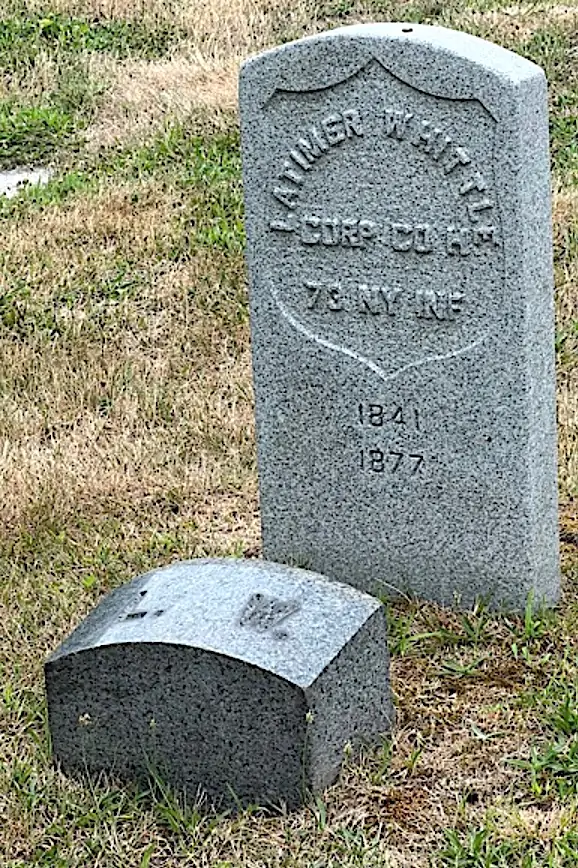
WIBLE (or WIBEL, WIEDELL, WYBEL), OTTO (1839-1884). Private, 25th New York Infantry, Company E. German-born, Wible enlisted as a private at New York City on May 11, 1861, and mustered into the 25th New York on June 14. He lost his left arm on August 24, 1861, at the first Battle of Ball’s Crossroads, Virginia. He had served at the front for just six weeks before his injury. After being hospitalized, he was discharged from service on November 24, 1861, and soon received a pension of $280 per year. His pension record, which spells his name as Wibel, reports that he applied for an invalid pension in April 1862 that was approved, certificate 9,797. That document notes that he also served in the United States Navy under the name George J. Beach.
According to his obituary in the Brooklyn Daily Eagle, he was scolded rather harshly by the woman who hired him to do errands when he showed up drunk at work and that he then became very despondent. He last lived at 284 Myrtle Avenue in Brooklyn where his death was a suicide by hanging.
The Brooklyn Union headlined his death on page 1, “A Soldier’s Suicide,” noting that in a sub-title, “A One-Armed Veteran Hangs Himself To A Gas Bracket.” As per that article, Wible’s wife had received an invitation from a lady friend to attend a Grand Army entertainment event at Turn Hall in Brooklyn. Otto didn’t care to attend and sent his wife and two children who lived with them to the event at 10 p.m. and said he would call for them at midnight. When he didn’t arrive, she waited a while, then slept over at her friend’s house because she didn’t have the key to her front door. When she arrived home at 7:40 a.m., she found her kitchen door open. She soon found Otto hanging from a piece of clothesline attached to the gas bracket. Her eleven-year-old son went downstairs to the tailor who came up and notified the police and the coroner.
The article goes on to report that the Wibles had a comfortable home and confirmed his Civil War service under Colonel James Kerrigan and his pension of $280 per year; the Brooklyn Eagle reported that Kerrigan helped get him work. The Brooklyn Union incorrectly stated that he was injured at the Battle of Bull Run but that does not match the date of his injury in August 1861. According to that article and confirming the information in the Brooklyn Daily Eagle, Otto was employed by a neighbor on South Oxford Street for about 10 years doing work around her house and reiterated that she scolded him for his heavy drinking and replaced him with a “colored man.” Otto’s wife was aware that he was despondent but did not think that he contemplated suicide. Her husband had workingmen’s insurance which would pay her about $100 per the terms of the policy. Former comrades of the 25th Infantry would bury him. He was also survived by a married daughter. Section 2, lot 5499, grave 1258.
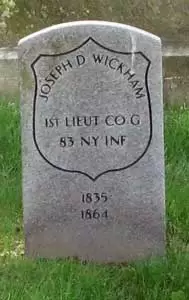
WICKHAM, JOSEPH D. (1835-1864). First lieutenant, 83rd New York Infantry, Company G. A New Yorker by birth, he enlisted at New York City as a second lieutenant on May 27, 1861, and was immediately commissioned into the 83rd. He was promoted to first lieutenant on July 29, 1861, and discharged on December 19 of that year. He last lived in New York, where he died of typhoid fever. Section 35, lot 5554.
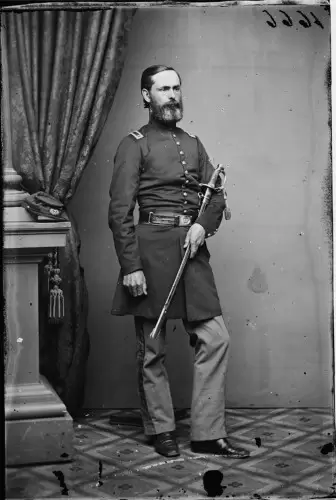
WICKSTEAD, JOHN J. (1820-1895). First lieutenant, 7th Regiment, New York State Militia, Company C. After he enlisted on April 17, 1861, at New York City, he was commissioned into the 7th Regiment nine days later, and mustered out on June 3, 1861, at New York City. He last lived at 10 St. James Place in Brooklyn. His death was attributed to cancer. Section 92, lot 1788, grave 9.
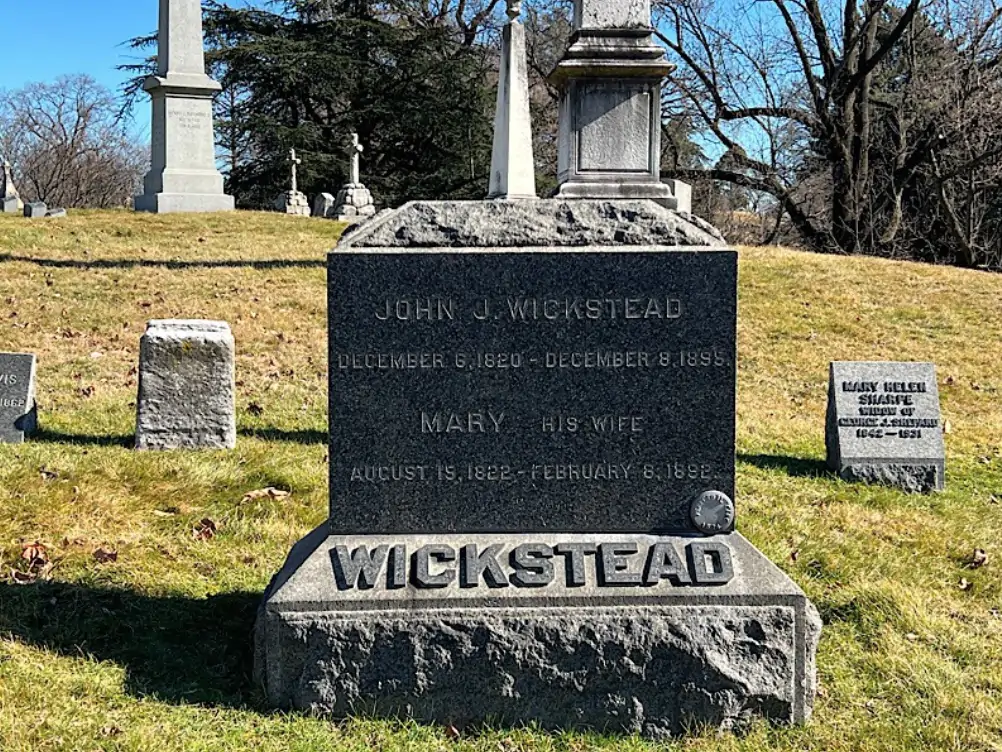
WIDMAYER, JOHN G. (1844-1904). Seaman, United States Navy. Originally from Germany, Widmayer enlisted in the United States Navy at New York City and served during the Civil War. He was a member of the Grand Army of the Republic’s Post #604 as of September 12, 1879. According to the New York City Directory of 1886, he was employed as a foreman. The G.A.R. Mortuary Table of 1905 confirms his service as a seaman. His last residence was 340 6th Avenue in Brooklyn. Section 205, lot 30628, grave 1.
WIEGAND (or WIEGANT), DAVID M. (1833-1908). Wagoner, 4th New Jersey Infantry, Company B. Originally from Germany, Wiegand served as a wagoner in the 4th New Jersey. Further details are unknown. He applied for an invalid pension, application 871,772, but it appears that it was never certified. He last lived at 100 Davis Avenue in Kearny, New Jersey. Section 4, lot 21316, grave 330.
WIERICHS, WILLIAM (1836-1875). Private, 5th Regiment, New York State Militia, Company H. A German native, Wierichs enlisted as a private at New York City in 1861, mustered into the 5th Regiment for its three month activation, and mustered out at the expiration of his enlistment. His last address was in New York City where he died from cirrhosis. Section 114, lot 899, grave 600.
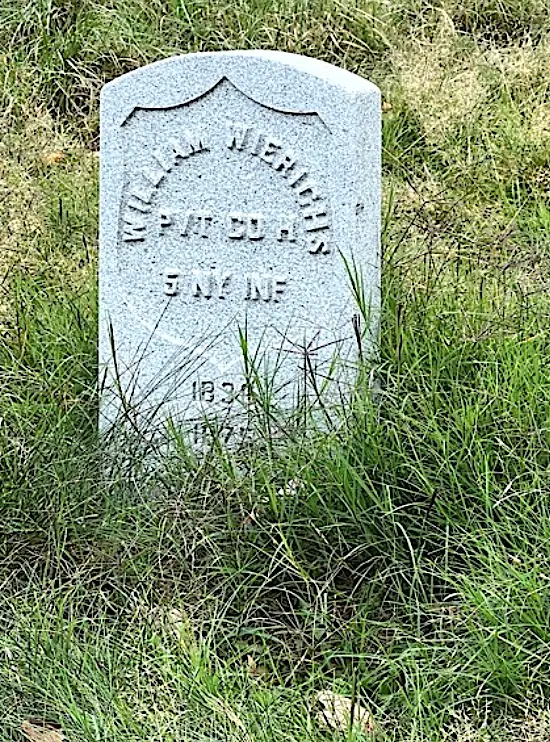
WIESE, ERNST ADOPLH GUSTAV (1848-1902). Private, 191st New York Infantry, Company B. Adolph Wiese, the younger brother of Ernst Louis (see), was born in Dresden in Saxony, Germany. He initially lied about his age to enlist in the army, but his parents petitioned the Secretary of War and he was released from service. When he was of age, he enlisted again at New York City as a private on March 28, 1865, mustered into the 191st, and mustered out on May 3 at Hart’s Island in New York Harbor.
Wiese subsequently served with the 14th New York Infantry and the 1st United States Artillery. He also served during the Spanish American War in 1898. In 1901, he applied for an invalid pension under application 1,272,551, but no certificate number was issued. His last residence was 15 Chapel Street in Brooklyn. Section D, lot 7078, grave 173.
WIESE, ERNST LOUIS (1842-1912). Private, 115th New York Infantry. Carried on the rolls as Louis Wiese, he was born in Meissen, Germany, and immigrated to the United States with his family in September 1863. He enlisted on July 22, 1864, at Schenectady, New York, mustered into the 115th New York on that day but was not assigned to a company, and mustered out on August 14, 1865, at Albany. His brother, Ernst Adolph Wiese (see), also served in the War. In 1904, his application for a pension was granted, certificate 1,085,854. Wiese’s last residence was 15 Webster Place in Brooklyn. Mary Wiese applied for and received a widow’s pension in 1912, certificate 747,464. Section 87, lot 1715.
WIESE (or WEISS), WILLIAM C. (1843-1918). Private, 25th New York Cavalry. Of German birth, Wiese came to Brooklyn at the age of five. He enlisted at New York City on October 23, 1863, and mustered into the 25th New York Cavalry on that date but was not assigned to a company. No other details are known.
After the Civil War, Wiese worked as a newsdealer at the corners of Fulton and Smith Streets in downtown Brooklyn. In addition, he was a member of the Devin Post #148 of the G.A.R. His last residence was 88 Clifton Place in Brooklyn. He succumbed to myocarditis. Section 3, lot 18372, grave 60.
WIGGINS, JOSEPH LEWIS (1842-1867). Captain, Commissary Department, Confederate States of America; private, 24th North Carolina Infantry, Company F; 44th North Carolina Infantry (“Franklin Guides to Freedom”), Company K. Born in Alabama, he moved to North Carolina, and in the 1860 census was listed as living alone in Oxford and working as a clerk. He was 5′ 10″ with dark hair, blue eyes and a light complexion. Wiggins was a distant relative of the explorer Meriwether Lewis. A resident of Granville County, North Carolina, he enlisted in the 24th North Carolina on April 22, 1861, and was transferred to the 44th in June 1862. In 1863, he re-enlisted at Fredericksburg, Virginia, for the duration of the War.
On April 10, 1864, a superior officer at the Subsistence Department at Harrellsville, North Carolina, wrote in praise of Wiggins, “…Mr. Wiggins is a man of over two years experience in the Department besides being in the highest degree energetic persevering and self-sacrificing in the public service….” He was promoted to captain and was transferred to the Commissary Department, Confederate States of America, as a purchasing agent in May 1864. On January 23, 1865, he was captured at Chowan River, Virginia, and first held at a military prison at Camp Hamilton, Virginia. Subsequently imprisoned at Fort Delaware, in Salem, New Jersey, as of March 1, he was released on June 17, 1865. After the War, he lived with his uncle in Brooklyn hoping to recover from tuberculosis. He died there of pneumonia and consumption at 125 Hicks Street. Section 151, lot 17701.
WIGHT, JAMES A. (1839-1891). Private, 13th Regiment, New York State Militia, Company B. Wight was born in New York. As per the 1850 and 1860 censuses, he was living in Brooklyn; the 1860 census notes that he was a segar (cigar) maker. Both censuses note that he was living with the McAlpin(e) family, perhaps his maternal grandparents. His parents were Rebecca and Addison Wight and he had an older sister, Jane, and a younger sister, Kate.
During the Civil War, Wight served as a private in the 13th Regiment, New York State Militia, Company B, when it was called up for three months in April 1861. The 13th left New York City for Annapolis, Maryland, and subsequently moved to Baltimore. As per the Brooklyn Standard in its article commemorating the 13th’s 25th anniversary of entry into the war, the Unionist women of Baltimore presented the soldiers with a silk American flag in recognition of their loyalty; that flag was part of the anniversary parade. When the regiment returned to Fulton Street in Brooklyn in 1861, the troops were greeted with a huge crowd that celebrated their return. That article notes that the 13th was in Suffolk, Virginia, in 1862 and in Harrisburg and Carlisle, Pennsylvania, in 1863, returning to Brooklyn on July 19, 1863, and remaining on call during the New York City Draft Riots.
The 1865 census lists Wight’s mother as the head of the household; also listed were his grandmother and two siblings. The 1880 census notes that was living at 136 Lafayette Avenue in Brooklyn with his wife Fannie and had a segar store. The 1882-1884 Brooklyn Directory lists him in tobacco with a home address at 84 St. Felix Street.
As per an article in the Brooklyn Union on April 23, 1886, Wight was among the members and veterans of the 13th Regiment who took part in a commemorative march in remembrance of their service in 1861. The march, in the Fort Greene section of Brooklyn, began at the armory. The veterans, some in the uniforms of the Veterans Association and others in civilian dress, were cheered by the large crowds lining the streets, while ladies waved handkerchiefs from their windows along the parade route. Veterans were saluted by current members of the regiment, in full dress uniform, and flags adorned the buildings.
In 1891, James was a foreman in a factory and was living at 63 Jefferson Avenue. He died from cancer of the liver and spleen at St. Luke’s Hospital in Manhattan; a physician signed his death certificate which confirmed that he was a foreman at a factory. Lot 27263, grave 1183.
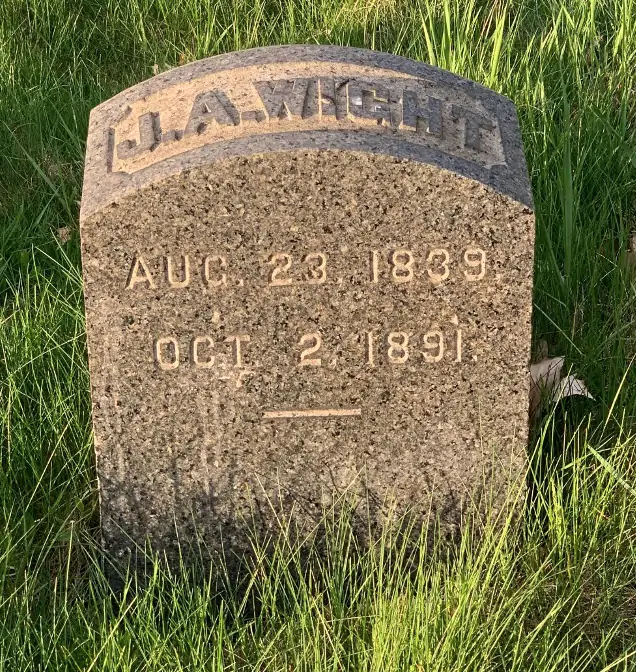
WIGHT, JARVIS S. (1834-1901). Hospital steward, 18th Regiment, New York State National Guard. Born in New York State, he served in the 18th National Guard’s Field and Staff for 30 days in 1863, at Baltimore, Maryland. His obituary in the Brooklyn Daily Eagle notes his compassion as a physician and surgeon, and the high esteem in which he was held in his community. He last lived at 30 Schermerhorn Street in Brooklyn. Section 193, lot 26580, grave 526.
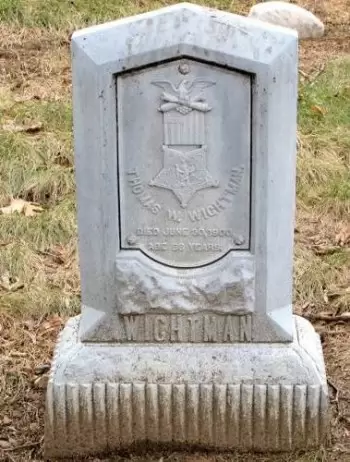
WIGHTMAN, THOMAS W. (1844-1900). Private, 12th Regiment, New York State National Guard, Company F; private, 5th Independent New York Infantry, Company K. After Wightman enlisted in 1862, he served for three months in Company F of the 12th New York National Guard. Subsequently, he re-enlisted in 1863 and served in the 5th Independent New York Infantry (Light Artillery).
In 1895, his request for an invalid pension was granted, certificate 935,088. At the time of his death, his residence was 267 Harrison Avenue in Jersey City, New Jersey. Annie Wightman applied for and was granted a widow’s pension in 1900, certificate 528,168. Section 78, lot 4057.
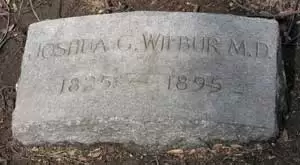
WILBUR, JOSHUA GREEN (or J. B.) (1825-1895). Assistant surgeon, 18th Massachusetts Infantry. A native of Massachusetts, Wilbur was a graduate of Harvard College and the Harvard Medical School. At the onset of the Civil War, he resided in Boston where he was a surgeon and enlisted there as an assistant surgeon on January 29, 1863. He was commissioned into the Field and Staff of the 18th Massachusetts on March 2, and was discharged for disability on October 31, 1863, by Special Order #237.
After the hostilities, Wilbur relocated to Brooklyn where he had a practice and was the medical examiner for numerous insurance companies and the medical director of the New York Jewelers’ League. He is listed as a physician in the Brooklyn Directory for 1868 and the New York City Directory for 1877 at which time his office was at 153 Broadway. His name appears on the roster of the Sons of Union Veterans. His last residence was 544 Washington Avenue in Brooklyn, but he died at his summer home in Montclair, New Jersey. Section 156, lot 20439 grave 6.
WILCOX, EDWARD T. (1837-1891). Private, 9th Vermont Infantry, Company D. A Massachusetts native, Wilcox enlisted as a private at Springfield, Vermont, on June 21, 1862, and mustered into the 9th Vermont. He was captured and imprisoned at the Battle of Harpers Ferry, Virginia, on September 13-15, 1862, and released on an unspecified date. His regiment engaged in the following North Carolina skirmishes: Bachelor Creek, Newport Barracks, and New Berne (February 1-3, 1864). He fought in Virginia at Chapin Farm, Laurel Hill, Fort Harrison (September 28-30, 1864); and Fair Oaks (October 27-28, 1864). On June 13, 1865, he was discharged at Burlington, Vermont. After the War, he belonged to the Henry M. Lee Post #21 of the G.A.R. Section 14, lot 4969, grave 293.
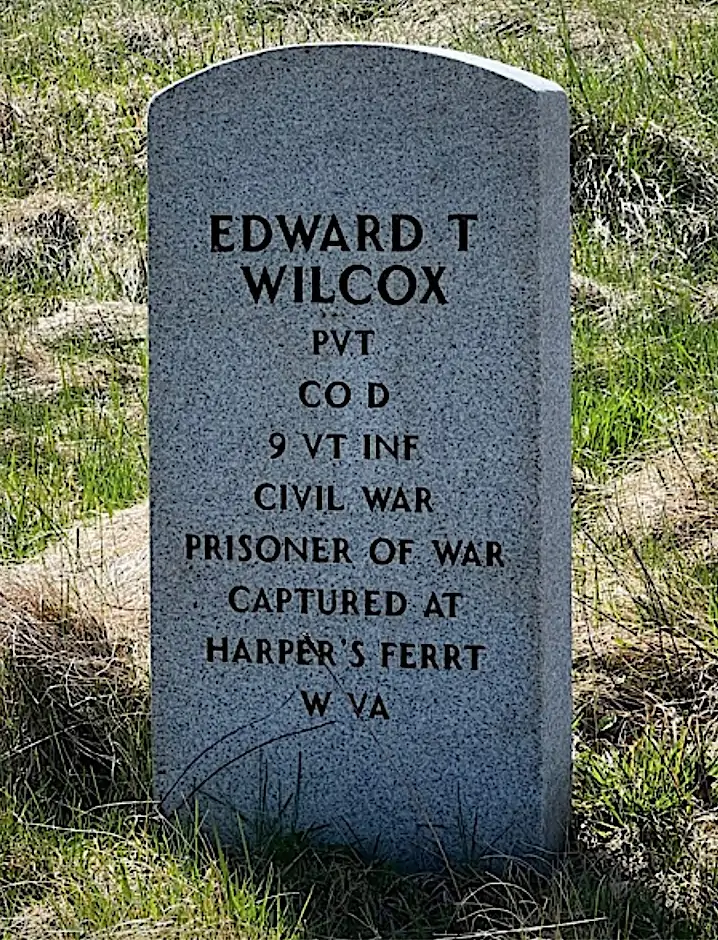
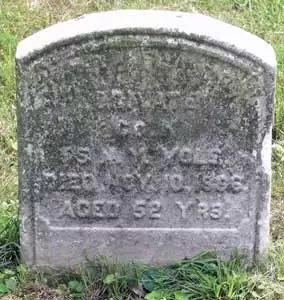
WILCOX, HENRY K. (1834-1886). Private, 56th Regiment, New York State National Guard, Company C. A native New Yorker, Wilcox served in the 56th Regiment’s National Guard. Further details are unknown. He last lived at 160 Gates Avenue in Brooklyn. Section 33, lot 9551.
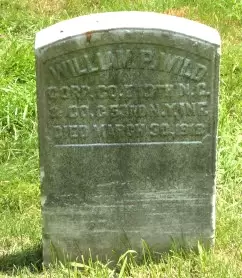
WILD, WILLIAM P. (1844-1918). Corporal, 53rd New York Infantry, Company C; private, 13th Regiment, New York State National Guard, Company E. Wild enlisted as a private on September 28, 1861, at New York City, mustered immediately into the 53rd New York, was subsequently promoted to corporal, and mustered out at Washington, D.C., on March 21, 1862. He re-enlisted at Brooklyn as a private on May 28, 1862, mustered into the 13th Regiment that day, served for three months and mustered out at Brooklyn on September 12. In 1863, he returned to the same company of the 13th National Guard and served for 30 days.
A clerk, Wild lived in Huntington, Long Island, moved to Yorkshire, England, in 1881, then lived in Brooklyn before moving to Northport, Long Island, in 1900. A member of the Rankin Post #10 of the G.A.R., he was its commander in 1885-86 and subsequently joined the Ackerly Post #426. In 1918, Maria Wild applied for and received a widow’s pension, certificate 856,751. Section 49, lot 6276.
WILDEY (or WILDY), JAMES EDWARD (1837-1928). Corporal, 14th Ohio Infantry, Company I. A Tennessee native, he enlisted as a private on September 5, 1861, mustered into the 14th Ohio on that date, and was promoted to corporal of his company at some point during his service. He mustered out on April 5, 1863, for disability.
Together with his brother John (see), Wildey was associated with the hotel and restaurant business in New York City. In 1904, he applied for and was granted an invalid pension, certificate 1,087,282. His last residence was on Overlook Avenue in West Orange, New Jersey. Section E, lot 20065.
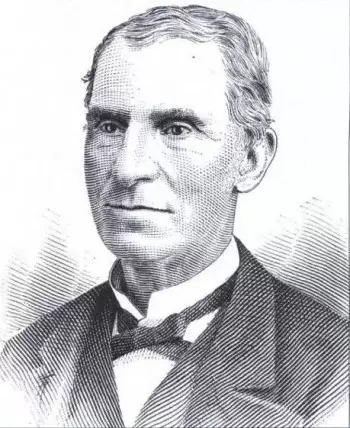
WILDEY, JOHN (or JACK) (1823-1889). Captain, 11th New York Infantry, Company I. Wildey, who was born in New York City, served for many years with the Fire Department. Starting as a runner, he became a member of the Equitable Fire Engine Company, then the Oceanus Engine Company, and rose to foreman. In addition, he was a member and officer of the Mutual Baseball Club, like many volunteer firemen, and played in one game in 1860. A saloon owner, he first served with the 7th New York State Militia.
When the Civil War began, Wildey raised a company, enlisted at New York City on April 20, 1861, was elected captain, and was commissioned into the 11th New York–the Fire Zouaves–on May 7. Private Arthur O’Neil Alcock of the 11th New York, whose reports were featured in the New York Atlas and Leader, wrote of Wildey, “Capt. Wildey, Co. I, is an excellent officer, sticks to his men like a trump, and has their full confidence.” Alcock noted that when the 11th arrived at Washington, D.C., and was dispatched to help fight a fire at the Willard Hotel in May 1861, Wildey was one of the men “conspicuous in their exertions.” Further, Alcock added, “Capt. Jack Wildey has been doing the amiable to a bevy of fair ladies and their attendant cavaliers, and pointing out to them the peculiarities of the construction of earthworks, with an air suited to a veteran engineer.” Wildey distinguished himself at the First Battle of Bull Run, Virginia, on July 21, 1861, when he re-captured the flag that had been taken from the 69th Regiment and then marched four miles to return the colors (image below). During that contest, he killed two men, one a rebel officer whose sword he kept as a trophy. He resigned on January 1, 1862.
Wildey was often referred to in baseball game reports as “Coroner Wildey” for the position he had been elected to in New York City government. He served as president of the Mutual Baseball Club and led it on a national tour. As per one biography, he used his position as coroner to provide patronage jobs for Mutual Club players. He was also criticized for his close relationship with Boss Tweed and was the subject of accusations that the Mutuals were throwing games (hippodroming). In 1870, he tried to convince the NABBP (National Association of Base Ball Players) Convention that “Boss Tweed had contributed $7,500 towards the support of the Mutual Base-Ball Club during the past year, without any intention of using Mutual players as gambling instruments.”
He was a member of the Noah L. Farnham Post #458 of the G.A.R. and served as the street commissioner of Bayonne, New Jersey. A biography states, “He never tasted liquor in his life.” His brother, James (see), also served in the War. He last lived in New York City. In 1890, Ann Wildey applied for and received a widow’s pension, certificate 396,653. Section 73, lot 3548.
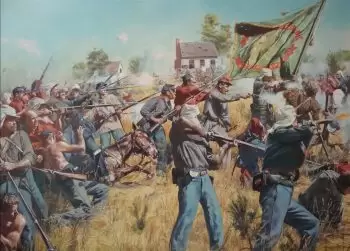
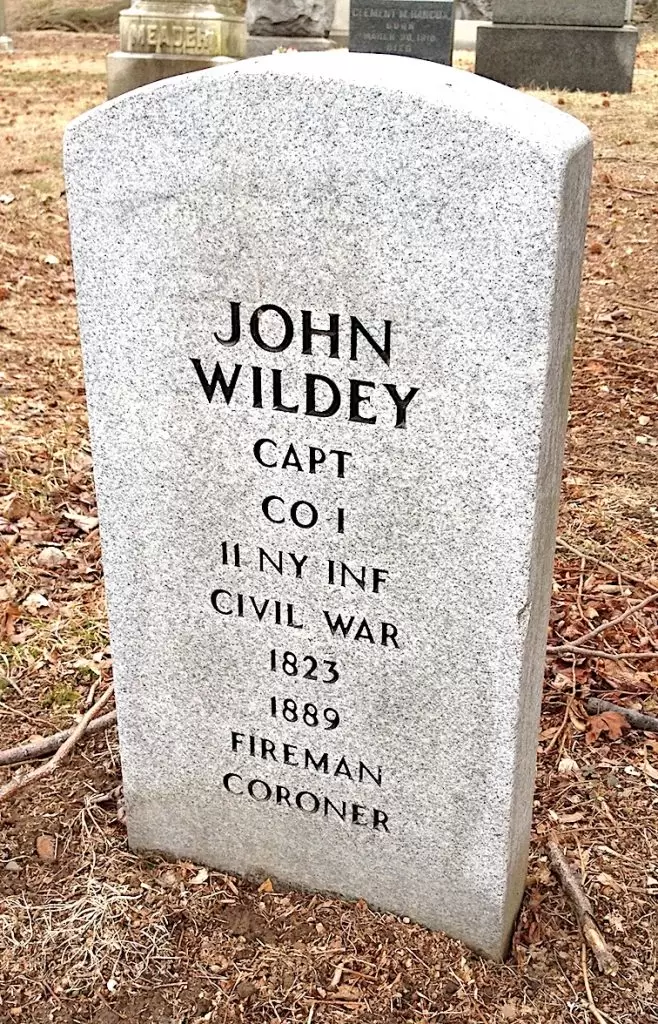
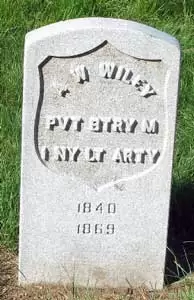
WILEY, ALEXANDER W. (1840-1869). Private, 1st New York Light Artillery, Battery M. Wiley, who was born in New York State, enlisted as a private on October 7, 1861, at Lockport, New York, mustered into the 1st New York Light Artillery two weeks later, and mustered out on October 20, 1864, at Atlanta, Georgia. His last residence was 409 West 35th Street in Manhattan. Section 2, lot 5499, grave 1834.
WILKES, GEORGE (1817-1885). Newspaper editor and war correspondent. A native of New York City, Wilkes was a law clerk but gave that up to become a journalist and editor. After being imprisoned for libel, he wrote a pamphlet on his experience, The Mysteries of the Tombs: A Journal of Thirty Days Imprisonment in the N.Y. City Prison (1844). In 1845, he and a friend began publishing the National Police Gazette, a newspaper that dealt with crime reporting and other sensational topics. The magazine soon had a large circulation and because of its efforts to combat crime, its office was the site of attacks by mobs stirred up by criminals. Also in 1845, Wilkes’s idea for an transcontinental railroad was published in a pamphlet, Project for a National Railroad from the Atlantic to the Pacific Ocean. He traveled to California in 1849 remaining there until 1853, spent time in Europe after which he wrote Europe in a Hurry, and then returned to California from late 1853 through 1854.
After a dispute with a friend, Wilkes returned to New York and journalistic pursuits. In 1856, he bought The Spirit of the Times, a weekly sports publication that he worked for and, in 1859, renamed it Wilkes’ Spirit of the Times. He enhanced the weekly by adding political issues to its content. The Civil War aroused his patriotism and, as a civilian war correspondent, Wilkes accompanied a New York regiment in 1861 to First Bull Run, Virginia. In his dispatches home, he wrote about the exotic uniforms of the Zouave regiments who wore flowing red pantaloons, blue jackets and red caps. He also theorized that the war would be won by bayonets, not gunpowder, a romantic and old-fashioned notion. He wrote:
…the Government has already taken away the little costly breech-loading toys which the munificence of New York put in the hands of Col. Ellsworth’s regiment, and served out to them the spear, in the shape of a saber on the end of a Minie musket… The saber bayonet is also to be distributed throughout the entire Army, and I feel certain, from what I have gathered from military men, that the actual embrace of battle, man to man, is what the Northern captains of war intend mostly to rely upon.
His account of Bull Run was subsequently published as a pamphlet. Wilkes’s wartime editorials attacked General George B. McClellan and praised General Ulysses S. Grant, making him a favorite of Secretary of War Edwin Stanton. While with the troops in 1862, he contracted kidney disease which compromised his health for the rest of his life. In 1863, his work, McClellan: From Ball’s Bluff to Antietam, was published. That work was a scathing attack on McClellan and contributed to galvanizing public opinion in favor of his ouster.
After the Civil War, Wilkes’s publication refocused on horse racing and he, along with John Chamberlain and Marcus Cicero Stanley, introduced parimutuel betting in the United States. His interest in sports extended to boxing; he was a promoter of prizefights. In addition to advocating the Transcontinental Railroad in the United States, he also was the first to suggest the Trans-Siberian Road, an action that led to a decoration from the Russian czar. Although he sold the National Police Gazette in 1866, he continued to publish Wilkes’ Spirit of the Times until his death. In 1867, he took an interest in the colonization of Baja California, and became a trustee in a colonizing company there.
At some point, Wilkes was employed by the New York Tribune. A Republican, he ran for Congress in 1870 and was soundly defeated. In 1877, he published his last work, Shakespeare from an American Point of View, reflecting his lifelong interest in the writer. That book was revised twice, the last time in 1882. He last lived at 352 West 61st Street in Manhattan. Section 183, lot 22124.
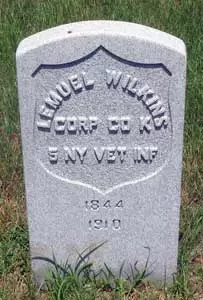
WILKINS, LEMUEL (1844-1910). Corporal, 5th New York Veteran Infantry, Company K; private, 13th Regiment, New York State National Guard, Company C; 84th New York (14th Brooklyn) Infantry; Companies D and G. Born in New Berne, North Carolina, he enlisted as a private at Brooklyn on May 28, 1862, mustered into the 13th Regiment that day, and mustered out at Brooklyn on September 12. On September 25, he re-enlisted at Brooklyn as a private, mustered into Company D of the 14th Brooklyn the next day, transferred to Company G on June 1, 1863, and transferred into the 5th Veterans on June 2, 1864. He became a corporal on October 1, 1864, was reduced to private on October 16, and was promoted to corporal on April 1, 1865, before he was discharged later that year on an unknown date.
According to 1880 and 1900 censuses, Wilkins was employed as a fresco painter. In 1897, his pension application was approved, certificate 982,101. He died at the Soldiers’ Home in Bath, New York. Section 107, lot 10179, grave 7.
WILKINSON, WILLIAM A. (1837-1864). Private, 84th New York (Brooklyn) Infantry, Company K; 5th New York Veteran Infantry, Company K. A printer by trade and resident of 36 Pitt Street in Manhattan, Wilkinson enlisted as a private at Brooklyn on September 3, 1862, and mustered into the 14th the same day. He was listed as missing in action on July 1, 1863, at Gettysburg, Pennsylvania, the first day of the battle, and returned on October 8, 1863 (place not stated). On June 2, 1864, he transferred into the 5th Veterans. Incurring wounds caused by a gunshot to his right knee, he died of sepsis on June 4, 1864, at Mount Pleasant Hospital in Washington, D.C. A gravestone was ordered for him early in the 20th century. Section 115, lot 13536 (Soldiers’ Lot), grave 90.
WILLARD, CHARLES A. (1836-1894). Second lieutenant, 53rd New York Infantry, Company B. Willard enlisted at New York City on August 21, 1862, as a second lieutenant, and mustered into the 53rd New York’s Company B the following day. However, he was never commissioned and mustered out on September 13, 1862. His last residence was on Prospect Avenue in Brooklyn. He died from Bright’s disease. Section 174, lot 18362.
WILLARD, CHARLES FREDERICK (1836-1899). Private, 13th Regiment, New York State Militia, Company G; ensign, United States Navy. A great-great grandson of the famed Governor William Bradford of Massachusetts, Willard was born in Brooklyn and served for three months in the 13th New York State Militia in 1861. He then enlisted as an ensign in the Navy and served for two years on the USS Iroquois. As per his obituary in the New York Herald, he was with Admiral David Farragut at New Orleans when the Iroquois lost 53 men in that battle.
Involved in the produce business with the firm of Willard & Struthers, he was a charter member of the New York Produce Exchange. Willard was a member of the Brooklyn City Guard and the Veteran Association of the 23rd Regiment. He last lived at 181 Tompkins Avenue in Brooklyn. His remains were moved to their present location in 1908. Section 96, lot 1242.
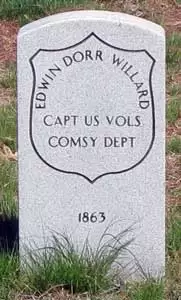
WILLARD, EDWIN DORR (1817-1863). Captain and commissary of subsistence, United States Volunteers Commissary Department. Born in Vermont, Willard enlisted as a captain on May 1, 1862, and was commissioned immediately into the United States Volunteers Commissary Department. He was promoted that same day to captain and commissary of subsistence. He died of disease on October 31, 1863. He last lived in Brooklyn. Section 162, lot 15430.
WILLARD, WILLIAM H. (1843-1866). Private, 21st New York Infantry, Company F. Willard, who was born in New York, enlisted as a private on May 7, 1861, at Buffalo, New York, mustered into his company on May 20, and deserted on May 30, 1862. He last lived at 319 Broadway in Manhattan. Section 180, lot 13909.
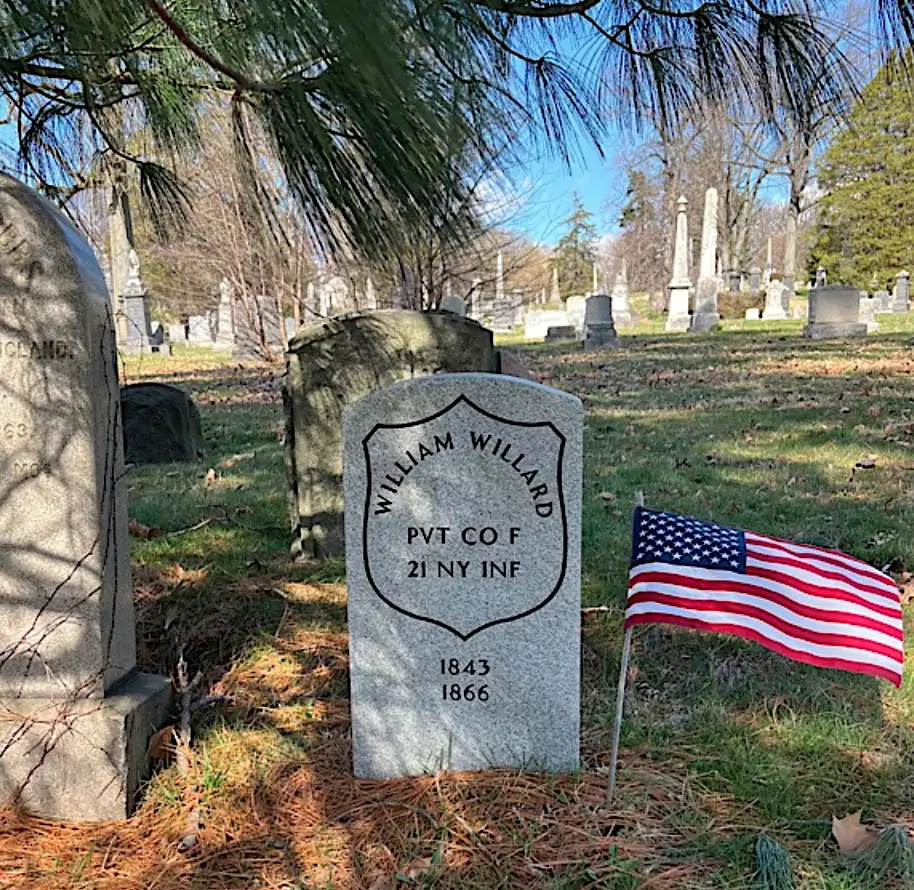
WILLCOX (or WILCOX), EDWIN A. (1840-1924). Second lieutenant, 10th New York Infantry, Company K; sergeant 14th Connecticut Infantry, Company A; 4th Company, Veteran Reserve Corps, 2nd Battalion. Willcox was born in New York State. Enlisting on May 2, 1861, at New York City as a second lieutenant, he was immediately commissioned into the 10th New York from which he was discharged for disability on October 23. A resident of Bridgeport, Connecticut, he re-enlisted on June 4, 1862, as a private, mustered into Company A of the 14th Connecticut on August 20, and was promoted to sergeant on September 11. On September 17, 1862, he was wounded at Antietam, Maryland, and was wounded on February 6, 1864, at Morton’s Ford, Virginia. He transferred into the 4th Company of the Veteran Reserve Corps on October 11, 1864, from which he was discharged for disability on December 9, 1864.
Willcox applied for and received an invalid pension in 1865, certificate 72,626. He was a member of the Ulysses S. Grant Post #327 of the G.A.R. His obituary in the Brooklyn Standard Union confirms his service in the Civil War. His last residence was 128 Lincoln Road, Brooklyn. Section 146, lot 26911.
WILLERS, GEORGE T. (1841-1891). Private, 37th Regiment, New York State National Guard, Company B; 71st Regiment, Company G, New York State Militia. A New York native, Willers enlisted as a private at New York City on May 29, 1862, and mustered into Company B of the 37th Regiment. He mustered out with his company after three months at New York City on September 2, 1862. His pension index card shows additional service in the 71st Regiment but no dates are listed.
The census of 1880 reports that Willers was single, lived in Manhattan, and worked as an agent for Babbitt Soap. The 1884 New York City Directory shows that he was a clerk who lived at 807 West 21st Street in Manhattan. In 1888, Willers’s application for an invalid pension was approved, certificate 449,204. He died from epilepsy with shakes at the Dr. Combes Sanitarium. Section 85, lot 1594, grave 260.
WILLIAMS, ASHER (1836-1890). Private, 11th New York Infantry, Companies E and F. He enlisted on April 20, 1861, at New York City, mustered into Company E on May 7, and transferred to Company F on October 10 of that year. Williams deserted at some point during his military duty. His last address was on Eighth Avenue in Manhattan. He died of pneumonia. Section 207, lot 20118, grave 538.
WILLIAMS, BARNEY (1824-1876). Actor and entertainer of the 47th New York Infantry. Born Bernard O’Flaherty in Cork, Ireland, his parents immigrated to New York City in 1831. A newsboy at a print house, he began performing bit parts at the Franklin Theater in New York City and had his first speaking role in The Ice Witch in 1836. He soon adopted the stage name, Barney Williams. In addition to theatrical performances, he introduced Irish clog dancing to American stage, was a member of P. T. Barnum’s company known as “Moral Lecture Room,” managed the Vauxhall Theater on the Bowery in New York, and did blackface comedy in minstrel shows. (Minstrel shows, which were popular from the mid-19th century well into the 20th century, featured white performers depicting “blackness” in exaggerated costumes and blackface make-up, supposedly for comedic effect, but relying on racist derision and stereotyping at its core.)
Subsequently, he embarked on a career as an Irish comedian in 1846 and gave up the minstrel shows after his marriage to the actress Maria Pray in 1849. Williams and his wife performed in California, Nevada, and in Europe where they performed before Queen Victoria and other royals. They returned to the United States in the 1860s and performed in major East coast cities. When they performed The Fairy Circle at Grover’s Theater in Washington, D.C., on February 26, 1863, President Abraham Lincoln was in attendance. In October 1863, Williams performed for Union troops of the 47th Regiment as they sailed down the Hudson River. It is possible that Williams sang The Bowld Soldier Song for the 63rd New York, the Irish Brigade, in 1864. Williams continued performing in many New York Theaters until 1874. Over his successful career, he became a very wealthy man, leaving an estate of about $400,000. General John C. Fremont was one of the pallbearers at his funeral. Section 111, lot 13464.
WILLIAMS, BECKWITH T. (1836-1870). Second lieutenant, 13th Regiment, New York State National Guard, Company A. Beckwith, who was originally from Ireland, served with the 13th Regiment’s Heavy Artillery for three months in 1862. He last lived on Classon Avenue in Brooklyn. Section 181, lot 12165.

WILLIAMS, CORNELIUS T. (1839-1872). Private, 37th Regiment, New York State National Guard, Company G. A New York State native, Williams enlisted as a private and mustered into his company on May 29, 1862. He mustered out three months later on September 2 at New York City. Williams last lived at 39 West 51st Street in Manhattan. Section 67, lot 14015.

WILLIAMS, DANIEL (1842-1918). Private, 37th Regiment, New York State National Guard, Company D. He enlisted as a private at New York City on May 29, 1862, and immediately mustered into the 37th Regiment. On September 2, after three months of service, he mustered out at New York City. He last lived in Manhattan. Section 183, lot 20866.
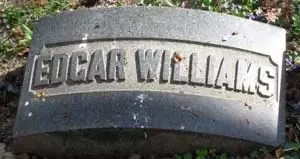
WILLIAMS, EDGAR (1825-1908). Private, 7th Regiment, New York State Militia, Company B. A native of New York City, Williams served twice in his company; the first was in 1861 for 30 days, and the second was in 1862 for three months (when the 7th Regiment was part of the New York State National Guard). Williams last resided at 169 Hicks Street in Brooklyn. Section 29, lot 12618.
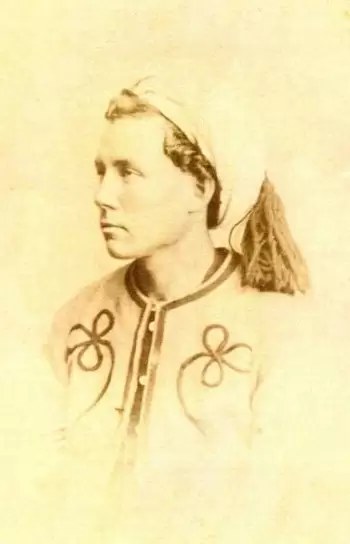
WILLIAMS, GEORGE FORRESTER (1837-1920). Captain by brevet; color sergeant, 146th New York Infantry, Companies G and B; corporal, 5th New York Infantry. An important figure in New York journalism, Williams also had a colorful military career, and wrote extensively about the Civil War. Williams was born in Gibraltar, the son of a British soldier, and arrived in the United States at age 13 as a penniless orphan. He soon found employment with The New York Times as a typesetter. After an “extra” he wrote about a major fire that broke out after the editor had gone home for the night caught the chief editor’s eye, Williams was moved to the editorial department, where he rose rapidly until the outbreak of the Civil War. He wrote a popular semi-autobiographical novel, Bullet and Shell, about his War experiences. An excerpt from an entry describing the scene in New York City in April 1861 is excerpted below:
With the news of [Colonel Robert] Anderson’s surrender [of Fort Sumter] ringing in my ears, I impatiently threw aside my books, and abandoned study. Standing in the streets of New-York City, the next day, I saw a favorite regiment march over its pavements in prompt response to the call of the government.
It was an exciting an extraordinary scene; and my pulse throbbed wildly that bright sunny April afternoon, as I witnessed the fierce outburst of popular feeling. Half a million people throng the streets of that great city, and waited in surging masses to see their citizen-soldiery march past. Traffic in Broadway was entirely suspended for the time, and the busy life of the metropolis seemed suddenly diverted from its accustomed channels. From house-tops and windows waved the stars and stripes in endless profusion, while men and women wore the tricolor on their breasts.
…The banker at his desk had heard the call, and pushed aside his interest-tables to obey it. The physician sitting beside his patient had heard it, and prepared to change the sphere of his duty. The lawyer pleading his client’s case in the court-room had heard it, and dropped his brief to shoulder a musket in obedience to the summons. The artisan had heard it above the rattle of machinery and threw away his tools to take up the weapons of war. The clerk had heard it at his counter, and abandoned his yardstick for the bayonet. The artist before his easel had heard it and turned his canvas to the wall, there to lie untouched until he had done his duty as a soldier. The fashionable idler had heard the appeal in his club-room and rejoiced, as he pulled off his gloves, that at last he had an earnest object in life. As all these men came together and fell in, shoulder to shoulder, their hearts beat high with enthusiasm; and the marched forward in solid column, fully appreciating the grave responsibility resting upon them….
At length the roll of drums is heard in the distance, and afar off we can see the glitter of bayonets as they flash in the rays of the setting sun. The police become suddenly active, and push the expectant people back; then the crowd parts, and the head of the column appears. It is the gallant New-York Seventh, stripped of all gaudy decoration, but well-equipped for active service. With full ranks, the knapsacks giving the command and appearance of solidity not observable on holiday parade, the regiment marches steadily forward to the monotonous beat of the drums. Men in the ranks are recognized by friends in the throng, and earnest farewells are uttered.
In describing the changes in the nation, Williams wrote this excerpt in Bullet and Shell: The Civil War as the Soldier Saw It in April 1861:
It was a period of anxious expectation. Armies were rising on every hand with amazing rapidity: ship-yards were thronged with workmen engaged in transforming merchant-vessels into ships of war; foundries were turning out cannon, or casting vast quantities of shot and shell; artisans were learning new trades, for, instead of implements of husbandry, they were fashioning weapons for the battle-field; tender-hearted women wrapped the crisp cartridge, or stitched the uniforms of blue and gray. The pruning-hook was being beaten into the sword-blade, and the simple citizen became a soldier. Throughout the length and breadth of the land a feverish activity prevailed: the pursuits of peace were abandoned for the perils of war. New geographical lines had been drawn, and brother stood up against brother; for Hatred ruled the hour, and pushed Reason from her throne.
At 6′ 2″ with fair complexion, gray eyes and auburn hair, Williams enlisted in the 5th New York Infantry as a private on July 10, 1861. Writing about the skirmish at Big Bethel, Virginia, the previous June 10, he shed light on the thoughts of a soldier as he prepared for an assault:
“…Stumbling along in open column, we pushed on through the darkness silently but eagerly, until, after a two-hours’ march, we were led into a bit of woods on the right of the road, and ordered to lie down. As we did so, I began wondering what the result of the approaching engagement would be. Here I lay, musket in hand, among men of whose existence I had been ignorant a few short weeks before; and, as I stretched my tired body on the soft and fragrant earth, I realized the grim earnestness of the situation. In a few hours I might be among the dead, lying motionless on the battle-field, or groaning in an ambulance, sick with pain and loss of blood. Yet a strange feeling of content rested upon me; and, though we were all nervous over the suspense, I noticed no symptoms of cowardice. Few of us spoke, even in whispers, for silence had been strictly enjoined; and the absence of all sound among so many men was to me more painful to bear than any actual fighting could possibly be…”
Williams was promoted to corporal on January 9, 1862. He became ill with typhoid fever during the Peninsula Campaign, was wounded in the right foot on June 26, 1862, soon after the Battle of Gaines’ Mill near Chickahominy Bridge, Virginia, and was treated on a Sanitary Steamer (hospital ship). Sent North to recuperate, he joined the regimental recruiting detail. When he returned to his unit, he served as company clerk. After the Battle of Antietam, Maryland, in September 1862, he wrote:
“It was after the Antietam campaign that President Lincoln visited the army and made a running sort of review, each regiment standing to arms at its own camp to receive him. This same Zouave regiment had suffered terribly, and the President spoke to General McClellan about the slender appearance of the battalion.
“Oh, the Zou Zous are all right,” remarked the general, “They can whip the devil round a stump any time.”
“It would be a very small stump, then,” replied the President, “or the devil would soon get away from them.”
He was transferred on May 9, 1863, to the 146th New York Infantry, and fought with that regiment at Gettysburg, Pennsylvania. In June 1863, he wrote his observations about the Confederate Army from Winchester, Virginia:
“…Fresh as I was from the midst of our own well-appointed and disciplined army, the contrast afforded by these Confederate troops was a striking one. Marching pell-mell, with no heed to order or formation, the infantry scuttled along at a terrific rate of speed. The men were but lightly clad, very few had a knapsack, nor were they much burdened with blankets or shelter-tents; betokening great suffering and hardship in wet and tempestuous weather. The day being then a warm and pleasant one, the troops seemed in great spirits, laughing and joking over the prospect of going over into “Maryland, my Maryland.” None of the men had, however, that rugged, healthy look so noticeable in our own army.”
His journal recorded the Battle of Gettysburg. Part of the entry read:
July 1, 1863 “…Smiling orchards, huge barns, groups of cattle, and a few scampering horses in a pasture near a brook completed the pastoral scene. Like an avalanche, the corps descended into the valley. The infantry marched into the wheat field, trampling down the ripening grain, while the artillery seized the meadows and the hay. Tents were put up, and the men were quietly eating their suppers, when the news ran from fire to fire that the First and Eleventh corps had struck the enemy, and that General [John] Reynolds had been killed. Twenty minutes after, the bugles began winding the call “Strike tents and march away.” The bugle notes had scarcely ceased before the entire corps of sixteen thousand men was in line for a night march of eighteen miles. The route ran through a succession of small villages. The houses were all illuminated, while among the cherry trees, beside the road, stable lanterns had been hung. The inhabitants exhausted their stores of bread, honey, coffee, milk, and cheese by giving it freely to the men in the marching column. All night these people stood at their garden gates watching the solid masses of infantry tramp steadily forward…”
July 2: “…. . . As we crossed the glen at a mad, headlong pace, the guns of the battery opened on us with a murderous discharge of grape and canister, at close range. But we were now going down hill, so escaped the greater part of the shower of iron pellets, which went whistling over our heads; though a good many men dropped. Before the gunners could reload we were upon them, and a desperate hand-to-hand fight ensued. The dash of our brigade was so sudden, and our progress across the glen so rapid, the movement was a surprise for the Confederates; consequently the battery fell into our hand before their infantry supports could come up. On reaching the muzzle of one of the guns I found myself confronted by a tall gunner, who having seized a musket made a lunge at me with the bayonet. Instinctively warding off the thrust with my sword, the point of the fellow’s bayonet became entangled in the guard, and I felt it pierce my fingers. Before I could recover myself, Corporate Malone sprang to my side, and drove his own bayonet through the throat of my brave antagonist, who, with a groan, fell to the ground as the piece became our prize…”
July 3: “…It was a dreadful moment. Here I was prepared to slaughter unarmed men, purely at the instinct of self-preservation; for I had no desire to be made a prisoner, and marched to the Confederate capital. The [Confederate] prisoners failed at first to understand our alarm and sudden change of demeanor, but the sight of two hundred muskets sternly leveled at their breasts taught them we were in danger. Still the love of life was too strong for them to make any effort for liberty, so they cowered down and remained silent, motionless. Then the sharp clatter of horses’ hoofs sounded in the stony road, and I felt as if my heart had stopped beating during those few moments of terrible suspense. Our only danger was that my horse might neigh at the near presence of the [Confederate] cavalry, and I uncharitably wished the animal dead.”
Williams was promoted to sergeant and, on January 1, 1864, to principal musician of the 146th. After being made color sergeant, he was carrying the flag across Saunders’ Field at the Battle of the Wilderness, Virginia, on May 5, 1864, when he was shot down with wounds in both hips and captured. Williams remained a prisoner until August 31, 1864, and was discharged from service soon thereafter. He became a United States citizen in 1865. On March 26, 1866, he was brevetted captain “for gallant and meritorious service.”
After his military service ended, Williams covered the last campaigns of the Civil War as a correspondent for the Times. In 1867, he went to Mexico, where, in addition to reporting on the Franco-Mexican War for the Times, he served as an aide to President Juarez, and witnessed the execution of Emperor Maximilian. He continued south, and held the post of brigadier general and chief of artillery for the Guatemalan and Peruvian armies. Williams then returned to the Times, working as its managing editor from 1870 to 1873. He moved to the New York Herald, where he held the managing editor position from 1875 to 1876, and later was the night editor of the New York World and The Recorder.
Williams edited several picture histories of the Civil War, including The Memorial War Book. In addition to Bullet and Shell, he wrote Civil War Soldier Life: in Camp and Battle, a short book illustrated by Edwin Forbes (see) which described the everyday life of soldiers on both sides of the conflict. Williams applied for and was granted an invalid pension in 1891, certificate 1,141,459. He lived in New York City after the War; at the time of his death, he was living in New Brighton, Staten Island, at 1350 Forest Avenue. Section 185, lot 19698.
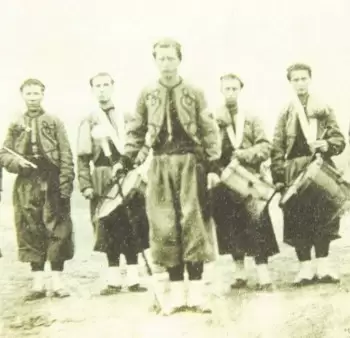
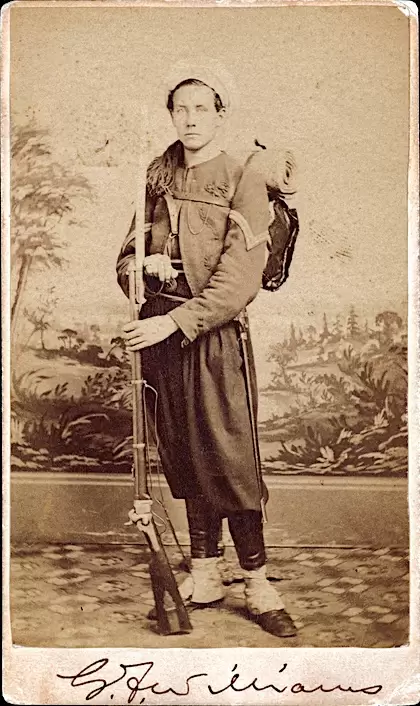
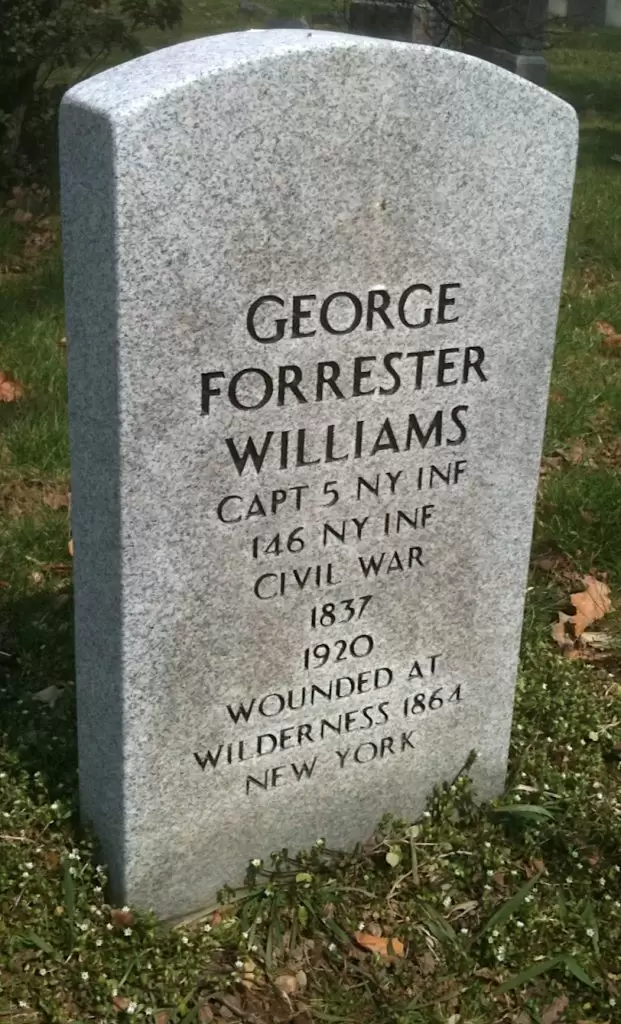
WILLIAMS, GUS (1848-1915). Drummer boy and entertainer, 48th Indiana Infantry, Company F. Born on the Bowery near Grand Street in New York City as Gustave Wilhelm Leweck, Jr., he ran away from home as a teenager to seek adventure in the West. Williams was a farmhand in Indiana before he joined the 48th Indiana as a drummer boy on August 12, 1862. He began his singing career entertaining Union troops. On November 14, 1864, he played Carney in “The Pirate Legacy: The Wrecker’s Fate” during the Union Army’s occupation of Huntsville, Alabama.
When the war ended, Williams took to the stage, making his debut at Tony Pastor’s Theatre in New York in 1866. He made his first appearance in Boston, Massachusetts, in 1868, and was for many years the most popular actor in that city. In 1885, he adopted his stage name as his legal name. In his day, he was the highest-paid vaudeville performer in the country and one of the first German comedians. He was active in the movement for higher wages for vaudeville players and was the first to earn $500 a week for an engagement. In addition, he wrote comic and sentimental songs. He was the founder of the Boston Elks Lodge. At the age of 70, after entertaining audiences for virtually his entire life, he committed suicide by shooting himself in the head at the Yonkers railroad station. Section 48, lot 22246.
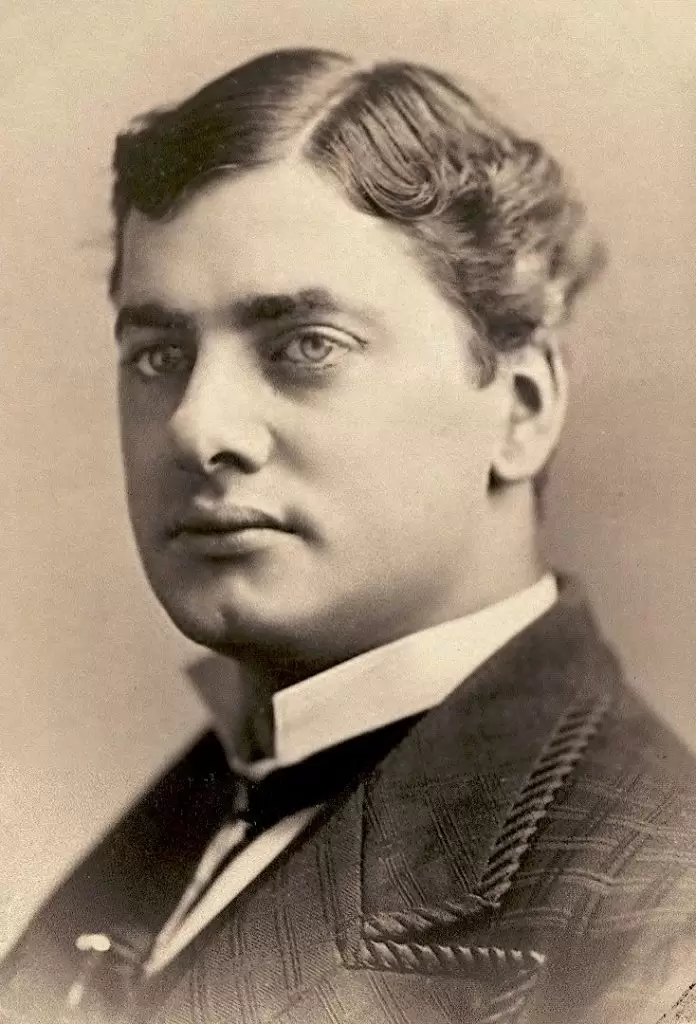
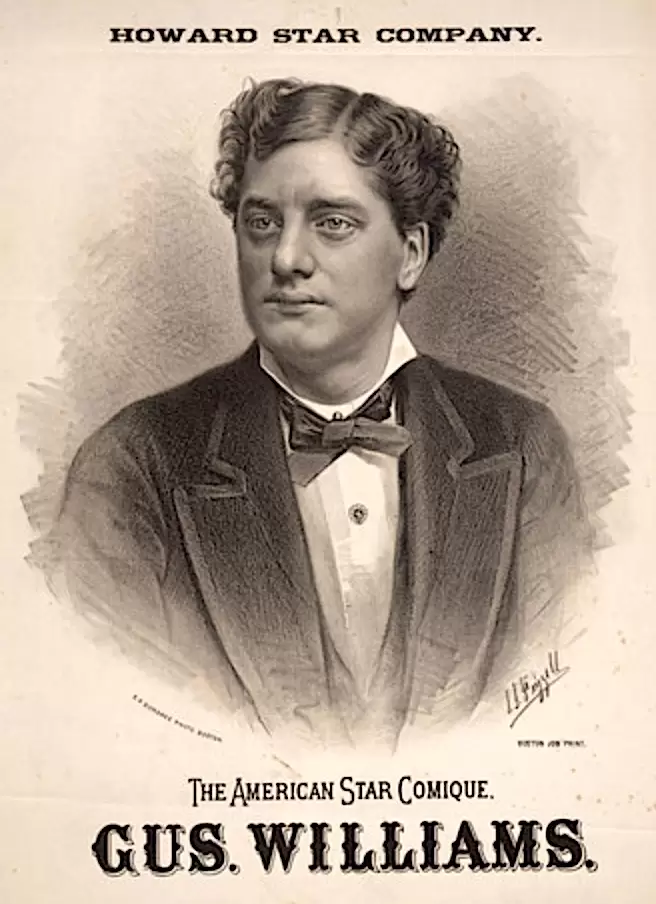
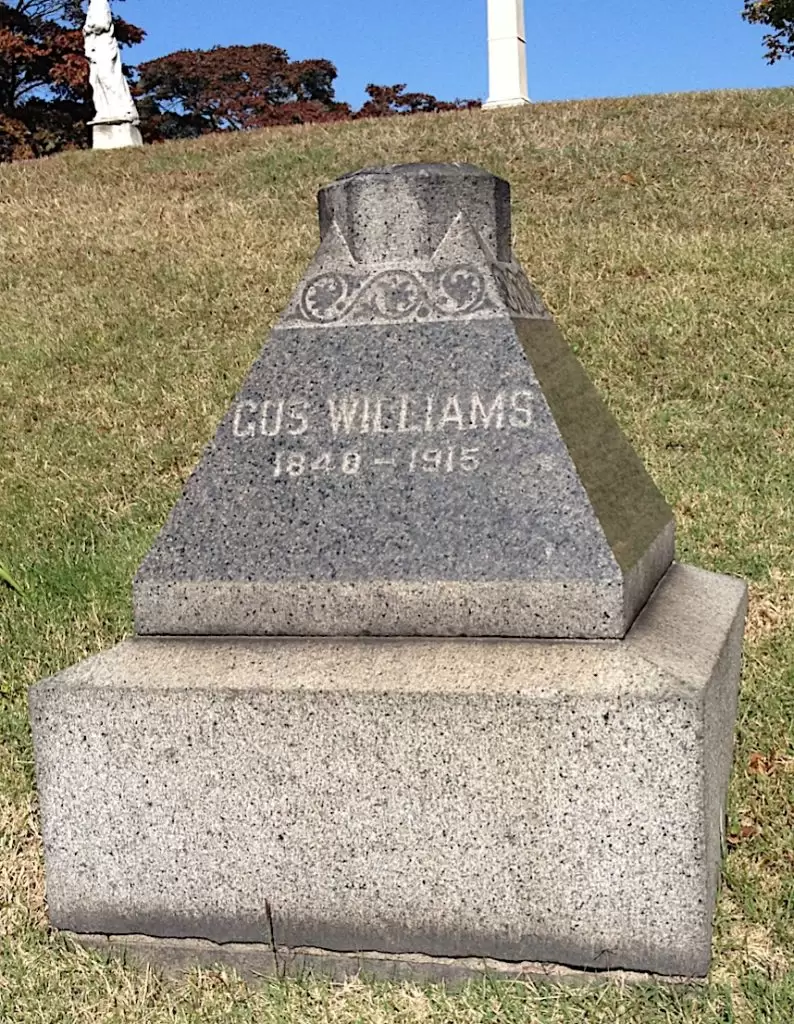
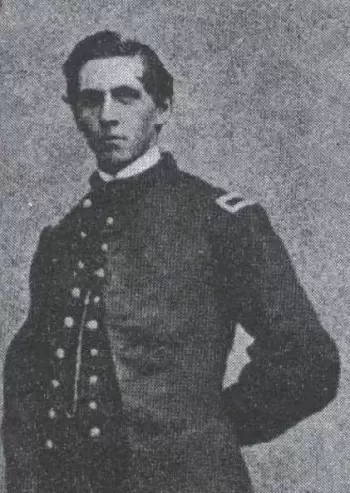
WILLIAMS, HENRY ROBERT (1841-1904). First lieutenant by brevet; first lieutenant, 84th New York (14th Brooklyn) Infantry, Company D; second lieutenant, 11th Regiment, Veteran Reserve Corps; private, United States Army. Of English birth, he enlisted at Brooklyn as a private on April 18, 1861, and mustered into the 14th on May 23. Williams was promoted to corporal on October 11, 1861, to second lieutenant on October 1, 1862, and to first lieutenant on August 18, 1863. After being wounded in action on September 26, 1863, he was discharged for wounds on April 25, 1864. He also served as a second lieutenant in the 11th Regiment, Veteran Reserve Corps, and was brevetted to first lieutenant of United States Volunteers on March 13, 1865, “for faithful and meritorious services.”
Subsequent to his discharge from the Veteran Reserve Corps, Williams enlisted in the United States Army as a private beginning June 16, 1864. He was promoted to second lieutenant of the 45th Infantry on July 28, 1866, to first lieutenant on December 12, 1868, and retired on December 15, 1870. He last lived on 1st Street in Brooklyn. His widow, Ella Williams, received a pension in 1906, certificate 610,790. Section 168, lot 17501, grave 4.
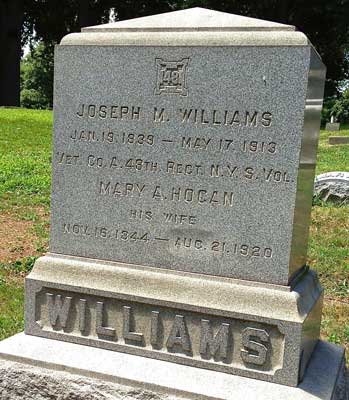
WILLIAMS, JOSEPH M. (1839-1913). First lieutenant, 48th New York Infantry, Companies A and E; private, 12th Regiment, New York State Militia, Company A. A native of England, Williams first served for three months in 1861 in Company A of the 12th Regiment, New York State Militia. He re-enlisted at Brooklyn as a private on March 15, 1862, and mustered into Company A of the 48th New York that day. Rising through the ranks, he became a quartermaster sergeant on an unknown date, second lieutenant on July 6, 1864, effective upon his transfer that day to Company E, and first lieutenant several weeks later on July 30. Williams was discharged for disability on September 22, 1864. In 1891, his application for an invalid pension was granted, certificate 697,860.
As per his obituary in the Brooklyn Standard Union, which confirms his Civil War service, he was well known in military circles and was a member of the 48th Regiment Veterans and the New York State Volunteer War Veterans’ Association. He last lived at 4502 13th Avenue in Brooklyn. Shortly after he died from nephritis, Mary Williams applied for and received a widow’s pension in 1913, certificate 768,595. Section 50, lot 13106.
WILLIAMS, JOSEPH P. (1836-1896). Corporal, 71st New York Infantry, Company B; private, 120th New York Infantry, Company E; 73rd New York Infantry, Company I. Originally buried at Green-Wood on August 11, 1896, his remains were removed on October 5, 1897. A native of Poughkeepsie, New York, Williams enlisted at New York City as a private on May 3, 1861, and mustered into the 71st New York on June 20. He was promoted to corporal on December 1, 1861, reduced to ranks on April 1, 1862, and transferred into the 120th New York as a private on July 8, 1864. On June 1, 1865, he was transferred into Company I of the 73rd New York from which he was discharged.
Williams mustered into the G.A.R. on August 25, 1890. In 1892, he applied for and received an invalid pension, certificate 892,196. His last address was 535 West 51st Street in Manhattan. His death was caused by a cerebral hemorrhage. Although his widow applied for a widow’s pension under application 642,991, it was never certified.
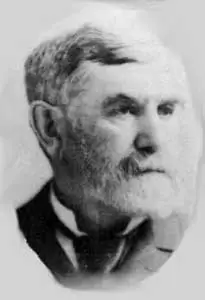
WILLIAMS, NELSON GROSVENOR (1823-1897). Colonel, 3rd Iowa Infantry. Born in Bainbridge, New York, he entered West Point in 1839, the same year as Ulysses S. Grant, but resigned after one year because he had difficulty with mathematics. For the next 15 years he worked in the importing business in New York City, then moved to Iowa, where he farmed and ran a general store.
On June 26, 1861, Williams was appointed colonel of the 3rd Iowa Infantry, and led troops in West Tennessee from March 15-April 6, 1862, commanding the First Brigade of the Fourth Division of the District and Army of West Tennessee. At the Battle of Shiloh, Tennessee, a cannonball went through his horse; the dead animal then fell on Williams, paralyzing him for weeks and causing severe pain in both ears, loss of some sight, and a prolapsed anus. According to Jack D. Welsh, M.D., in Medical Histories of Union Generals (1996, pp. 379-80), he was treated on a hospital boat at Pittsburg Landing, then sent to a private house at Memphis, Tennessee. During his treatment, he developed chronic diarrhea that persisted throughout his service. In September and October he returned to Iowa to recuperate. These injuries forced him to resign on November 27, 1862. His promotion to brigadier general on November 29, 1862, was revoked by the Senate on March 9, 1863.
After the War, despite suffering from diarrhea, jaundice, rheumatism, and deafness, he served as a civil servant at the Customs House after being appointed by President Grant in 1869. He last resided at 100 Park Place in Brooklyn. Section 147, lot 22000.
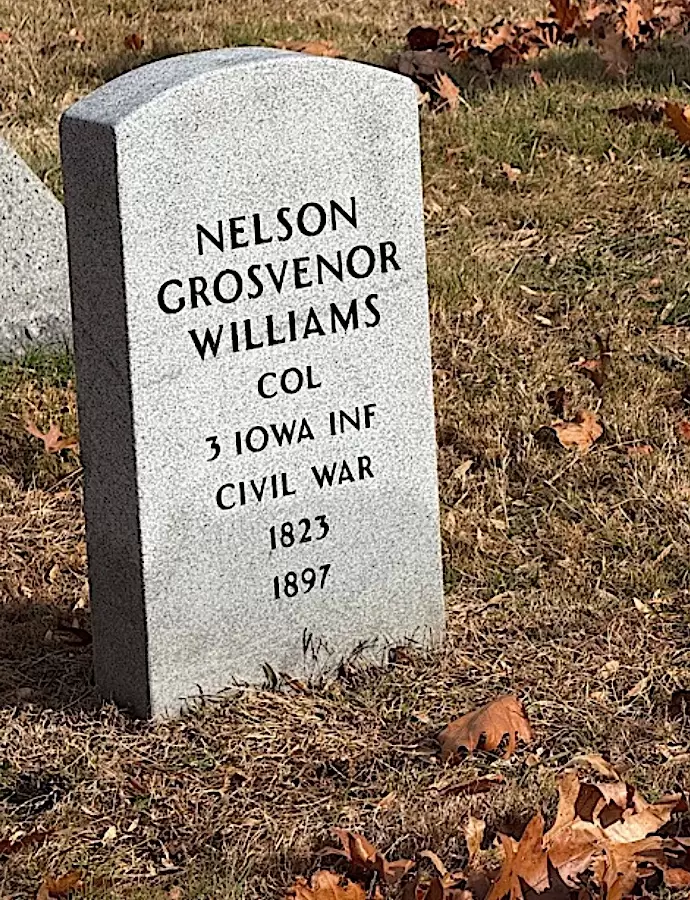
WILLIAMS (or WILLIAM), SAMUEL L. (1842-1919). Private, United States Marine Corps. Williams, a New Jersey native, served as a private in the United States Marine Corps during the Civil War. As per the 1875 New York State census, he was living at 679 Fifth Avenue in Brooklyn in a brick house with a value of $8,000, and was employed as a milk dealer. Williams applied for and received an invalid pension from the United States Navy in 1907, certificate 35,187; the pension was increased in 1917 and again in 1918. The 1910 census indicates that he was a street laborer living with his wife and two adult children in their 30s who were both working. His obituary in The New York Times confirms that he was a Civil War veteran. He last lived at 8 Raleigh Place in Brooklyn, the same address as recorded on the 1910 census. After his death in 1919, Sarah Williams received a widow’s pension from the Navy. Section 154, lot 2333.
WILLIAMS, SENECA DEAN (1845-1888). Private, 98th New York Infantry, Company B. A native of Pleasant Valley, New York, Williams was living in Fishkill, New York, at the time of the 1860 census. During the Civil War, he enlisted as a private at Fishkill on January 11, 1864, and mustered immediately into the 98th New York. As per his muster roll, he was a laborer who was 5′ 7″ tall with blue eyes, light hair and a light complexion. He mustered out with his company on August 31, 1865, at Richmond, Virginia. The 1888 New York City Directory indicates that he was employed as a foreman. He last lived on Dongan Street in West New Brighton, Staten Island. Section 2, lot 5499, grave 1515.
WILLIAMS, WILLIAM (1840-1880). Private, 4th New York Light Artillery; 5th New York Light Artillery. Born in Norway, he enlisted as a private at New York City on October 8, 1861, the same date that he mustered into the 4th New York Light Artillery. He transferred into the 5th Light Artillery on December 12, 1863, from which he was discharged. His last address was 53 East 112th Street in Manhattan. Section 190, lot 23160.
WILLIAMS, WILLIAM (1843-1894). Corporal, 146th New York Infantry, Company I; private, 5th New York Infantry, Company D. Williams was born in Ireland. His death certificate notes that he lived in the United States for 42 years, suggesting that he immigrated when he was about nine years old.
During the Civil War, he enlisted as a private on August 8, 1862, and mustered immediately into Company D of the 5th New York Infantry. As per his muster roll, he was a hatter who was 5′ 7″ tall with blue eyes, light hair and a light complexion. He was transferred to Company I of the 146th New York on May 4, 1863, and promoted to corporal on an unknown date. On May 5, 1864, he was wounded by shell fragments in the left leg below the knee and captured at the Battle of the Wilderness, Virginia. Williams was then confined at Andersonville and Florence Prisons before he was paroled at Savannah, Georgia, on November 30, 1864. After being treated at a hospital at Annapolis, Maryland, he returned to duty on May 8, 1865, and mustered out near Alexandria, Virginia, on June 3, 1865.
In 1892, Williams lived at 102 Clymer Street in Brooklyn. As per his death certificate, Williams was a widower and hatter by trade who last lived at 601 Grand Avenue in Brooklyn. He succumbed to fibroid phthisis and exhaustion. Section A, lot 8998, grave 102.
WILLIAMSON, JAMES BURDEN (1825-1912). Acting master mate, United States Navy. Originally from Kingston, New York (although the Green-Wood database says Belfast, Northern Ireland), Williamson enlisted in the United States Navy on May 2, 1861, as an acting master mate on the USS Wabash. At that time, he was a seaman, 5′ 7″ tall with blue eyes, light brown hair and fair complexion. He then served on the USS Hope and the USS Roanoke. Subsequently, he was assigned to duty on board the USS Vermont with Admiral Dupont but on February 25, 1863, was dismissed for continuous drunkenness and neglect of duty. He continued to serve as a petty officer until his enlistment expired in June 1864 when he re-enlisted and served on board the USS Juniper as part of the Potomac River patrol from 1864 to 1865.
Continuing in the Navy after the War, Williamson was onboard the Osceola until September 4, 1867. He re-enlisted on October 18, 1867, was assigned to the USS Tuscarora and discharged at Key West, Florida, on November 16, 1870. He continued as a seaman on the steamship Cortez in New York Harbor when, in June 1872, he suffered an accidental fall from the forecastle of the ship to the main deck fracturing his left thigh. After his discharge, he returned to Kingston, New York, then lived in Belfast, Northern Ireland, at the time he applied for a pension in 1891 which was granted under certificate 29,101. Williamson reapplied for a pension in 1907, living the Sailors’ Home in Snug Harbor, Staten Island, as of 1900. His pension totaled $20 a month. Section A, lot 9146, grave 114.
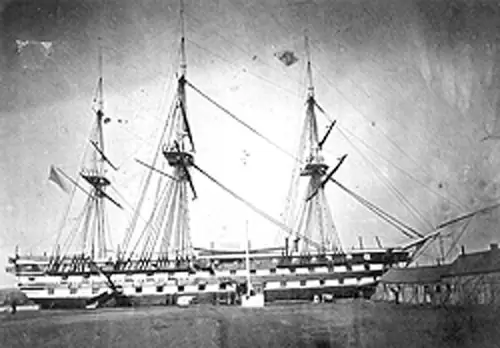
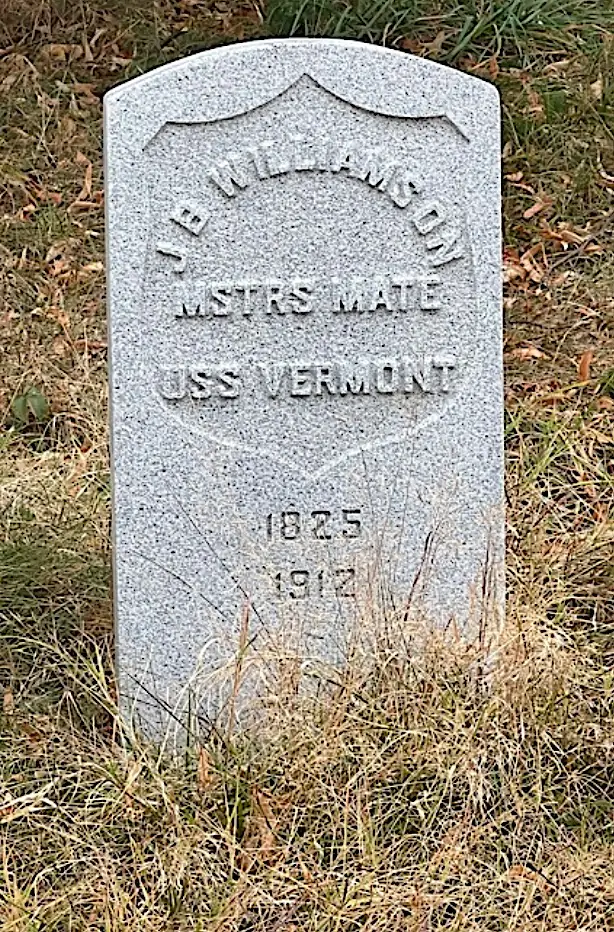
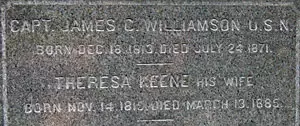
WILLIAMSON, JAMES C. (1813-1871). Commander, United States Navy. Williamson, who was born in New Jersey, joined the Navy as a midshipman on January 7, 1832, and was attached to the Mediterranean Squadron on board the Brandywine in 1833 and the Constellation in 1834. After his assignment on the Ontario in the Brazil Squadron in 1836, he attended the New York Naval School from 1837-39 and was promoted to passed midshipman on July 8, 1839. When his stint at the New York Navy Yard ended in 1840, he was on the receiving ship New York from 1841-44. He rose to lieutenant on November 25, 1844. Williamson then was assigned to the Vincennes in the East India Squadron from 1846-9, the Brazil Squadron from 1849-51, the Home Squadron from 1852-53, and returned to the East India Squadron from 1855-8.
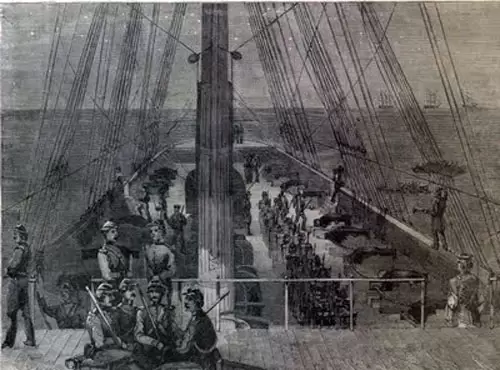
An executive officer on the steam-sloop Brooklyn in 1861, Williamson was commissioned commander on April 15, and took charge of the landing of troops at Fort Pickens, Florida, that year. The commander of the Penguin in the East Gulf Blockading Squadron in 1862-63, he then was at the helm in the South Atlantic Blockading Squadron from 1864-65. In 1866, he was on special duty at New Orleans, Louisiana, attained the rank of captain on October 10, 1866, and then served at the Boston Navy Yard from 1868-69. His last home was at 252 Grove Street in Jersey City. His death was attributed to cancer. Section 73, lot 3513.
DISEMBARKING THE TROOPS FROM THE U. S, SHIP “BROOKLYN” TO REINFORCE FORT PICKENS, APRIL 13, 1861. [SKETCHED BY AN ENGINEER OFFICER ON BOARD.]
WILLIAMSON, JOHN W. (1819-1871). Private, 95th New York Infantry, Companies H and F. Of Irish origin, he enlisted on October 12, 1861, at New York City, as a private. After mustering into Company H of the 95th New York on November 1, 1861, he was transferred into Company F on January 25, 1864, returned to Company H on April 15, 1864, and was discharged on October 12 of that same year. He last lived in New York. Section 17, lot 17245, grave 40.
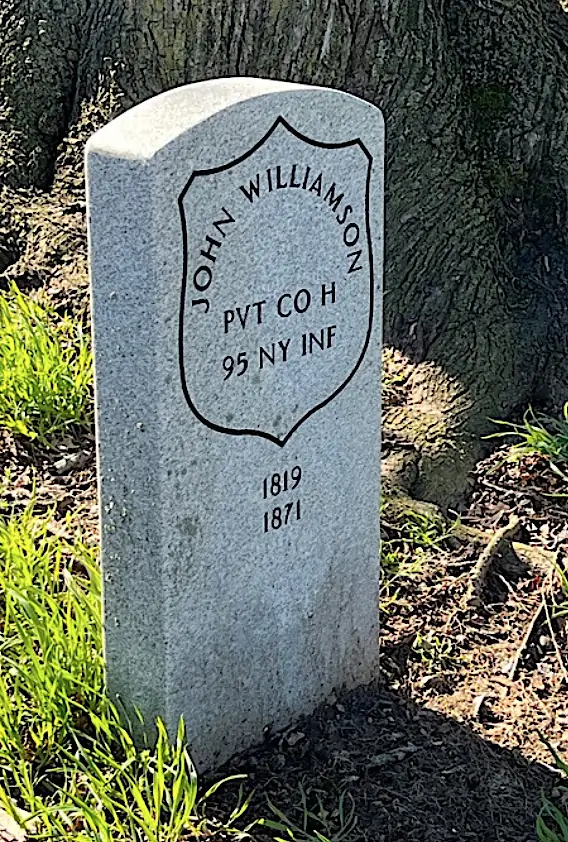
WILLINGTON, GEORGE (1835-1869). Sergeant, 20th New York Cavalry, Companies A and T; private, 14th New York Infantry, Company F. A New York State native, Willington first served in the 14th New York but the details of that enlistment are unknown. He re-enlisted as a private at Turin, New York, on August 12, 1863, and mustered into Company A of the 20th New York Cavalry on September 3. He was promoted to corporal and sergeant before being reduced to ranks on June 1, 1865. After being transferred to Company T five days later, he mustered out on July 31, 1865, at Manchester, Virginia. His last address was 59 Hicks Street in Brooklyn where he died from consumption. Section 178, lot 12941.
WILLIS, JOHN (1844-1922). Private, 18th New York Cavalry, Company F. On January 11, 1864, Willis enlisted as a private at New York City and mustered into the 18th New York Cavalry. He deserted at Camp Stoneman, Virginia, on February 5, 1864. His last residence was on Cumberland Street in Brooklyn. Section 135, lot 30010, grave 581.
WILLISTON, CHRISTOPHER L. (1843-1899). Private, 12th Vermont Infantry, Company I. Born in Rockingham, Vermont, where he was living at the time of the census of 1850, Williston enlisted as a private on October 4, 1862, and mustered into the the 12th Vermont. He mustered out at Brattleboro, Vermont, on July 14, 1863. He last lived at 231 Berkeley Place in Brooklyn but died of softening of the brain in Philadelphia, Pennsylvania. Section 199, lot 30303.
WILLSON, A. DUNCAN (1836-1873). Surgeon, 23rd Regiment, New York State National Guard. A native New Yorker, Willson enlisted at Brooklyn as a surgeon on June 18, 1863, and was commissioned into the 23rd Regiment’s Field and Staff the same day. He mustered out on July 22, 1863, at Brooklyn. His last residence was at 4 Gates Avenue in Brooklyn. Duncan’s death was caused by kidney disease. Section 168, lot 18334.
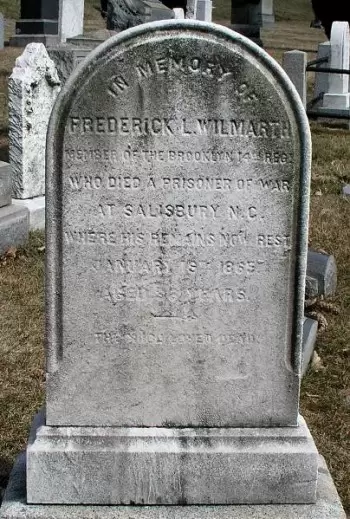
WILMARTH, FREDERICK L. (or D.) (1828-1865). Private, 84th New York (14th Brooklyn) Infantry; 5th New York Veteran Infantry, Company I. Wilmarth is not buried at Green-Wood; a cenotaph honors his memory and service. He enlisted and mustered into the 14th on February 16, 1864, at Brooklyn, and transferred to the 5th New York Veterans on June 2, 1864. The cenotaph reads, “In memory of Frederick L. Wilmarth, member of the Brooklyn 14th Reg. who died a prisoner of war at Salisbury, N.C., where his remains now rest. January 18, 1865. Aged 36 years.” Section 106, lot 10731.
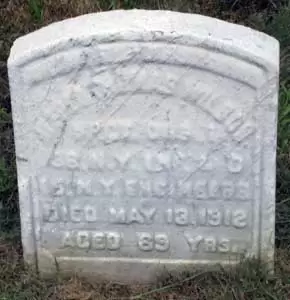
WILSON, ALFRED THOMAS (or J.) (1843-1912). Sergeant, 15th New York Engineers, Company D; private, 36th New York Infantry, Company I. On November 11, 1861, the English-born Wilson enlisted as a private at New York City and mustered into the 36th New York. He mustered out on July 15, 1863, at New York City. On August 17, 1863, he re-enlisted at New York City as a private and mustered into the 15th New York on October 3. He was promoted to artificer on October 15, 1863, to corporal on February 1, 1864, and to sergeant on January 26, 1865, and mustered out on July 2, 1865, at Washington, D.C.
As per his obituary in the Brooklyn Daily Eagle, Wilson was a member of the Ulysses S. Grant Post #327 of the G.A.R.; comrades were invited to attend his funeral. He last resided at 339 Gates Avenue in Brooklyn. Section 194, lot 31155.
WILSON, CHARLES FREDERICK (1848-1914). Private, 13th Connecticut Infantry, Companies K and C. Wilson enlisted as a private at Marlborough, Connecticut, on December 26, 1863, and mustered into Company K of the 13th Connecticut on that same day. On October 19, 1864, he was wounded in action at the Battle of Cedar Creek, Virginia. He was transferred intra-regimentally into Company C on December 12, 1864. After being taken as a prisoner of war at some point, he was held at the infamous Andersonville Prison in Camp Sumter, Georgia, for seven months. He was discharged on August 12, 1865.
After the Civil War, Wilson was dealer in hay, grain, and feed. He was also a member of the Tefft Post #355 of the Grand Army of the Republic, the Royal Arcanum of Brooklyn, and the Association of Prisoners of War. In 1885, he applied for and received an invalid pension, certificate 1,049,493. A Freemason, he last lived at 541 Classon Avenue in Brooklyn. Emilie Wilson applied for and received a widow’s pension in 1916, certificate 836,489. Section 204, lot 29568, grave 21.
WILSON, CONRAD (1848-1913). Corporal, 22nd New York Cavalry, Companies I and M. Originally from Norway, Wilson enlisted on January 15, 1864, as a private, at Rochester, New York. On February 2, he mustered into Company I of the 22nd New York Cavalry and was promoted to corporal on March 15 effective upon his transfer that day to Company M. He mustered out on May 28, 1865, at Winchester, Virginia. His application for an invalid pension was granted in 1899, certificate 1,145,383. Wilson’s last residence was 77 West 89th Street in Manhattan. Nickoline Wilson, who is interred with him, applied for and received a widow’s pension in 1913, certificate 756,928. Section 123, lot 134495, grave 2.
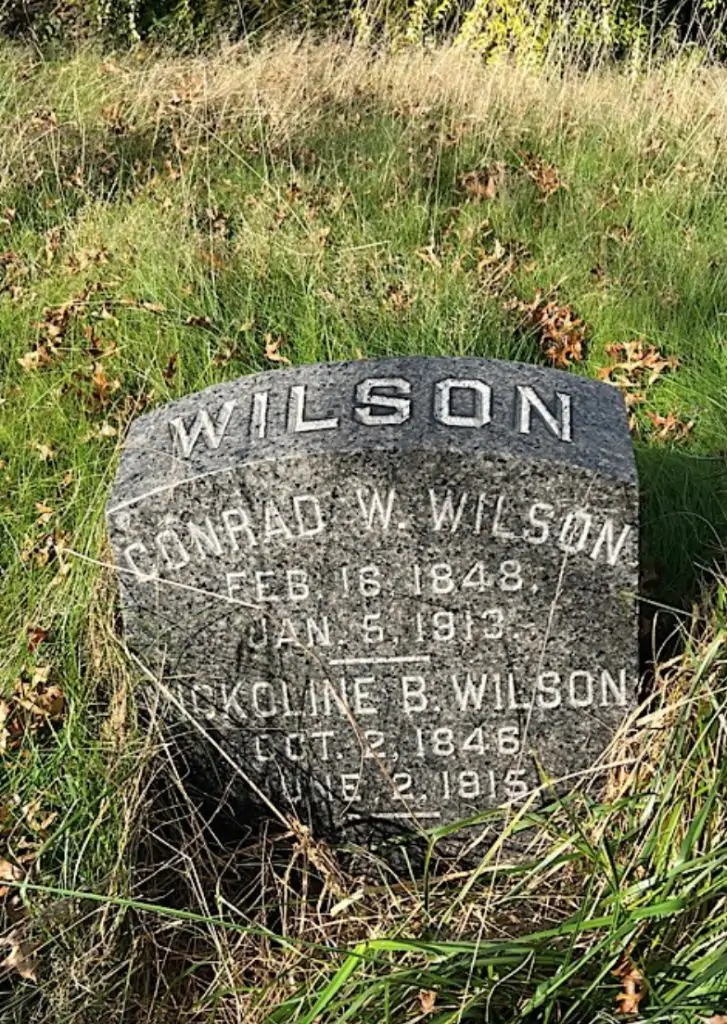
WILSON, DAVID W. (1837-1898). Private, 8th Regiment, New York State Militia, Company K. A native New Yorker, Wilson served in the 8th New York State Militia for three months in 1861. For 30 years he was a successful businessman and head of the Wilson Brothers’ Woodenware and Toy Company on Chambers Street in Manhattan. A past commander and founding member of the George C. Strong G.A.R. Post #534 in Brooklyn, he organized the group’s yearly Memorial Day exercises.
Wilson’s death on May 30, 1898, was caused by a self-inflicted gunshot wound to the head, a suicide believed to have been related to undiagnosed head pains suffered during the last year of life. An article about his death in the Brooklyn Daily Eagle, which confirms his Civil War service, noted that he and other members of the Strong Post were at Green-Wood Cemetery that day decorating graves of fallen soldiers and that he returned home at about 5:00 p.m. planning to attend church services with other post members. However, his wife heard a pistol shot and found Wilson sitting in a chair with a bullet wound to his right temple. The article reports that he never consulted a doctor about the severe head pains that afflicted him, believing they would go away. The writer of the piece suggested that the excitement of the Memorial Day tributes might have caused his mind to become unbalanced; his business was doing well and he had no apparent family troubles. He last lived at 381 Greene Avenue in Brooklyn. Section 179, lot 14420.
WILSON, EDWARD R. (1835-1900). Quartermaster, 5th Regiment, New York State National Guard, Company A. A native of New York City, Wilson enlisted as a private on June 19, 1863, mustered into the 5th National Guard, also known as the Jefferson Guard, on July 5, was commissioned into the Field and Staff as a quartermaster, and mustered out on July 22 after his term of 30 days expired. The census data from 1870 and 1880 indicated that he was “at home” in the column where one’s occupation is listed. Section 33, lot 8859, grave 13.
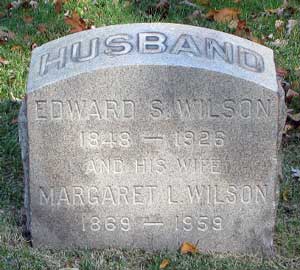
WILSON, EDWARD S. (1848-1926). Private, 51st New York Infantry, Company B. Enlisting on February 23, 1864, as a private at Brooklyn, his birthplace, he mustered that day into the 51st New York. He mustered out on July 25, 1865, at Alexandria, Virginia. His last address was 1360 St. Marks Avenue in Brooklyn. Section 168, lot 17735.
WILSON, GEORGE (1839-1908). Rank unknown, United States Navy. During the Civil War, Wilson served in the Navy. He was secretary of the Chamber of Commerce of New York State from 1868-1908. Section 106, lot 10084.
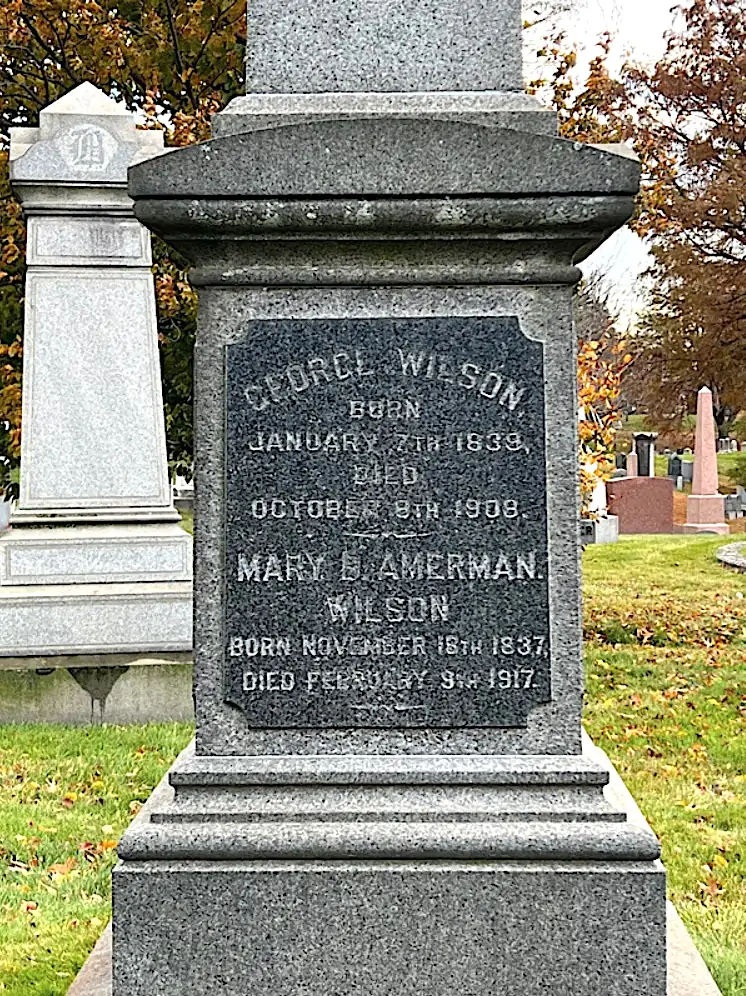
WILSON, HENRY A. (1838-1909). Private, 71st Regiment, New York State Militia, Company E. After enlisting in 1861, Wilson served for three months with the 71st Regiment when it was activated that year. In 1890, his pension application was granted, certificate 1,072,309, as was that of his widow, certificate 688,541. He last lived at 203 West 95th Street in Manhattan. Section 138, lot 24920, grave 1.
WILSON, HENRY B. (1824-1876). First sergeant, 127th New York Infantry, Company D. Born in Denmark, he enlisted on July 24, 1862, at New York City, as a sergeant. On September 8, he mustered into the 127th New York, was promoted to first sergeant of his company on January 21, 1865, and mustered out on June 30, 1865, at Charleston, South Carolina. His last residence was in New York City. Section 115, lot 4196, grave 360.
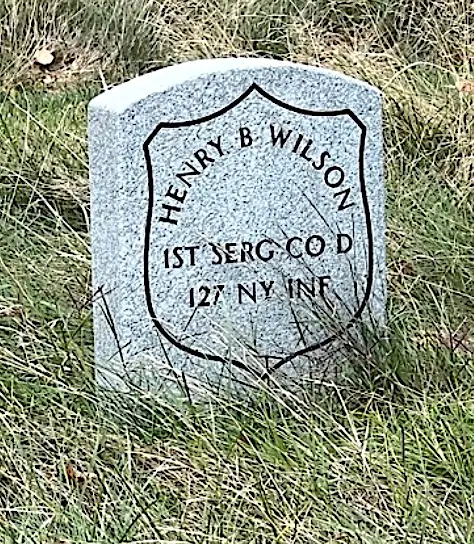
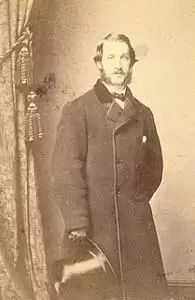
WILSON, HENRY SUYDAM (1840-1908). Private, 7th Regiment, New York State Militia Infantry, Company H. A New York City native, Wilson enlisted as a private at New York City in 1861 and served for 30 days in the 7th Regiment, New York State Militia, mustering in on April 30, 1861.
On December 12, 1864, Wilson became a member of the New York Stock Exchange and served many terms on its Governing Committee. His business was located at 66 Broadway in Manhattan. According to his obituary in The New York Times, he was also a member of the Chicago Stock Exchange and was on the Board of Managers of Presbyterian Hospital in New York City. Among the many organizations to which he belonged included the Union League, the New York Athletic Club, the St. Nicholas Society and the 7th Regiment. His last residence was 31 East 69th Street in Manhattan. Section 10, lot 4089.
WILSON, JOHN (1820-1871). Private, 174th New York Infantry, Company I; 162nd New York Infantry, Company I. Born in Scotland, Wilson enlisted on October 20, 1862, at New York City, and mustered into the 174th as a private two days later. On February 17, 1864, he transferred into Company I of the 162nd New York as a private and was discharged on an unknown date. His last residence was 4 Spring Street in Manhattan. Section ?, lot ?.
WILSON, JOHN W. (1841-1904). Corporal, 22nd Regiment, New York State National Guard, Company D. A New York City native, he enlisted there as a private on May 28, 1862, mustered immediately into the 22nd Regiment, and mustered out after three months on September 5 at New York City. In 1863, he returned to his regiment and company as a corporal and served for its 30-day activation.
On March 5, 1887, Wilson joined G.A.R.’s Col. James Monroe Post #607 in New York City. According to his obituary in The New York Times, he was the head of an importing and exporting firm that bore his name at 52 Front Street in Manhattan that traded with Mexico and the West Indies. He was a member of the New York Chamber of Commerce, a director of the Atlantic Mutual Insurance Company, and belonged to the Montauk Club. He last resided at 62 Eighth Avenue in Brooklyn. Section 148, lot 20805, graves 8 and 9.
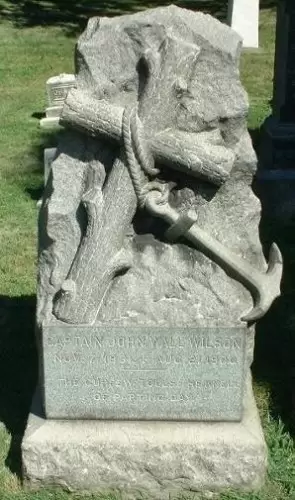
WILSON, JOHN WAIL (1831-1900). Captain, United States Navy. Born in Maine, he was a graduate of the United States Naval Academy at Annapolis. In 1853, he was one of few survivors of a perilous and fruitless expedition to Greenland’s arctic terrain organized by Dr. Kane to search for Sir John Franklin, an explorer who was trying to chart and navigate a section of the Northwest Passage. That three year mission left from the Brooklyn Navy Yard and was often adrift or frozen in ice floes.
In the Civil War, Wilson served with Admiral Farragut, was promoted to captain, and took a prominent part in the storming of New Orleans, Louisiana. After the War, he resigned from the Navy, became an active member of the Arctic Club, and spent summers in New Hampshire, where his son ran a summer camp for young men. He died at St. John’s Hospital in Brooklyn but last lived in East Hebron, New Hampshire. Section 161, lot 13650, grave 11.
WILSON, THOMAS (1850-1877). Midshipman, United States Navy. Of Irish birth, Wilson joined the Navy as a midshipman on September 20, 1861. After his graduation in October 1865, he rose through the ranks becoming an ensign on December 1, 1866, a master on March 3, 1868, and a lieutenant on March 26, 1869. He retired on August 2, 1873. He last lived in New York City. Section 34, lot 7871.
WILSON, WILLIAM (1845-1864) Relief agent, United States Sanitary Commission. A 19 year-old relief agent of the United States Sanitary Commission, Wilson died from a wound while aboard the S.E. Brown on the James River; a ball struck through his right ilium, entering his peritoneal cavity, as per his obituary in the New York Herald. In the Sanitary Commission letter of condolence to his parents, it noted that he was probably their youngest agent and although he was thought at first as being too young to serve, he was accepted because of his great appreciation of his proposed duties.
A report of the Sanitary Commission noted that Wilson, a mere boy, had done a hero’s work in ministering to the wants of the wounded. That report indicated that the steamer, on which he was mortally wounded, flew the flag of the commission, but nevertheless was attacked by Confederate guerillas concealed on the shore. “He fell a victim to that barbarous policy of the enemy, which always refused to recognize as entitled to immunity and protection those who were not only non-combatants, but those who had always proved the best friends of their own helpless wounded when the fortunes of war placed them in our hands.”
Another note on August 4, 1864, announcing the aforementioned attack, observed that the relief agents were on the Brown on a trip to escape the heat. On the ship were 20 relief agents, three ladies and a number of invalid soldiers. They were attacked about seven miles from City Point, Virginia, beyond the protection of Union gun boats; the boat engineer also was killed and two relief agents were seriously wounded.
The Sanitary Commission stated that Wilson did not disappoint their expectations and that “the record he made for himself in a good work may well be a consoling thought to his parents and friends in this great bereavement.” Active members of the B.B.C. and friends and family were invited to his funeral at the Third Reformed Presbyterian Church at West 23rd Street and Eighth Avenue. He last lived at 68 Grove Street in New York City. Section 73, lot 887.
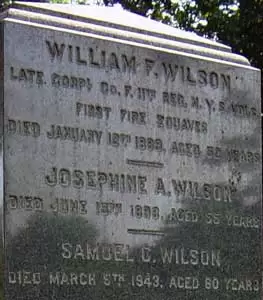
WILSON, WILLIAM F. (1837-1889). Corporal, 11th New York Infantry, Company F. A native of New York City, Wilson enlisted there as a corporal on April 20, 1861, and mustered into the 11th New York on May 7. On July 21, 1861, he was taken prisoner of war at the Battle of Bull Run, Virginia. He was confined at Richmond, Virginia, on July 23, 1861, and paroled. He mustered out on June 2, 1862, at New York City. On September 5, 1862, he applied for an invalid pension that was granted, certificate 113,025. He last lived on Third Avenue in Manhattan. His widow received a pension after his death, certificate 288,637. Section 109, lot 9440.
WINCHELL, JOHN (1846-1893). Musician, 61st New York Infantry, Companies H, G, and B. He enlisted as a private at New York City on August 26, 1861, mustered into Company H of the 61st on September 5, 1861, and was promoted to musician on November 1, 1862, upon his transfer to Company G. During his service, he re-enlisted on December 21, 1863, was reduced to ranks, and was transferred to Company B. While on furlough in 1864, he deserted at the expiration of his leave on November 10, 1864. His last residence was 502 Clinton Street in Brooklyn. Winchell died of pneumonia. In 1894, his widow, Dulcenia Winchell, applied for a pension, application 589,476. Section 116, lot 4073, grave 13.
WINCHESTER, BENJAMIN FRANKLIN (1828-1865). Captain and commissary, United States Volunteers Commissary Department. Winchester, who was born in Vermont, enlisted as a captain on July 17, 1862, and was commissioned that day into the United States Volunteers Commissary Department as a captain and commissary. He was dismissed on April 9, 1865, and died a month later of typhoid fever at Fort Foote, a seacoast fortification on the Potomac River in Maryland. He likely was the brother of Locke Winchester (see). He was buried at Green-Wood Cemetery on May 21, 1865, with full military honors. His widow, Frances Winchester, applied for a pension soon after his death that was granted under certificate 89,831. Section 120, lot 787.
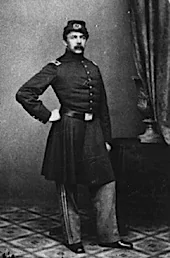
WINCHESTER, LOCKE W. (1824-1895). First lieutenant and quartermaster, 7th Regiment, New York State Militia. Born in Woodstock, Vermont, he enlisted as a first lieutenant at New York City on April 17, 1861, was promoted on that date to first lieutenant and quartermaster, and was commissioned into the 7th Regiment nine days later. Winchester mustered out at New York City on June 3, 1861. He likely was the brother of Benjamin Franklin Winchester (see).
An article in the January 10, 1890, edition of the New York Herald describes an open house for close to 2,000 members and friends of the 7th Veterans at their club house at Fifth Avenue and 58th Streets in Manhattan; Winchester (referred to as Colonel Winchester) was the president of the 7th Veterans at time of that event. As per his obituary in the New York Herald, he was a member of the 7th Regiment Veterans, the Union League and the Lafayette Post #140 of the G.A.R.; members of those organizations were invited to attend his funeral at Trinity Church. His last residence was in New York City where he died of heart disease. Section 120, lot 787, grave 18-19.
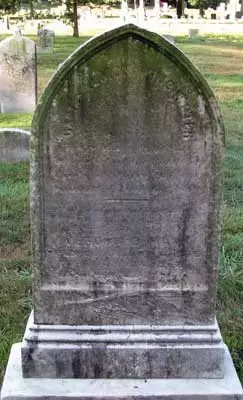
WINCHESTER, SALMON (or SOLOMON) (1830-1862). Captain, 10th New York Infantry, Company F. Born in Westmoreland, New Hampshire, he left for New York City at the age of 14 and became an apprentice in the printing business for his uncle who was a book publisher. He soon enlisted in the Army, but his father secured his release because he was a minor. Returning to New Hampshire, he worked for the Winchester Gazette and then moved to Upton, Massachusetts, where he founded the Upton Mechanics’ Temperance Society. He is listed as a printer in the 1858 Brooklyn Directory.
During the Civil War, Winchester enlisted as a captain at Brooklyn, where he resided at 262 Myrtle Avenue, on April 26, 1861, and was commissioned into the 10th New York four days later. He commanded Companies H and C of the 10th New York and a detachment of the 99th New York Infantry at the skirmish at Fletcher’s Wharf at Pocomoco, Virginia. Subsequently, he took command of the 10th on December 13, 1862, at Fredericksburg, Virginia, after Colonel John Bendix (see) was wounded, until he himself was wounded that day by a gunshot that severely mangled his leg. Standing up to face the enemy, he reportedly said, according to an obituary, “It’s time enough for me to lie down when they knock me down.” He died of his wounds three days later at Falmouth, Virginia. Post #197 of the Grand Army of the Republic was named in his honor. A special service was held at his grave in Green-Wood on May 30, 1882, by the members of the Salmon Winchester Post, G.A.R., with the address given by Captain Thomas D. Mosscrop (see). Section 59, lot 1420, grave 33.
WINDUST, EDWARD (1798-1877). Restaurateur and witness to the New York City Draft Riots of 1863. Born in England, he came to New York as a young boy and first set up business on Pine Street in Manhattan and then opened a restaurant called “Ed’s Eating House” on Chatham Street (now Park Row) where many famous people dined including Robert E. Lee and Horace Greeley. His establishment, decorated with theatrical memorabilia, was considered the most celebrated eating house of its time and was a popular gathering place in lower New York. Among the specialties for noon-time dinners were English mutton shops, rare roast beef and oysters.
On July 13, 1863, the first day of the New York City, Draft Riots, roving mobs attacked Mayor George Opdyke’s house, the home of the postmaster general, the building that housed The New York Times, and the homes of many leading Republicans. When the New York Tribune office was attacked at dusk that day, it was saved by fast actions of the New York City Police Department who routed the hooligans. Horace Greeley, the Tribune’s editor, was said to have taken refuge from the attacks in Ed Windust’s restaurant, allegedly hiding under his office desk until the mob passed and two armed men escorted him home. It was reported that no harm came to Mr. Greeley. When the riot was over and order restored an article was written in the Tribune adding controversy to the story by headlining “At No Time did Mr. Greeley Hide Under a Table in Ed Windust’s Eating House,” and “Anybody Stating that is a Liar and Villain.” According to the Tribune, Greeley was at his summer home in Chappaqua, New York. (In Windust’s obituary in The New York Times, mention was made of this urban legend of its day but concluded that Greeley was at the establishment but did not hide there.)
Subsequently, Windust sold his restaurant, and it was moved to the United States Hotel, at Water and Fulton Streets, where it remained for many years catering to actors, artists, musicians, newspaper reporters, and the bohemian set of that era. A Freemason, he last lived in Babylon, Long Island. Section 48, lot 6106.
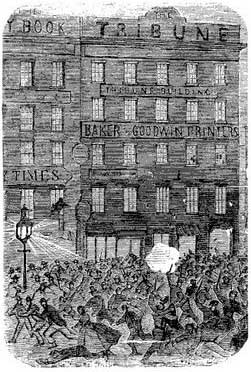
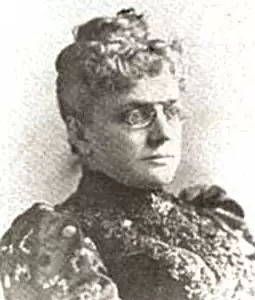
WING, AMELIA KEMPSHALL (1837-1927). Secretary and treasurer of Newark, Ohio, Soldiers’ Aid Society. Born in Rochester, New York, to a wealthy family, she was educated at the Wyoming and Middlebury Academies and at Ingham University. At age 16, she taught public school in Brooklyn, then relocated to Newark, Ohio, at age 20 when she married. On October 11, 1861, she answered the call to an advertisement in the Newark, Ohio, Advocate calling for women to meet the next day at the city hall to organize a Soldiers’ Aid Society, an association that “will do much service relieving the wants and sufferings of the neighbors and friends who go from among us to serve their country on the battlefield.” Wing was elected secretary and treasurer of that group, an arm of the Sanitary Commission. Within a month, boxes filled with gloves, mittens, socks, underwear, shirts and blankets were being sent to soldiers in Captain Leonidas McDougal’s Company H of the 3rd Ohio. In addition, 75 straw mattresses were sent to the 76th Ohio Regiment.
Over the next two years, the Society sent goods to the field, to the Columbus, Ohio, Soldiers’ Aid Society and to the Relief Association in Washington, D.C., vowing to be in existence to aid soldiers of Licking County, and the poor “so long as the ladies of Newark weary not of well-doing.” Hospital supplies were also sent to the Cincinnati Sanitary Commission for distribution. The Newark Soldiers’ Aid Society held a Continental Supper in May 1862, and through 1863 sent many goods including dried fruit, jelly, brandy, catsup and wine to soldiers. The group held other fund-raisers; its most successful raised $500 in November of 1864.
Returning to Brooklyn at some point, Wing continued her charitable work, chairing the executive committee of Maternity Hospital and, in 1886, was elected president of the Brooklyn Women’s Club, a position she held for five years. In addition, she wrote about the “Coming Woman” and other poems and hymns. According to her obituary in the Brooklyn Daily Eagle, she traveled extensively and spent time in California in 1891. Active in many organizations during her lifetime, Wing was president of the Benevolent Society of the Lafayette Avenue Presbyterian Church for five years, recording secretary of the Home for Consumptives for four years, chair of the board of directors of the Brooklyn Maternity center for four years, and president of the Home Missionary Society of the Plymouth Church for seven years. She was the honorary president of the Women’s Guild of Plymouth Church in April 1914 and was honorary president of the Brooklyn Woman’s Club at the time of her death. She died at the Congregational Home for the Aged after a week’s illness. Section 174, lot 20365.
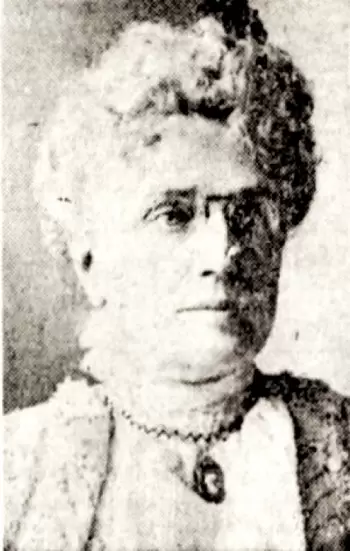
WINSER, HENRY JACOB (1823-1896). First lieutenant, 1st New York Infantry, and journalist. Born in Bermuda where his father was an officer in the British Navy, Winser was educated at the Springfield Academy there. He came to New York City in 1851 and went to work in the printing industry. He later joined The New York Times as a proofreader and became a member of its city staff.
During the Civil War, Winser served as a first lieutenant in the 1st Regiment, New York Fire Zouaves. As per his obituary in The New York Times, he accompanied Colonel Ephraim E. Ellsworth as his military secretary and was with Ellsworth when he died at Alexandria, Virginia. After a short tour, he returned to The Times as a war correspondent, covering the expedition to Port Royal, South Carolina, in 1861, wrote the first description of the 1862 bombardment of New Orleans, Louisiana, published in the North, and reported on the Battle of Cold Harbor, Virginia, in 1864.
The Brooklyn Directory for 1863 lists Winser as a reporter; the 1865 Brooklyn Directory indicates that he was an editor. He headed the city bureau of The Times 1867-69, and was the day manager of the editorial department. His obituary notes that The Times sent Winser to the Paris Exposition of 1867 as its correspondent. He was appointed as United States Consul to Sonneberg, Germany, from 1869-81, then worked as chief of the information bureau of the Northern Pacific Railroad. When Henry Willard retired from the Northern Pacific Railroad, Winser returned to journalism first serving as assistant editor of the New-York Commercial Advertiser and then as managing editor of the Newark Advertiser. After retiring from the newspaper business, he devoted himself to literary pursuits. He last lived on Washington Avenue in Newark, New Jersey. He died of acute nephritis. Section 50, lot 9048.
